Southlands: Adventures Beneath the Pitiless Sun by Libertad!
Introduction
Original SA post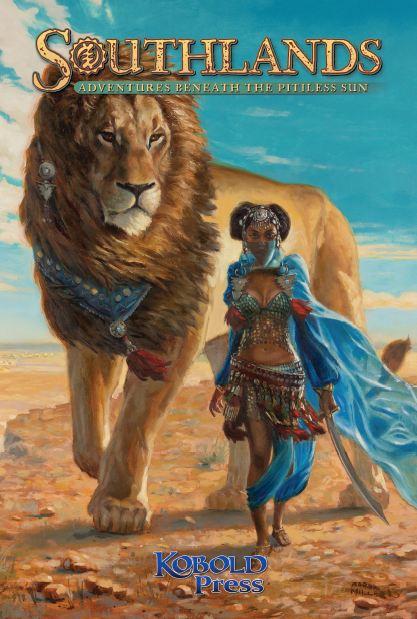
Hard to believe it’s been half a year since my last Let’s Read, but here I am back in the swing of things! Like my last two projects, I chose a book of which I am passionate about : the Southlands Campaign Setting.
The Southlands is a sort of “setting expansion” to Kobold Press’ Midgard: a thematic blend of Ancient Egypt, the Arabian Nights, and various fantasy counterpart sub-Saharan African kingdoms ranging from antiquity to the Early Modern period. There are also some pulpy tropes such as lost temples of prior civilizations, but is thankfully absent of “evil primitive natives to kill and loot” trope. The Southlands began as a KickStarter in late 2014 and soon grew to be one of the most-backed crowdfunded Pathfinder books with nearly $100k raised. At times it ranked as one of the most popular Pathfinder settings by Drive-Thru RPG sales figures for years, usually eclipsed only by the main Midgard Setting, Ponyfinder, and some other hot sourcebooks of the month. It is one of the few d20 products which goes for a Fantasy Africa vibe as a central setting, and its high production values combined with comprehensive research on the writers’ part make it a unique gem shining among 3rd party worlds.
Note:The Southlands Campaign Setting, unlike the Midgard Worldbook, is exclusively Pathfinder in its mechanics, but several supplements such as Southlands Heroes and a few adventure serials imported material from it to 5th Edition. For those familiar with my last review I should also note that its publication was 3 years before the Worldbook which updated the Midgard setting by 10 years. Thus, certain details such as the Nurian alliance with the Seven Cities against the Mharoti have not yet been undertaken.
Welcome to the Southlands
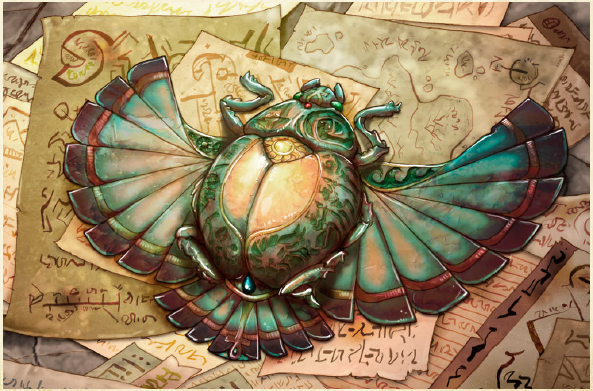
The Southlands’ prologue opens up with Seven Secrets of the Southlands in a similar vein to the Midgard Worldbook: important setting elements which emphasize what to expect from the land and what makes it different from other settings on the market.
[LIST=1]
[*]A Vast Continent: The Southlands is a huge landmass well over 2,000 miles long from north to south. The continent teems with all manner of forbidding lands, diverse nations and city-states, and lost legacies of prior civilizations. Long-term journeys matter even more than the destination.
[*]Land of Endless Actions: The Southlands hews more for a pulpy adventure and Fantasy Africa feel in contrast to Midgard’s traditional Ye Old Medieval fantasy. Emphasis is placed on lost wonders, secret conspiracies plotting against each other, and fast-paced action and plot twists.
[*]Ancient Powers: The Southlands is home to larger-than-life entities of godlike power who shaped the fate and reach of civilizations. Three of note are highly detailed: the former titan empire of Glorious Umboso which once ruled the majority of the continent; the still-living Wind Lords who hold dominion over most of the northern deserts; and the living gods of Nuria Natal who regularly physically manifest and meddle in the affairs of their mortal subjects.
[*]Divine Sparks for the Taking: Not even the divine lasts forever, but their legacies persist in the annals of history. Gods, titans, and other supreme beings have an internal force known as a “spark” which normally dissipates upon their death. But sometimes it lingers on, sealed in sacred vessels or tombs or even claimed by beings seeking great power.
[*]New Cultures and Altered Races: The Southlands is in the same realm as Midgard, and includes a few of said setting’s races such as minotaur and ravenfolk albeit with altered cultural mores. For example, ravenfolk are often associated with the Nurian gods Horus. But aside from humans and dwarves, the “traditional” fantasy races are done away with in favor of five playable new ones along with minor regional races.
[*]History Reborn: The Southlands is ancient, having gone through numerous empires and dynasties which rarely remain buried in the past. From mummified god-kings who raise from the dead to defend their nation to discovered relics, the past affects the present in ways both metaphorical and literal.
[*]Unfolding Plots and Expanding Conflicts: The cultures and nations of the Southlands are rarely stagnant, and even old kingdoms’ borders can shift from invasions, raids, and politicking. Bandits and cults are lower-scale yet just as dangerous, whose evil designs can spell doom to communities.
[/LIST]
I feel that a few of these points aren’t exactly novel or unique, but I do particularly enjoy the concept of divine sparks (which actually have game mechanics by using the Mythic Adventures system) as well as the overall avoidance of simply replicating the dwarf/elf/etc fantasy races whole-cloth.
A Brief History
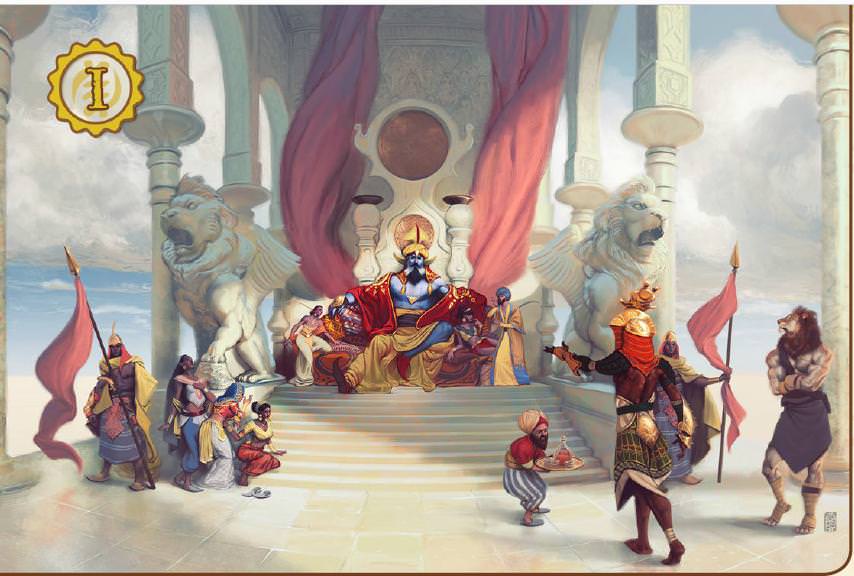
Even the canniest scribes and blessed scholars can only compile a fraction of the Southlands’ history which stretches back to time immemorial. The sands of past eras eroded the legacies of many rulers to the point that they’re mentioned only as footnotes in papyrus scrolls and oral folklore. Fact turns into legend and rumors, and conquering kingdoms rewrite history to glorify themselves. Even so, there are a few grand nations and events which are remembered thousands of years later.
This section of the introduction is peculiar. Instead of a linear progression of years, the text is organized by local cultures and the rise and fall of specific kingdoms. While I suppose it can be good for condensing relevant information for said realms, it is a bit jarring and even the longer-lived nations such as Nuria Natal jump around in places. There’s one entry of the rise of Morreg 1,500 years ago; after that we get the Moon Kingdom which rose 450 years ago; then we jump back to 1,100 years ago to cover how a pair of nomad nations rose from scattered tribes to repel Morreg’s incursions. I’m going to opt for a different approach, where I try to adhere to a more linear timeline.
What follows is a condensed history of the Southlands. Around the dawn of creation the giant Aurgelmir’s breath transformed into the four Wind Lords. Said spirits sought to avoid the war between gods and giants, retreating to the newly created plateaus and deserts of the mortal realm. After Wotan and the first gods triumphed over the giants, the defeated remnant titans retreated into far-off lands and founded an empire in the southern continent known as Glorious Umboso. Their civilization sparked many wonders and advances in art, lore, and magic and were worshiped as gods by less-powerful mortals. Alongside Glorious Umboso rose the kingdom of Nuria Natal, where a dynasty of mage-families discovered a powerful ley line within the river that would become the nation’s namesake. Although its borders shifted greatly, the river kingdom survived to the present day with the aid of mummified god-kings of prior generations, ready to wake during times of greatest need.
3,000 years ago the island kingdom of Ankeshel slipped beneath the waves, causing fleeing refugees to make their way to the Southlands’ northern deserts. They intermarried among the indigenous people and would later become known as the Tamasheq. The titans of Glorious Umboso were afflicted with a terrible magical plague which plunged entire cities into madness. No amount of magical or natural healing could halt its progress, so in a desperate bid to preserve their legacy they imparted bits of their divine sparks to trusted mortals. They charged said mortals to act as caretakers for their empire until they recovered. A few titans took shelter among the sea god Nethus, but most sadly destroyed their civilization in an orgy of chaos and violence. The titans’ former core territory became known as the Abandoned Lands, with uncontrolled magic from altered ley lines spilling out into the world and warping flora and fauna.
Although they did not intend to be such, the Wind Lords would soon earn their name as political leaders of the Ankeshelian refugees. The four Wind Lords debated how to handle this, and three of them agreed to accept them within their lands. The dissenting voice, Boreas the Northern Wind, viewed this as an invasion and assaulted the refugees with freezing storms and attacks by his elemental minions. The Southern, Eastern, and Western Winds were disgusted by this cruelty and made war against Boreas, driving their bloodthirsty brother out of the Southlands to Midgard’s far north.
Some disciples of the titans founded city-states among the Southlands’ western coast about 1,500 years ago. The mightiest two were Morreg and Lignas. Lignas was a metropolis of learning, with compiled lore making their scholars prized by far-off kings who sought the best advisers. Morreg was a more militaristic city whose warriors seized territory all along the coast, turning their humble beginnings into a self-designated Enlightened Empire. Lignas, with its mighty arcanists and theurges, was the only realm which could repel them for an extended period but even they were sacked in time. Alas Morreg’s reign would fall, not at the hands of an outside power by by its own mad Prince Agajay. Their leader's seduction by the teachings of an evil god plunged Morreg into ruinously expensive military campaigns and broke his empire into scattered warbands. Mutual defense pacts forged by far-flung tribes fearful of Morreg’s powers turned the Cattle Queens of Terrotu and the Zulu-like Narumbeki Legions into veritable forces. Lignas regained its independence, and after suing for peace Morreg entered a long period of decline.
In the following generations the Southlands saw the rise and fall of other civilizations. The maritime minotaurs founded a Carthage-like Moon Kingdom 450 years ago before the Mharoti Empire razed its cities. 400 years ago the druids of Kush accidentally summoned an eldritch abomination known as the Green Walker. In a fit of desperation the druids conducted a self-sacrificial ritual to freeze the monster's cancerous growth in a bubble of slowed time.
200 years ago the Mharoti Empire’s early expansions pushed into the Southlands, warring against Nuria Natal, razing the Moon Kingdom’s Cities, and even trying to annex the Dominion of the Wind Lords. The Moon Kingdom suffered heavy losses, but the Nurian God-Kings and Wind Lords push back hard. They unleashed the full brunt of their divine and elemental might against the draconic warbands, from undead armies to golem siege engines rising from the pyramids to spirit-infused breath weapons turning against their own dragons. The Empire’s forces retreated from the Southlands, but the dragons did not consider this a total defeat. In future generations they would test their capabilities, conducting smaller scale raids against key targets with decades-long gaps between them to keep the shorter-lived races complacent enough that they won “this time.”
Divine Sparks
Divine Sparks have their own side-bar in the first chapter. The usually manifest as glowing spheres of energy found within the most secured dungeons, ruins, and and palaces. Oftentimes they are pursued as part of a great undertaking, but more than a few unassuming souls rose to great deeds by accidentally stumbling across them in more unexpected places.
Mechanics-wise, a character must absorb the spark into their body in a four hour process of meditation and internal study. The character rolls an integration check, which is 1d20 + their character level + the highest of their Constitution, Intelligence, or Wisdom modifiers against a DC of 30. Success allows the character to become a mythic character as per the Pathfinder Mythic Adventures rules, or counts as a completed trial in the process of gaining new mythic tiers.
Failing the integration check afflicts the would-be powerseeker with a permanent curse as per the bestow curse spell. Alternatively for Game Masters who don’t care for Mythic Rules, divine sparks could instead grant powers usable a certain amount of times per day, usually a spell-like ability of up to 5th level, limited shape-changing, or immunity to a specific element or harmful effect.
The Mythic Rules are Pathfinder’s answer to 3rd Edition’s Epic Levels. Instead of extending numerical abilities past the 20th level cap, there are Mythic Tiers independent of level which are ascended via the completion of heroic trials. The tiers grant unique abilities as well as Mythic versions of existing feats and spells. I have never played with these rules, but from what I heard of Paizo’s Wrath of the Righteous is that they take Pathfinder’s tenuous balance and rocket launcher tags and amplify them to 11.
The later chapters outline examples of divine sparks and their locations, as well as some important NPCs who already have one. As such sparks are rare and implied to be part of the culmination of an adventure arc, the rolling for integration seems unnecessary and should instead be narratively played out. The fact that only one creature can absorb a spark at a time means that scaling will be uneven within PC groups unless discovered sparks are always equivalent in number to the party size when found. Given that the Mythic Rules for Pathfinder are already quite unbalanced, this will only further exacerbate PC power levels if played straight.
But I do like the concept of adventurers traveling around in a classic fantasy “find the legendary crystal MacGuffins” as part of an epic quest, with a literal divine power boost as a reward for each one collected.
Races of the Southlands
The majority of this section provides us a discussion of two existing “major races” of humans and dwarves along with five new races. There is also a list of “minor races” whose presence is smaller, localized to specific regions. The minor races, if they are new and not reprinted from the core rules or existing Midgard books, are detailed in their own respective chapters.
Humans dominate the Southlands much like they do in most campaign settings. The major cultural groups are divided into six group categories which are more akin to pan-ethnic groups: spread among many countries but with a shared linguistic and/or cultural origin.
The Annites are descendants of Ankeshel refugees and northern nomads, whose two major groupings are the Tamasheq nomads and the Qamari humans of the minotaur kingdoms. They are analogous to the real-world Amazigh and Carthagnian peoples respectively, and start with 4 (!!!) languages by default: Draconic, Nurian, Tamasheq, and the Southern Trade Tongue.
Kushites’ name derives from their rainforest kingdom, although their numbers can be found all the way to the far south. They live in isolated tribes but they do have a large capital city called Nangui built on the stump of a fallen World Tree. Kushites produce a high number of albinos among their people, which their enemies ignorantly proclaim to be a sign of demonic blood. If I had to guess, they are analogous to the real-world Kingdom of Kush in antiquity, although the rainforest is a new touch.
The Morregi include the people of the western coasts, both of the nation-state and those whose ancestral lands were once claimed by them. Their culture is known for frequent joyous celebrations, and are quite proud of their self-proclaimed ability to produce great priests and prophets. Between Lignas’ centers of learning and Morreg’s powerful diviners, it is a claim that is often backed up with ample examples. As said nations’ regions were known as the Kingdoms of Gold and Salt in prior Midgard publications for the preponderance of said trade goods, I presume that they are analogous to West African Kingdoms such as Mali and Ghana.
The Nurians are common throughout not just Nuria Natal, but also portions of Kush, the Spice Coast, and the city-states of Siwal and Saph-Saph. They are a proud people, able to point to an unbroken heritage spanning back thousands of years. They are analogous to real-world Ancient Egyptians (Nuria Natal) and Arabs (Siwal and Saph-Saph).
The Tethyians live among the islands of the Southlands’ east coast and engage heavily in maritime trade. They sport heritage not just from the Southlands, but also travelers from Khandiria and Far Cathay (Midgard’s fantasy counterpart India and China).
The Zwana are tall people with sharp features who live around the settled edges of the Abandoned Lands and whose most well-known members include the citizens of Narumbeki, Terrotu, and Omphaya. Their customs and regional dialects vary wildly depending on where they live. I do not know what specific real-world counterpart cultures they adhere to beyond the Narumbeki being Zulus, but would probably guess various savanna cultures.
Dwarves of the Southlands are related kin to their northern counterparts, but culturally are very different. They are more known for scholarly pursuits such as scribes, alchemy, and magic (as well as engineering and artisanship) than warfare. They are respected in most lands for their high-quality goods.
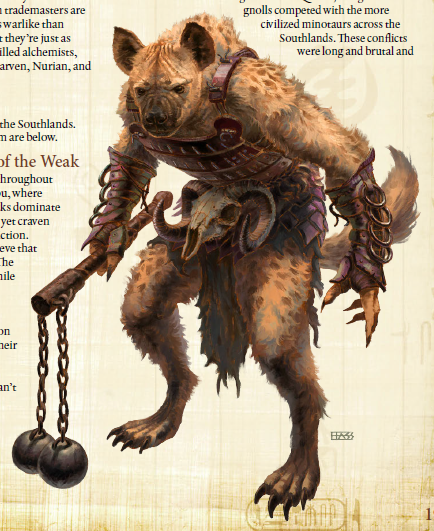
Gnolls are one of the “new” races of the Southlands. Much like their typical D&D counterparts they are warlike and their societies operate on a Social Darwinist worldview where strength and martial prowess determines one’s station. The weak of their own race and others are often enslaved, but due to their respect of strength they can exist on non-violent terms with cities and nations who more than prove their worth. There’s a sizable number of “civilized” gnolls who integrated into Nurian cities and even adopted their gods.
Stat-wise gnolls get +2 Strength and Constitution with no other stat penalties, +2 natural armor, darvkision 60 feet, as well as spear/bow/mace proficiencies and Survival boosts for locating food and water. Their only negative trait is their cowardly nature which gives -2 on fear-based effects.
Gnolls make for pretty strong warriors, and their natural armor boost is pretty good.
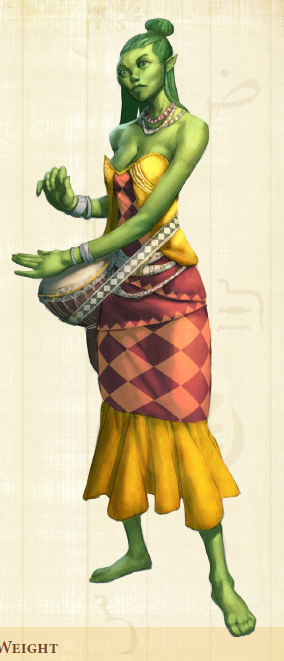
Kijani are a plantlike pseudo-race whose ancestral homes are the jungles of Kush. The Green Walker’s depredations forced them into a diaspora to the far south. They are calm, contemplative people who seek to master their worser natures of anger and fear which are the result of a sort of cultural PTSD from their exodus of Kush.
Kijani appear like green-skinned members of other races in part due to their Great Change, where they implant symbiotic seedlings into willing hosts. This is part of a multi-generational evolutionary plan to turn their race from plants to mammals. The seedling grows over time before separating from its host to rapidly grow into a full-fledged kijani bearing aspects of their host “parent.” Knowledge of this process can be unnerving to outsiders, so they only share the Great Change with trusted non-kijani friends and lovers.
Stat-wise they have +2 Charisma, -2 Constitution, and +2 to one other ability score reflecting their humanoid host. They are also treated as the plant type rather than humanoid, gain bonuses to attacks and AC when reduced below half their Hit Points in a pseudo rage, a constant speak with plants effect, and may treat any two knowledge skills as class skills and gain +2 on checks with them. The plant type alone is a powerful defensive ability (immune to mind-affecting, paralysis, polymorph, sleep, and stunning) but otherwise the rest of their abilities are rather balanced and thematically useful.
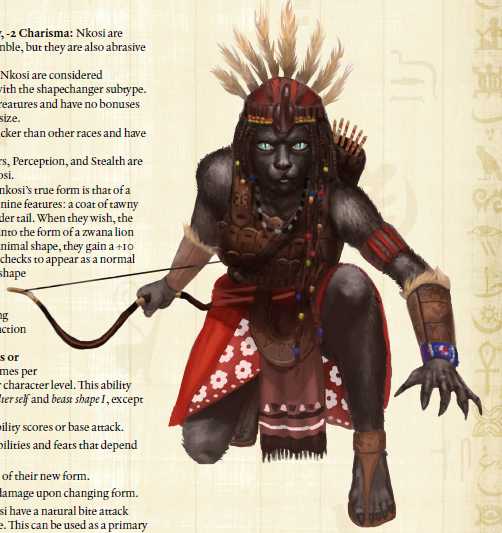
Nkosi are feline humanoids whose creation lies at the hands of the titan Gamka’s divine spark. Gamka granted trust human servants with the powers of the mighty lion. These ur-nkosi could transform into said wondrous beasts for a limited time and even gained vestigial features long-term. They appear as humans with catlike teeth, eyes, and fur in their natural form and organize their societies into extended family units where children are raised as a group. They treat humans as long-lost kin, and possess binding oaths which are often assigned to family and/or country.
Stat-wise they have +2 to Strength and Dexterity but -2 Charisma, have the Monstrous Humanoid (Shapechanger) type, a base speed of 35 feet, treat Perception and Stealth as class skills, a natural bite attack, and can transform into a zwana lion (new monster in this book) a limited number of times per day as akin to the beast shape spell.
Nkosi are very much built to favor melee and mobile striker roles.
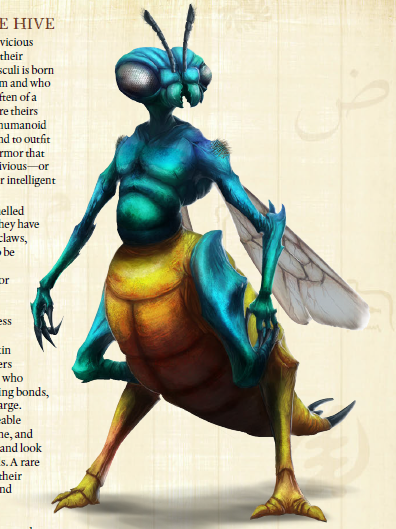
Tosculi are wasp-like insectoids who have a poor reputation among the rest of the Southlands for being on a constant war footing with their neighbors. They have a caste-based society much like ants (drones, builders, warriors, queens) who seek to conquer for their leader’s glory. Tosculi possess a hive-mind mentality where they are born hearing a song known as the Golden Swarm. A few tosculi are born every so often unable to hear this song and often seek a life of independence. Even then these outcasts rarely fit into other societies, becoming loners or banding together among other misunderstood outcasts.
Stat-wise they have +2 Dexterity, +2 Wisdom, and -2 Charisma. They are Small Monstrous Humanoids with +1 natural armor, two 1d3 claw attacks, treat Perception and Stealth as class skills, can share a square with another member of their race at once and flank any foes they are engaged with at the same time, can use soften earth and stone once per day as a spell-like ability which they use to build their hive-cities, and have wings which allow them to glide and fall safely from any height even if unconscious, paralyzed, or similarly restrained.
Tosculi are begging to be put into roguish and scouting archetypes on account of their skills. Many of their racial traits are useful for all kinds of archetypes, from their auto-class skills to natural armor and gliding wings.
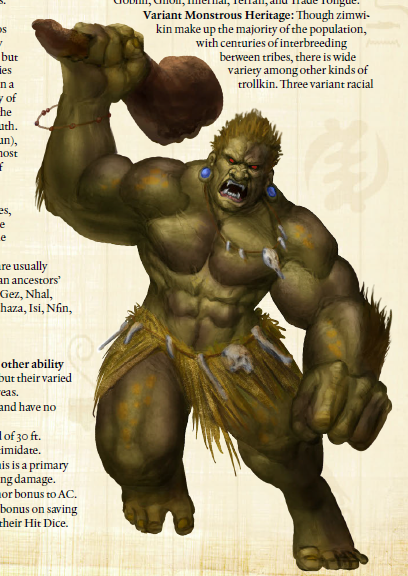
Trollkin are the descendants of all varieties of immortal and monstrous races cross-breeding with humans. “Trollkin” is a catchall term for these people. Trollkin are feared by many and viewed as violent brutes, pushing them to gather into tribes known as septs scattered throughout the Southlands. Their variant bloodlines means they have lots of physical diversity, but tall forms and strong bodies are a near-universal trait.
Stat-wise Trollkin have +2 Constitution, -2 Dexteirty, and +2 to one other ability score representing a dominant monstrous/supernatural heritage. They have a natural bite attack, +2 to Intimidate checks, +1 natural armor, and a racial bonus on saves against ingested poisons equal to their Hit Dice. Furthermore they can take alternative racial variants represneting various bloodlines. The default trollkin race has a zimwi ancestor (ravenous lion-like ogres cursed with eternal hunger), but there are three subraces who can swap out the trollkin’s default racial features of bite attack, AC bonus, and saving throws vs ingested poisons in favor of new abilities.
Fey-kin can grant a choice of an appropriate cantrip as a once-per-day spell-like ability and bestow curse as a once per month spell. Eloko-kin descend from a race of evil underground dwarves and gain a 1d4 claw attack along with cause fear as a once-per-day spell-like ability; and finally the adze-kin, descendant of a race of vampiric humanoids who gain vampiric touch as a once-per-day spell-like ability and a climb speed equal to half their normal land speed.
Overall the trollkin are the half-orcs of the Southlands in being outcasts geared to a brute striker roll. The subraces don’t really impress me besides the adze-kin, which gets a very good spell and a climb speed.
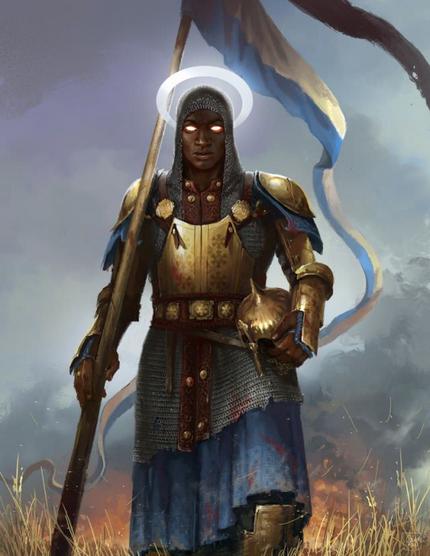
An aasimar of Ishadia. Not from the book proper, but from Kobold Press' Advanced Races: Aasimar.
The Minor Races of the Southlands include seven of the more notable peoples not covered above. The Aasimar are concentrated in the continent’s northeast, boasting proud angelic heritage; the Heru are ravenfolk who live in the temples of Horus as honored citizens, respected in Lignas, and in the valleys of the Abandoned lands. Many praise Horus as their patron deity. The Jinnborn are nomads descended from elemental entitites, living in the Dominion of the Wind Lords and possess a literal bond to the land itself. Lizardfolk are a young race of the Southlands, living in the isolated realm of Veles-Sa harboring a giant egg believed to contain the World Serpent’s child. They are currently isolationist, but believe it is their destiny to conquer the surrounding lands in said serpent-god’s name. The Minotaurs are limited mostly to the Southlands’ extremes, be it the crumbling Moon Kingdom remnants of the northern deserts or the kingdom of Sudvall at the continent’s southern tip. A few gave up their heritage and assimilated into the other populations, but even then seem to possess a knack for vessels of all sorts. Even the desert-bound sandships are known to carry minotaurs as crew and good luck charms. The Ramag were once humans allied with Glorious Umboso, manipulating ley lines to connect the titan empire in a magical web for transportation and defense. They still live in the Abandoned Lands, claiming the city of Ramagani as their homeland whose portals connect the city to far reaches of the Southlands. Tieflings appear anywhere demons and devils consort with humans, and face varying levels of acceptance: Nuria Natal and Lignas tolerate them, and in the devil-ruled city of Nangui they rise to positions of great power.
Thoughts So Far: Southlands’ introductory chapter starts us off with a strong impression of the setting and what it will be about. The history section contains an organization style different from other setting books, but is not enough to feel too confusing for me. I like the new races as well as the changing of existing ones to better fit into the setting.
Join us next time as we visit the River Kingdom of Nuria Natal, whose pyramids hold legacies of great kings and where gods walk the streets!
Chapter Two:Nuria Natal
Original SA post
Chapter Two:Nuria Natal
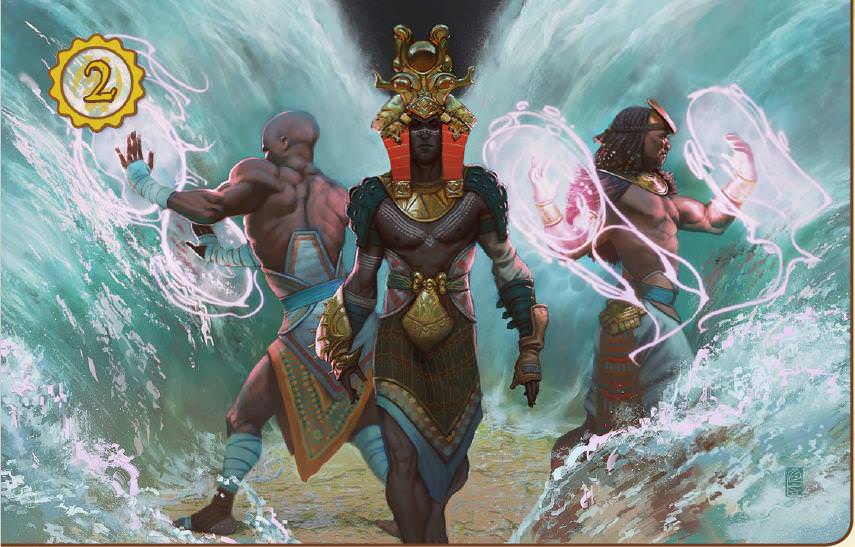
Our first stop in the Southlands is the River Kingdom of Nuria Natal and a few of its autonomous neighbors. The region is heavily Ancient Egyptian in flavor, with its geography centered around the River Nuria whose waters are infused with the magic of ley lines. The kingdom’s earliest founders built their civilizations around said river in order to exploit its supernatural properties as well as its use as a fertile agricultural basin. The pyramids and tombs dotting the cities and countryside are actually complex engines of resurrection designed to bring fallen god-kings back from the veil of death in times of greatest need.
Although united in language and culture, the grandest cities are closely keyed to specific deities of the Nurian pantheon. Horus is the gods’ kingly head, but the cults of Anu-Akma (Anubis), Bastet, and Thoth-Hermes are the three most popular and powerful religious organizations in the nation. Anu-Akma’s cult handle affairs of ensuring the transferral of souls into a proper afterlife. Additionally they fund the creation of the many traps, mystical guardians, and other defenses of pyramids and tombs.
The worshipers of Bastet are a diverse sort, ranging from alchemists and farmers to hunters and soldiers. She claims the city of Per-Bastet as her home, often walking its streets in disguise as a mortal or feline. Said realm is a vibrant trading hub ruled by a council of secular and religious authorities, resulting in a quite ordered religion for a Chaotic goddess.
The worshipers of Thoth-Hermes have heavy representation among the Heru ravenfolk as well as a heavy hand in promoting education and knowledge. The cult is quite active in a secret mission of finding the lost Emerald Tablets of Wisdom. It is believed that said tablets contain writings by their god for altering the face of Midgard or communing with the World-Serpent. Perhaps ironically more than a few militant sects resorted to theft and tomb-robbing in hopes of collecting the tablets; to them, it is but a lesser heresy than letting the knowledge slip into the lost annals of history.
The write-up for Nuria Natal’s capital (the same name as the kingdom as a whole) is surprisingly brief. It talks about the god-king’s massive palace which includes a ceiling portraying a perfect copy of the night sky at all hours, to a Well of Ascension whose lotus-infused waters must be drunk in order to undertake the Tests of Inheritance necessary for claiming the throne.
Eastern City-States
Before diving into Nuria Natal proper we cover three city-states east of the kingdom who maintain heavy trade and cultural exchange with the River Kingdom. Siwal, Saph-Saph, and Makuria were founded as strongholds in the eastern deserts to better connect Nuria Natal’s trade network to the eastern realms, but now exist as independent political entities in and of themselves. They’re more medieval Arabia in culture and feel, and manage large caravans which include magical ships capable of sailing over sand dunes like water in addition to mundane transports.
The largest of these cities, Siwal, is called the city of Gardens for its large natural oasis. Elemental magic is built into urban planning to make lush vegetation grow throughout most of the city, including the tops of its walls. It is also home to the Grand Necropolis, the largest of its kind in the northern portion of the continent. Housing great heroes as well as paupers, it has modest natural protections but is heavily guarded by Anu-Akma’s guardians and mages known as gravebinders whose task is to ensure that no undead rise to plague Siwal’s citizens. Interestingly enough, the Necropolis is home to an undead community of ghosts, ghouls, and vampires who hold court at nightfall. They have an arrangement of sorts with the gravebinders to not attack the living (save in self-defense and against tomb-robbers) and to rise only at night, but otherwise can have the necropolis to themselves until the sun rises. This arrangement works out for both parties, even if it does give Siwal a macabre reputation at night.
Saph-Saph occupies a deep natural depression filled with springs and groves. The fortress of Per-Saph is its largest community, home to a temple-school of Aten which trains new generations of the god’s priests and paladins. The settlement of Saph-Ket is home to the Oracle of the Sun whose occupation has foretold prophecies for Nurian leaders for a thousand years. The city’s fertile groves are capable of building one new sandship each year.
Makuria is not as grand or rich as the former two cities, but it makes up for this with expert guard and mercenary work. Their primary clients are the border cities of Nuria’s south and Kush’s north, accepting coin from and against both sides. The more moral Order of Horus employs a cavalry tasked with keeping vital trade routes open, fighting against banditry and annexation by hostile powers.
Per-Bastet, Everlasting City of the Cat
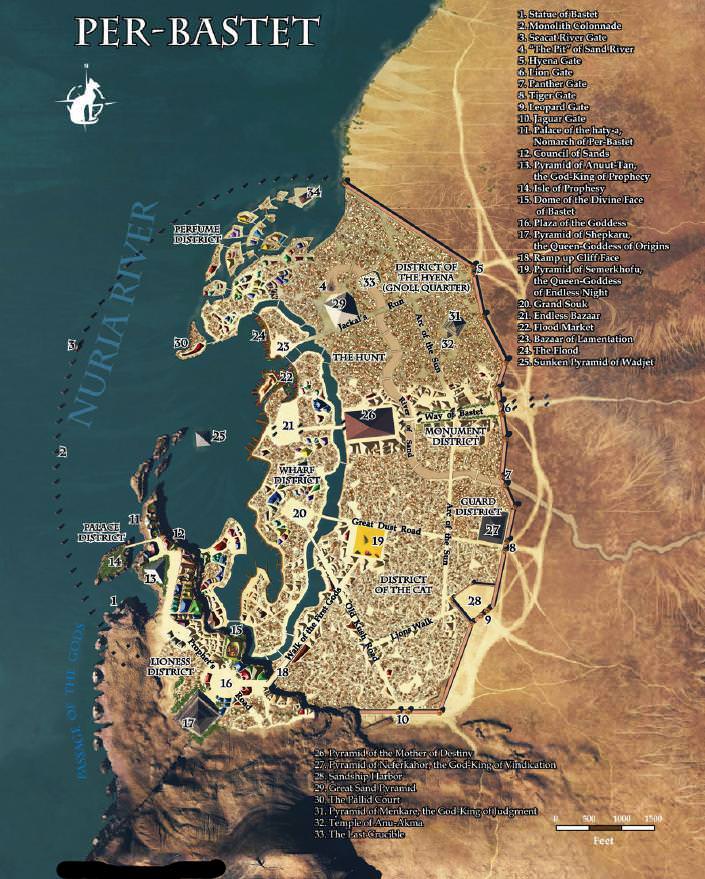
The most famous city of Nuria Natal is not its capital, but one further south along its banks. Named for its relationship with the feline goddess, Per-Bastet is the Southlands’ Waterdeep: a cosmopolitan crossroads of cultures from southern Kush to the Mharoti Empire and beyond, a vibrant city home to all manner of factions, a chaotic council of government which doesn’t see eye to eye, and more than a few villainous figures skulking in the dark.
Per-Bastet’s history stretches back millennia, but the oldest historical evidence is lost to time. Bastet’s faithful claim their goddess chose it as a space to revel and host parties with the other gods, and whose divine tears of joy sank into underground caverns which nine great pyramids were built over. Gnolls claim they founded the city, and Nuria Natal’s first god-king claimed it as the capital for a time. Its geographic position as a trade hub placed it at the brunt of clashes with various forces, its most recent enemies the Mharoti Empire of the past 400 years.
Legends say that the city has been defeated and razed nine times in its millennia-long history, only to be reborn and rise again to glory. Like a precious jewel everyone wants, Per-Bastet has lured many hands to claim it. This, along with receiving nominal support from the rest of the country in recent campaigns against the Mharoti, has caused its diverse population to be fiercely patriotic of their hometown. Human or gnoll, living or dead, it is a chaotic city unlike anywhere else in the world...and they wouldn’t have it any other way.
Neighborhoods and Locations
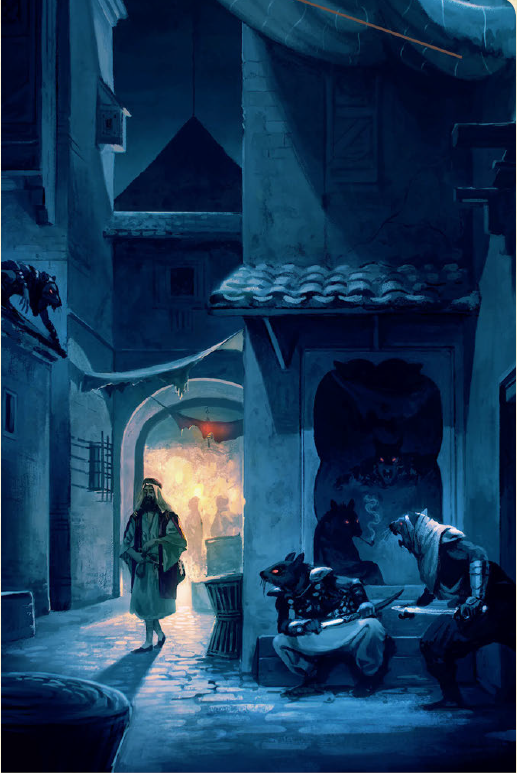
Per-Bastet is a riverside port of 60,000 souls. The city’s fed by a series of canals and irrigation ditches home to orchards and grain fields along with cattle. A series of monolith colonnades line the western harbor as a magical defense grid, where nine or more clerics or oracles of Per-Bastet can perform a ritual in a specific temple. This summons up mists and silt-filled eddies to teleport hostile creatures and vessels past the colonnade’s outer ring. The level and magical skill of said priestesses matters not, meaning that Per-Bastet has a potent naval defense.
Tors line the roads south of the city, home to a gorge known as the Path of the Gods, where immense statues over 80 feet tall are carved in the gods’ likenesses. The last four are so weathered they are unrecognizable and known as the forgotten gods. Temples between the statues’ feet lead into unknown places, whose doors remain locked by long-lost magical keys.
The much drier second river of the city is the River of Sand, an always-mobile quarter-mile wide flood of sand winding from the eastern desert into Per-Bastet’s east before ending in a funnel-shaped crater. Many objects and people lost in the flow are sometimes found years, decades, or centuries later in seemingly random locations in the farther deserts. Such “sand-touched” objects are prized for their supposed good luck charms. The river’s magical reputation is further reinforced by the presence of earth elementals swimming within its flow much like fish.
The cats of Per-Bastet are numerous and have free roam of the city. They can access a unique form of transportation known as catslide alleys, out-of-the-way magical portals which can lead elsewhere in the city and even farther-flung places such as northern cities or a hellcat den in the Eleven Hells.
For neighborhoods proper, Per-Bastet is divided into nine districts. The Palace District occupies a plateau at the feet of Bastet’s statue, an invitation-only neighborhood home to the opulent mansions of the city’s rulers. The District of the Lioness is the city’s spiritual center, a mixture of rich and poor people along with a sizeable presence of feline races from nkosi to werecats, as well as cat-loving humanoids and endless hordes of normal cats. The Dome of the Divine Face of Bastet, the goddess’ greatest temple, calls the Lioness home, and most businesses here are dedicated to entertainment from theaters to brothels. The District of the Cat is a labyrinthine market district most active at dark, whose nkosi inhabitants have their own internal social laws but nonetheless more than happy to welcome visitors. The Wharf District sees to the city’s waterbound trade: it houses the largest slave market in Nuria Natal, mostly derived from the draconic races taken as prisoners of war. Werecrocodiles live in the district and are surprisingly well-mannered...save when gnolls hunt the crocodiles they raise as a rite of passage, which leads to tensions between the two races in the city.
The Monument District is the city’s administrative center. Its academies, granaries, and public works buildings sit beneath grand sphinxes and pedestal-clad statues testament to patriotic glory. Of particular shock to most visitors is that the Dead, or Per-Bastet’s name for undead citizens, outnumber the living as civil servants in this district. The God-Queen Meskhenit and an army of the Dead lair in the neighborhood’s local pyramid, capable of fielding the largest army in Nuria Natal. The Guard District is the other undead-majority neighborhood, housing the offices, courts, and jails along with a Sandship Harbor.
The Hunt is Per-Bastet’s bad section of town. Occupied by mostly-abandoned builds inhabited by various monsters and elementals, the city’s laws hold no sway here. Fugitives and criminal organizations use the district as a temporary refuge, and its westernmost tip holds an island containing the vampire-run Pallid Court. The district’s Great Sand Pyramid host an amazing phenomenon where a trail of sand falls to the structure’s top from an unknown location high in the sky.
The District of the Hyena is a gnoll-majority neighborhood which sits upon multiple layers of ancient buildings comprising a series of underground warrens. The gnolls are mostly self-governing and resolve disputes through blood debts. Its two notable locations are the Temple of Anu-Akma who grant blessings to the departed and decide who is worthy enough to be raised into the Dead. Finally, the Perfume District sits downstream at the city’s northern edge. It hosts the smelliest occupations in a series of bridge-connected islands, and there’s a thriving black market for poison, alchemic constructs, and ingredients for necromantic rites.
Government and Military
Its own leadership varies wildly on who you ask: King Thutmoses XXIII, the present god-king of Nuria Natal, claims that his brother Haty-a Haakim rules this great jewel of the city. But most citizens point to the Reborn Queen-Goddess Meskhenit as their ruler. The undead sorceress-priestess of Bastet commands a legion of undead and whose inhuman charisma holds the city together. But even she is subservient to her patron deity, who would replace both rulers in rank if she ever bothered to sit on the throne long-term. The Council of Sands acts as an advisory capacity to Haakim, which includes the prototypical traitorous vizier who plans to assassinate said monarch and usurp Meskhenit’s command over the Dead. The other council members are more mundane in their pursuits, such as a rigid lawyer who finds the city’s discordant way of doing things nightmarish for her job. Other notable power players in Per-Bastet include the Pallid Court, a society of rich vampires who are treated as ordinary citizens (if ones the average street-goer doesn’t want to mess with) due to a mixed relationship of deals and tit-for-tat power jockeying with Meskhenit; and the Gnoll Warlord Raykar-Takur, who can field 6,000 elite fighters from the Gnoll Corner in times of war but busies himself with desert hunts and fighting in the Great Arena.
Per-Bastet’s major military forces include the living Army of Summer, who comprise the infantry and charioteers along with Raykar-Takur’s gnoll legions. The Legion of Wadjet holds dominion over the river, made up of barges supplemented by aquatic monsters, nagas, and werecrocodiles. The Legion also contains a dire spinosaurus as a secret weapon submerged beneath the city. The Sky Guard of Horus are the city’s air force, made up of griffon-riders, air elementals, and sphinxes. Finally, Reborn Queen-Goddess Meskhenit leads the Dead to battle, who are called the Army of Night by the city’s living soldiers.
Tes-Luria, Seat of the Carnidine Kingdom
The ruins of Tes-Luria are the last legacy of a long-forgotten kingdom founded by Bastet. It was one of the most powerful nations in the Southlands before collapsing. The causes of this are unknown and debated by scholars, although the most popular explanations are known as the Three Dooms of Tes-Luria. The Dooms point to drought, being forsaken by their patron deity, or the loss of key ley lines from enemy countries’ magical manipulations. What is known now is that its walls are empty, home to none but brave expeditions of tomb-robbers, pilgrims, and undead and golem guardians. We get a write-up of several archeological mysteries to be found within, such as a fane to the demon god of gnolls whose frescoes strangely portray him as a much kinder figure than he is now. We also learn about five tombs holding famed figures and their treasures, such as a werelion warrior believed to be the son of the Hunter, a sinister deity, his corpse encased with his holy ax in a solid block of basalt.
Per-Anu, City of Crimson Pillars
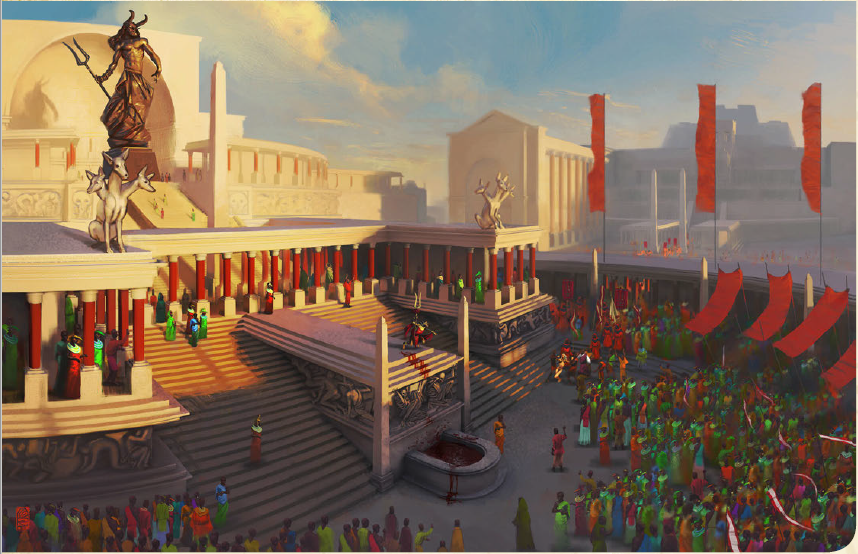
Hidden among hills and open only to the faithful of Anu-Akma and his allies, the city of Per-Anu is a strange domain devoted to death in all its forms. Its macabre Red Market is home to trade in necromancy, blood, and spiritual manners, including many sacred tokens and binding agents useful against the undead. Some people swear that newly awakened god-kings and goddess-queens can be spotted in the streets in search of potent charms. Healers find their trade here as well: devotees of Isis operate out of the Temple of White Blossoms, and the famed Embalmer’s Guild know of the secret rites of preparing proper burials for nobles, god-kings, and other Nurian heroes. Their status is so high in the city that any attempts at harming a member of the guild is a great crime which will bring down the wrath of the god-kings themselves.
Irsu, Per-Anu’s god-king, is a darakhul, a special type of Midgard ghoul. He arrived at the city as a pilgrim and ruled for centuries since. Irsu prioritizes research into the Red Portals, local extraplanar gateways which grant a direct line of travel into the many Underworlds of the dearly departed. Said portals are watched closely and presided over by the city’s elite guards, which is a good thing as all manner of monsters and fiends seem drawn to them. There is even a grand school of magic, the Society of Portal Wizards, which funds travelling beyond the mortal realm into the myriad worlds beyond. Per-Anu’s other great academy, the Order of Tombkeepers, focuses on all things spiritual and undead along with the guardianship of cemeteries and other places of rest.
Perilous Sights of the River Kingdom
Rounding out our traveller’s almanac for this chapter is a list of miscellaneous adventure locales for Nuria Natal along with a sidebar containing 20 adventure hooks. I will not list them all, but some of the more interesting ones include the devil-operated Ghatazi Salt Pits whose slaves work the salt mines. Their iconic trade good is colored red, said to be wettened from the miner’s own blood. There is also the Lost Army’s Field, a mass grave of Mharoti soldiers and dragons consumed by the desert and whose spirits haunt this desolate stretch. For some good old-fashioned dungeon-crawling we have the Corrupted Pyramid of Khensu, a structure haunted by the ghosts of slaves perished from the mass sacrifice of a Nurian vizier seeking godhood.
We get a page or two of common wilderness terrain types, trade routes and goods along with the game statistics for sandships. Basically it’s a template applied to a mundane vessel which allows it to travel over desert and tundra. We also get a lengthy description of the Eyes of Aten, an organization dedicated to the Nurian sun god.
Aten is a rather unique case as far as gods go; in the base Midgard setting, the gods wear masks to obscure their number and allow themselves to appear as different identities in different cultures. Aten and his faithful insist that such deities are but very powerful pretenders and he is the true divinity of reality. His faith holds sway in the Nurian city of Per-Xor, which has an army of its own. But the Eyes of Aten are a secret cult whose members are chosen by the god himself via specific dreaming premonitions and prophecies. It is said that Aten used to unleash the powerful monster Sekhmet and his own burning gaze upon evil, but their powers were so great that they would leave the earth a lifeless, charred ruin if they continued. So he appointed the Eyes as servants to carry out his will in the mortal realm.
The Eyes of Aten are part spy agency, part terrorist cell. They are decentralized and clandestine although they do have a clear hierarchy of order. The Eyes prefer to act through unwitting third parties, mercenaries, and bribed civil servants to gain funds and strike at their enemies. They have their own sub-orders dedicated to specialized tasks, such as the Chosen of Sekhmet who are vicious werelion “clean up crews” unleashed when the chips are down, and the Shadowed Suns who are mummies created for long-term surveillance of areas of interest to their god.
New Rules
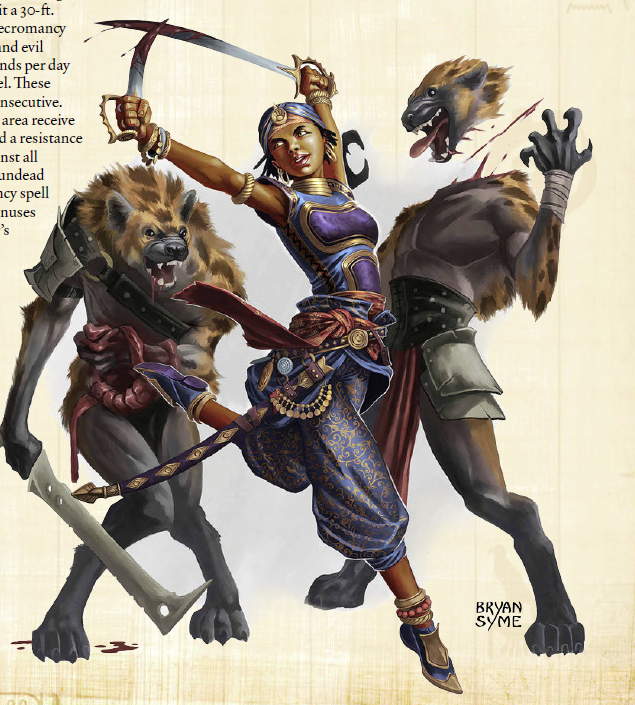
Instead of combining all the crunch into chapters on their own, the Southlands compiles the rulesy bits of character options, equipment, spells, and so on at the end of respective chapters. Said rules are themed for the region in question, and with Nuria Natal we’ll be getting lots of Egyptian-themed goodies.
The Necrology of the Mummy takes the iconic monster archetype and expands on it. Unlike most other D&D/Pathfinder settings, Nurian undead and mummies aren’t always evil spreaders of rotting plague; they are sacred sentinels watching over the sleeping heroes of times long past. We get new templates and abilities such as an Animated Shroud attack where a mummy can use its wrappings to entangle opponents; revenant mummies created to exact revenge; mummy death-curses capable of delivering debilitating afflictions to those who destroy them; scholarly tomes which can grant benefits to those studying them for all things mummy, and even alternative plays on the monster trope such as star-crossed lovers who undergo mummification and burial in the hopes of meeting each other in another era.
We have new archetypes for existing classes, such as the the Chosen of Aten for the theurge who specializes in evocation and necromancy spells; the Face of Bastet for Clerics, who receive less spells per day and give up a divine domain in exchange for the ability to gain physical properties and attacks of a big cat such as a lion or panther; a gravebinder for the white necromancer who gains a pseudo-favored enemy against undead as well as the ability to permanently sanctify corpses among other themed abilities; and the Sword-Dancer for the Fighter who specializes in lightly-armored stylish moves, such as using attacks of opportunity as counterattacks to melee strikes and adding their Charisma bonus to Armor Class. The only prestige class is the Ray of Aten (he seems to be getting lots of love) which focuses around marking targets as an enemy of the faith for extra damage, using fear-based effects, and an easier ability to cast certain divination spells a limited number of times per day (no material components and shorter casting times).

The last major section of this chapter is Hieroglyphic Magic. Known among the Nurians as the Words of Truth or Weret Hekau, they can inscribe pictographic runes on physical objects associated with concepts and deities in order to grant wards and boons upon the building or wearer. Mechanically, this is a sub-system of magic which actually plays off a system from one of Kobold Press’ other sourcebooks, Deep Magic, so I cannot comment on it holistically. But from what I surmise you take a Rune Mastery feat to gain a mastery bonus which is some mechanical benefit, and treat yourself as having knowledge of certain spells for the purposes of crafting magical items. Finally, knowledge of a rune grants you one of two special once-per-day powers (one or the other can be used, not both): one to use on yourself, or one to inscribe the rune on an object and grant powers to said object.
The hieroglyphs are split up by deities they are associated with and have flowery names: The God’s Company Is Like Light is associated with Thoth-Hermes and grants bonuses on knowledge checks, a 1/day increasing bonus to Intelligence-related rolls or cast magic weapon spell if inscribed on a weapon, and you’re treated as having knowledge of spells such as true seeing, tongues, and legend lore. Dress the Wind in the Cloying and Fair is associated with Bastet and grants bonuses on social roles, treats you as having knowledge of enchantment spells such as calm emotions and beguiling gift, a 1/day bonus to increase the DC or saving throw bonus related to enchantment effects for yourself, or can inscribe the rune on an amulet to gain a one-time +10 check to Diplomacy.
Our chapter ends with a pair of new spells; Dessicating Breath, a 4th/5th level spell which deals 1d6 strength damage to all living creatures in a 25 foot cone; and Speak with Inanimate Objects, a 1st-level spell which allows you to ask and receive answers from spirits embedded within an inanimate object. The former spell is a bit underwhelming for one of its level, while the latter is rather overpowered in that it more or less does what Speak with Plants does but is lower level and affects a larger criteria of beings.
Thoughts So Far: I really like this chapter. Nuria Natal has a healthy mixture of urban intrigue, classic dungeon crawls of pyramids and ruined sites, and wilderness terrain of sufficient danger. I like the incorporation of undead into society, from Per-Bastet’s civil servants to Siwal’s nightly courts. Per-Bastet comes off as an iconic city of adventure, and the touch of metropoli favored by specific gods is a cool touch and one based upon actual ancient Egyptian theology. The variant mummy templates are a good inclusion to keep the iconic Egyptian monster from getting stale in encounters, although the new class archetypes left me a bit cold. The Sword-Dancer was the most interesting conceptually, although I cannot help but feel that the concept is better represented by Paizo’s own Swashbuckler or high-quality martial alternatives from the Path of War or Spheres of Might. What can I say, those books spoiled me on martials. This chapter alone has enough material to generate an entire campaign within Fantasy Not-Egypt, so we’re off to a very strong start!
Join us next time as we traverse the Dominion of the Wind Lords, of vast deserts and nomadic tribes presided over by elemental rulers!
Chapter Three: Dominion of the Wind Lords
Original SA post Chapter Three: Dominion of the Wind Lords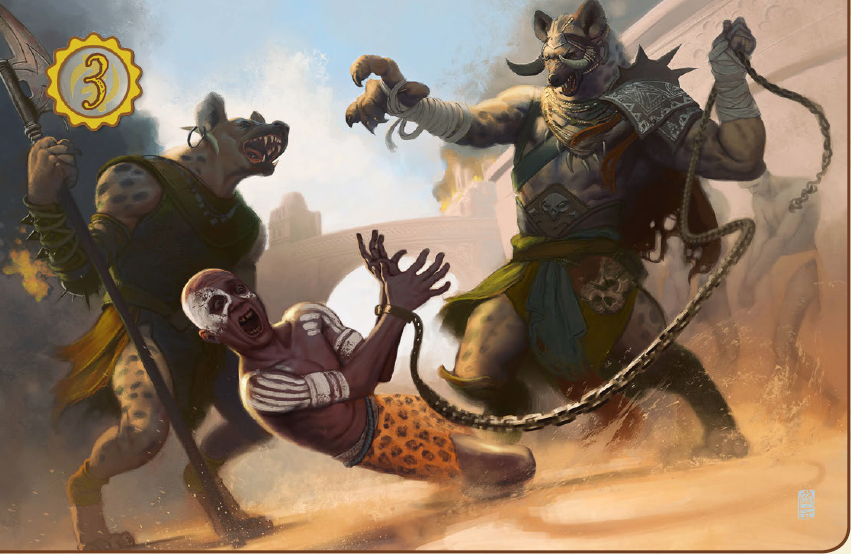
To the west of Nuria Natal, across the Crescent Desert, lies a stretch of arid land known as the Dominion of the Wind Lords. It is a harsh realm, its great Stone Desert made of sunbaked plains instead of sandy dunes. To the average observer, the Dominion is a no man’s land whose past glories of Roshgazi and Golden Ulthar are now lost to the elements. This may be true to some extent, but to the inhabitants who claim this harsh territory home, the Dominion is positively alive with unseen wonders. Precious oases are blessed sources of life, unseen nature spirits walk among mortals. The Tamasheq nomads know of these places and guard them from the unworthy, placating said spirits with offerings for protection if the mercurial spectres’ whims align with theirs. The jinnborn are the other major nomadic group, a race of their own claiming descent from powerful elementals. Then there are the gnolls of Dabu and the minotaurs of Cindass, seeking to build new glorious civilizations amidst the wasteland.
The Tamasheq and jinnborn recognize four great primordial spirits but only three of them are typically honored in mainstream society. Chergui the East Wind is the friendliest to mortals, bringing cool ocean breezes to quell the harsh heat; Shamal the West hates mortals and summons deadly weather in an attempt to drive them from the Dominion; Khamsin the South is a creature of emotional extremes embodying the hot gales blowing from southern wastelands. Then there is Boreas, the exiled North Wind who sometimes visits the Dominion to stir up trouble; he is placated by three Tamasheq tribes who are opposed by all of their other kin.
I find Shamal’s characterization interesting, on account that the history chapter had the Wind Lords disgusted at Boreas’ cruelty to mortals and was the main reason for driving him out. I suppose that millennia can change even a spirit, although the text does not discuss what caused Shamal’s about-face.
Beyond the Wind Lords are an endless amount of lesser spirits connected to phenomena and objects of the natural world: every rock formation, every body of water and gale of wind contains a conscious free-willed entity. Said spirits interact with mortals of the Dominion through the Spider Prophet and other oracles and leaders. Politically speaking they are divided between loyalty to the three Wind Lords, or act as agents of Boreas. This civil war operates on a scale imperceptible to mortals, waged with natural phenomena and shifting of ecosystems rather than armies and hordes.
The Tamasheq
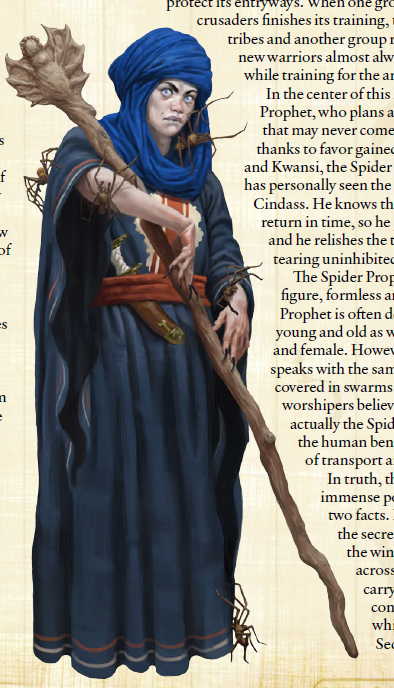
The Tamasheq are the Dominion’s most well-known population to outsiders and are based off of the real-world Tuareg nomads of the Sahara Desert. Numbering half a million, almost all of them claim the region as their home but some make voyages as far as Nuria Natal for trade. They are recognizable by their indigo-colored clothes, and take great pains to convince and other civilizations that they are but simple nomads. In reality, they have a thriving secret city in the mountains by the name of Kel Azjer, home to magical, artistic, and technological marvels. They hide this from the world so as to prevent invasions and intervention by outsiders.
Kel Azjer itself is a sprawling metropolis full of spires, whose hungry mouths are fed by plateau farms managed by slaves captured in warfare. The beautiful Palace of the Spirits contains three empty thrones in the event the Wind Lords ever choose to physically manifest, but perhaps the city’s greatest marvel are the vril mines. Passed down from their Ankeshelian forebears, a rare ore known as vril is capable of nigh-magical wonders and acts as the Midgard setting’s “sufficiently enhanced technology;” naturally the mines are fiercely guarded, but there is a thriving black market of unscrupulous merchants.
Not located in Kel Azjer proper but of great importance to the Tamasheq is the Palace of the Spider Prophet, home to an immortal figure of unknown origin who possesses a seemingly boundless well of wisdom. In fact, this insight is due to a vast network of wind spirits carrying overheard conversations and secrets back to to his ears, as well as being the high priest of Kwansi, a god of chaos and luck.
Dabu, Twin Land of the Gnolls
This loosely organized collection of gnoll packs is not a kingdom in the true sense of the word. Bound in commonality by their race at most, each clan has their own customs and favored divine or demonic patron. The packs operate among themselves in a pseudo-feudal system: secular leaders known as Sas (singular sa) rule individual packs and pledge fealty to a Kasa who is the leader of the strongest pack in the region. The Kasa obey the Ama, who is an oracle. The current Ama is an elderly gnoll by the name of Ninshu who is trying to reign in the gnolls more warlike tendencies. This is not done out of genuine peacemaking, but due to the fact that the tensions with the Narumbeki to the southeast are on the rise and she knows that a true war against them will be one-sided in the humans’ favor. One of her daughters does not share her tempered response: Isha seeks to unite Dabu into a true gnoll empire once she takes the mantle of Ama.
An interesting site in Dabu is the Pool of the Sky, a lake filled with clear water capable of granting oracular visions and removal of harmful curses and charms, but with the risk of imposing insanity on the drinker. The gnolls treat the lake as sacred and guard it against unwanted drinkers.
Valley of Golden Ulthar
Within the Crescent Desert east of the Dominion proper is a most unusual site: a lush magical valley seemingly untouched by the surrounding desert. Once home to a grand civilization, its only major structure is the dust-ridden temple of Serbata which has fallen prey to generations of thieves and overgrowth. It is within this temple that Golden Ulthar’s last remaining citizen still lives: Sepenret the sphinx, a sorrowful woman who seeks to recover the artifacts of her homeland. She employs a company of adventurers and explorers known as the Claws of Sepenret for this task. The other group in the Valley is known as the Order of the Sphinx, a multi-generational group of guardians who serve lifetimes of vigilance in protecting Ulthar’s legacy.
In fact, intact stonework and magic items within this valley contain powerful transmutation magic related to the growing of plants and crops. Known as Pieces of Ulthar, their properties have not been reverse-engineered by other civilizations; they seem tied to the era at which Golden Ulthar fell, and the only way new Pieces are made is when Sepenret lays a stone egg. The sphinx treats such eggs as the most valuable things in the valley, and will instruct the Claws to retrieve them by any means necessary if they are stolen.
Although some steal pieces for the seemingly noble goal of establishing fertile land in the desert (something Sepenret would approve of if they ever bothered to ask permission), most thieves are more selfish and seek the pieces to gain power and status. In fact, Sepenret’s greatest threat is a wererat tribe led by a cruel chieftain building up territory in hopes of claiming the entire valley for himself.
The Ruins of Roshgazi and Emirate of Cindass
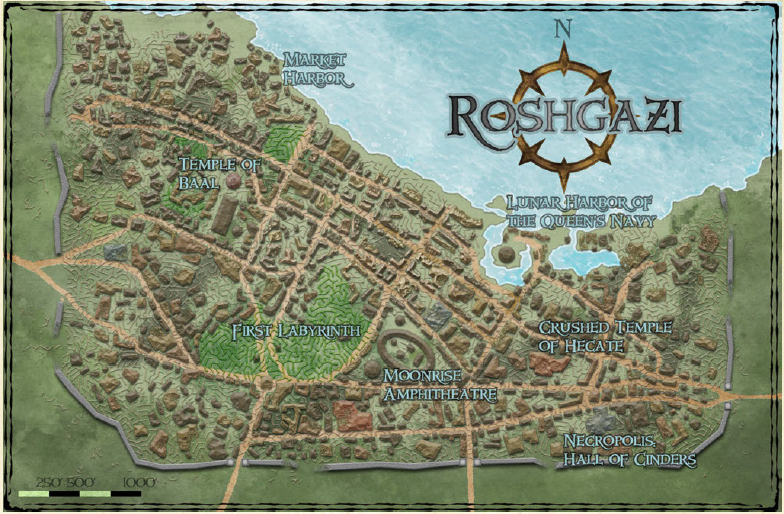
The Fantasy Counterpart Carthage of the Southlands, Roshgazi was once the capital of the minotaur’s Moon Kingdom. Several centuries ago the Mhraoti dragon-fleets descended upon the city for the dual purposes of creating a western front against Nuria Natal while also destroying an Orb of Dragonkind they believed the minotaurs possessed. Using illusion magic and destructive alchemy, the Mharoti besieged the city in a devastating ambush. They scorched and poisoned the fields and wells around it for miles to ensure nothing could grow from its soil. Roshgazi, and by extension the rest of the Moon Kingdom, never recovered from this devastation.
Most of the city still lies in ruins, inhabited mostly by monsters, ravenous insane minotaurs, and rare explorers from the Seven Cities of the northern continent. Due to the minotaur race’s ability to naturally intuit direction, significant portions of town are a confusing array of mazes meant to hinder invaders (and of limited use against airborne dragon raids).
Several ambient magical protections lie in place, especially the Heart of Roshgazi. This sapient sphere lies deep within the First Labyrinth, tasked with keeping the city safe. Unfortunately a deep crack from a saboteur’s magical hammer rent the Heart’s personalities in twain. The Poet is the more benevolent of the two personalities and seeks to bring in people to repair Roshgazi and ward them from its dangers. Broken, the other personality, is downright paranoid and believes the city to still be under attack and treats all newcomers as Mharoti invaders.
The minotaur city of Cindass has fared better. It too was razed by dragonfire, but in recent years patriotic minotaurs begun rebuilding and settling it with the aid of jinnborn tribes. Now the city-state is half functional settlement half ruins still inhabited by all the dangerous things in fantasy worlds which are drawn to such places. The rebuilding project is not without its problems: there are disputes with the Tamasheq over grazing grounds, gnoll raiders view Cindass as a risky yet profitable target, and there are people seeking to establish trade with the devil-slavers of the eastern Ghatazi Salt Pits.
Perilous Sites and Adventure Seeds
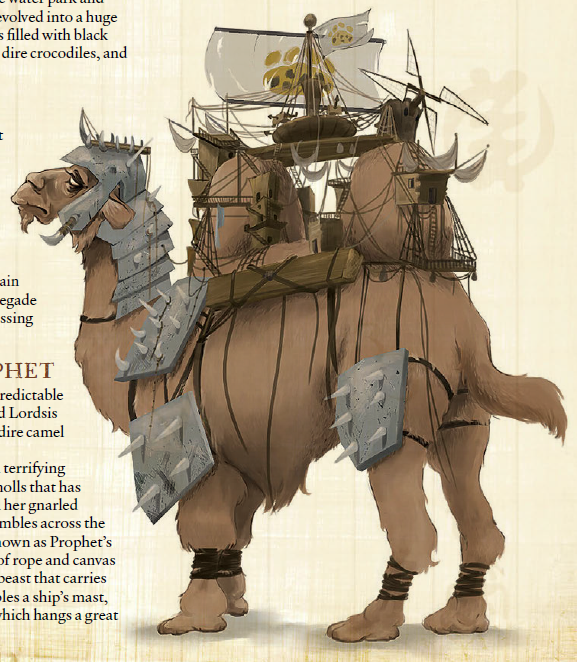
This miscellaneous collection of locales details minor sites of interest to adventurers. The more interesting ones include the Restless Prophet, a gargantuan camel bearing a gnoll fortress upon its back, and the goblin-inhabited ruined city of Mardas Vhula-Gai which is filled with magical glyphs and vril technology. We also get adventure seeds folding in the major factions of the Dominion: an insane noble who believes her bloodline is descended from Sepenret and seeks her stone eggs; a long-lost copper tablet in Roshgazi claiming to detail a land of peace and safety the city’s Moon Queen fled to long ago; and a Tamasheq tribe seeking to expand their holdings into the dangerous Granite Teeth, a series of broken stony lands inhabited by abominations.
Character Options
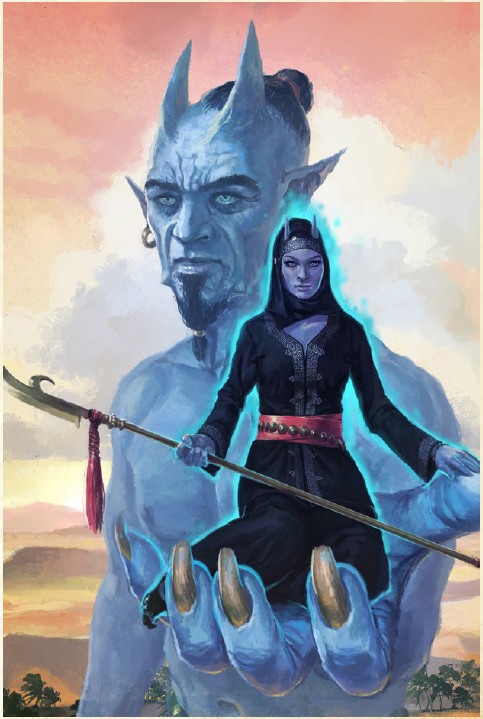
The crunchy options for this chapter contain a little bit of everything. We start out with a new race, the jinnborn. It details their culture as well as their game stats. Basically jinnborn are nomadic people who follow mystical paths known as siraati which determine their customs and cultural values based upon the teachings of their tribe’s Jinn founder, and they call each other sab siraat meaning “people of the path.” They wander along seasonal trade routes and take up occupations which can work for mobile living (traders, mercenaries, herders, etc). Their own cultural origins place their creations at the hands of the Jinn, elemental spirits claimed to be present at the dawn of the world. The world of the Jinn, also known as the Hidden World, plays the role of heaven or enlightenment in their culture.
Stat-wise, jinnborn are a very powerful race. They have their choice of +2 Strength or Constitution, +2 Charisma, and -2 Intelligence. They get +2 bonus on Diplomacy, Knowledge (Geography), Sense Motive, and Survival checks and said knowledge skill is always a class skill. Their defensive abilities include energy resistance based on their siraati and have a constant endure elements spell upon themselves. Furthermore, they have their choice of one of four supernatural abilities reflecting the diversity of their magical powers: 1: bonus energy damage on melee rolls a number of rounds per day based on level; 2: an energy-based ranged touch attack whose uses per day are keyed off Charisma; 3: the ability to increase their energy resistance further for 1 minute per level; or 4: once per day the ability to call upon one’s patron jinn to do an appropriately “unseen trickery” based ability such as imposing a miss chance on an incoming attack, cast the prestidigitation spell, or gain a bonus on feints or saving throws. Jinn who live for an extended period of time in cities and settlements begin to suffer mental disorders, which is accompanied by a table of sample negative mechanical effects.
There are feats for the jinnborn which can grant them improved uses of their supernatural powers and even new ones altogether. Overall the feats are quite useful in that they grant scaling abilities or broad uses. For example, Vessel of the Hidden World turns the defensive energy resistance to always-active and also grants damage reduction vs bludgeoning, piercing or slashing (based on your siraati) ranging from DR 5 to DR 10 based on your level.
Our new class archetypes include the Blessed Scamp (Rogue), a charmed trickster whose main feature is slightly less sneak attack progression in exchange for the ability to perform a mischief in conjunction with said sneak attacks. Mischiefs impose status conditions on an enemy such as dazed, being knocked back 5 feet away, falling prone, etc. The Gnoll Raider (Rogue) is interesting in being keyed specifically to the gnoll race: they grant others of their archetype as well as the Havoc Runner the Coordinated Maneuvers feat, adding their Intelligence modifier to splash damage, and the ability to create temporary magical Shock Bags which can mimic any alchemical item. Related to the archetype, we get a pair of new rogue talents: Improved Alchemical Formula which increases the damage die by 1 and save DC of alchemical equipment by 2, and Superior Alchemical Formula which doubles the damage value and increases the DC by half the rogue’s level (!!!). Overall pretty strong talents.
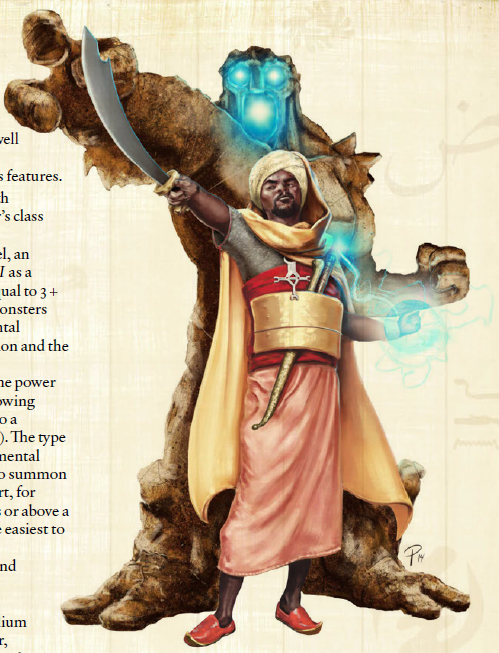
The Elemental Crusaders (Paladin) are known as the imajaghan* among the Tamasheq. They are warriors who draw their powers from elemental spirits instead of the typical angelic/celestial entities. They gain the ability to cast Summon Monster for elementals whose power is based on their paladin levels, as well as the ability to have a constant elemental whose size and type grows based on level. The Crusader has to give up disease immunity, mercies, channeling positive energy, and the divine bond/mount, but overall this is a worthy trade due to the versatility of elementals in combat and utility adventuring.
*Apparently this is a real word, although the only English google search result I could find was a performance of an Amazigh tribal dance and a Kobold Press article on said paladin archetype.
The Havoc Runner (Fighter) is the other gnoll-specific archetype, who has the Coordinated Maneuvers bonus feat as the Gnoll Raider, a level-dependent bonus on all Appraise checks and the ability to use said skill as swift or immediate action, bonus movement which can be made only before attacking a foe, and the ability to impose attack roll and movement speed penalties on enemies you attack provided you spend each round attacking a different foe.
Finally, the Janni Master (Summoner) gains a janni companion as an eidolon who is stored inside a lamp or similar object. The janni gains new abilities much like an eidolon, although their feats, spell-like abilities, and special powers are more or less already chosen ahead of time. This feels a bit underwhelming in comparison to the sheer versatility of the base summoner’s eidolons. The janni is a mobile fighter, gaining things such as a fly speed, feats such as dodge and weapon finesse, spell-like abilities such as invisibility, enlarge/reduce person, etc.
This chapter’s only Prestige Class is the Claw of Sepenret, which is synonymous with the order of the same name. Its prerequisites are easy: 5 ranks in Knowledge (Arcana), Knowledge (Nature), and Survival, must have a neutral aspect in your alignment, and be sponsored by another Claw. Their class features are rather specific to the organization, such as the ability to cast locate object but for Pieces of Ulthar, cast spells involving plants as one level higher, the ability to transform into a lion or dire lion, etc. Additionally, there is a grab-bag list of class features known as Boons the Claw can take in lieu of a caster level increase: most of them grant the ability to cast a pair of themed spell-like abilities such as longstrider or pass without trace (Boon of Striding), the ability to treat your melee attacks as certain types for Damage Reduction purposes, and the ability to teleport at will one-way to Sepenret’s temple if you have a Piece of Ulthar in your possession.
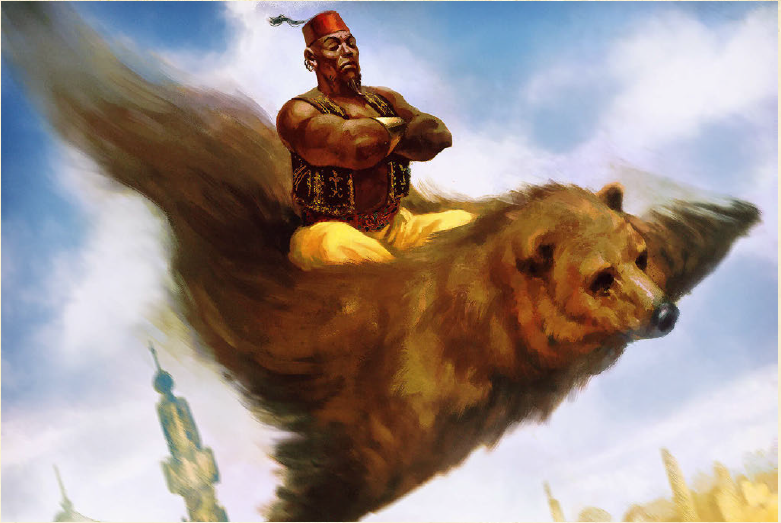
The Spells section is modest. They include Conjure Oasis and Storm Shelter which summon a lush body of water or energy field respectively to protect you from the elements, and four spells known as Air/Earth/Fire/Water Leap which allow you to teleport up to 30 feet within line of sight as a swift action provided you are in physical contact with said element before and after your teleportation. As you can imagine, Air Leap is going to be the most useful to the average party.
We end things with some new Magic Items. Most of them are carpets and tapestries woven by nomad artisans. In addition to the iconic flying carpet we also have interesting items such as a Bearhide Rug which can make claw and grab attacks, or a Mindweave Rug which plays out a scene from your memory and grants a +5 bonus on Knowledge or Perception checks to remember details of that scene. We have a few non-tapestry magic items such as an Awakening Rod which conjures a spirit from a natural feature as a summoning spell, a Harnessing Belt which merges your physical body with a summoned or willing outsider, and a Turban of the Desert Waste which allows you to meld into sand and create a livable pocket space within a dune or sandy location.
Thoughts So Far: Although not as long or full of detail as Nuria Natal, the Dominion of the Wind Lords is nonetheless a strong chapter. The minotaur rebuilding project of Cindass and a lost tablet of Roshgazi are good adventure fodder, particularly the use of an insane artifact presiding over a maze city. I like how Golden Ulthar is a reverse Indiana Jones: explorers and adventurers traversing the land to return ancestral heirlooms to their proper place makes for a strong plot, and they even have a bad guy faction seeking to take over the Valley for control of its powers.
I also liked the new new rules options, particularly the Blessed Scamp and Elemental Crusaders. They felt overall balanced and had plenty of appealing options. This stands in marked contrast to the diamond in the rough Pathfinder mini-game of searching through uninspiring options for an ideal feat/spell/etc.
Join us next time as we visit the High Jungles, home to the floating city of Aerdvall and the troubled Kingdom of Kush!
Chapter Four: The High Jungles
Original SA post
Chapter Four: The High Jungles
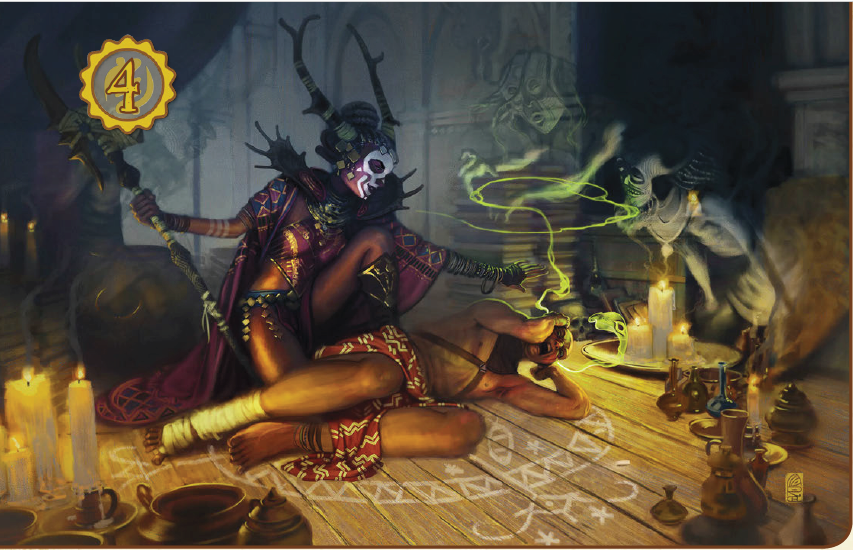
The High Jungles are directly south of Nuria Natal, and is in fact where the mouth of said country’s famous river is located. The rainforest is properly known as Yawchaka, the Living Jungle of Kush, due to the malign influence of the Green Walker. But these are not the only features of this verdant yet dangerous realm.
Well of Urd
A high plateau known as the Black Lotus Mesa reaches out over the High Jungle’s northern lands. It is an extraplanar crossroads home to a demiplane known as the Well of Urd. The portal hangs in the open air from which pours out the Celestial Waterfall. The Well is actually part of the plane of Loom, home to the great tapestry of the Fates (also known as the Norns in northern lands). The Three Sisters are stand-offish, using the Well as a secret haven open to some gods who use the place as a meeting ground. But even these deities are sworn not to reveal its location to the others.
The Well is actually self-aware and its waters help feed the World Tree’s roots. The spring is made unformed potential made manifest from which all reality springs. Those who willingly submerge themselves can change their life choices, effectively retraining classes, feats, etc without time or gold piece cost. Such power comes at a price, requiring a special d20 roll whose DC increases the more aspects you retrain; failure causes the person to instantly reincarnate into a different form as per the spell or have one of their aspects randomly changed.
One of the World Tree’s roots encircles part of the Well of Urd, curving up into infinity to the rest of the planes beyond. The root is covered with innumerable runes or spindle-threads (depending on the viewer’s cultural beliefs regarding fate) telling the destiny of all. The Three Sisters guard this area jealously, only allowing outside eyes in times of the greatest importance.
Black Lotus Mesa
The mile-high cliffs that form the Black Lotus Mesa contain an isolated environment home to some of the strangest creatures and terrain of the continent. The Celestial Waterfall covers the mesa in thick marshes and jungles, home to magical storms and abominations spawned from the Well’s myriad possibilities. The land is also home to lotus blooms containing great magical power; found nowhere else in the world, they are highly sought by all manner of mages, merchants, and alchemists.
The book encourages the Game Master to apply all manner of templates to monsters found here, ignoring typical racial and physical restrictions to create some truly alien beings. Notable locations in this isolated realm include a titan-carved series of terraces known as the Pillared Stair, ruined towers home to immense tunnel systems built by an unknown civilization; and the Nurian Falls which form the source of the River Nuria mixed with the spring melt of nearby mountains. Besides the mutated life, the mesa is home to several tribes of sentient white apes, a lost Ramagi colony, and marsh-dwelling humans known as the Bangweulu who can be friendly to outsiders provided they do not bring violence upon their homes.
Sky Nation of Aerdvall
Even more isolated than the tall cliffs of the Black Lotus Mesa, Aerdvall is a literal floating city-nation comprised of open-air towers and domes kept aloft by a unique form of arcane magic known as aeromancy. Aerdvall’s population are refugees hailing from the distant nation of Sikkim, and the city orbits the Celestial Waterfall as its primary water source. Judging by a Google search of several names and terms (Farhad, Athravan, Dakhma, etc) the people of Aerdvall are Fantasy Counterpart Persians. They worship some of their own deities taken from Sikkim but have adopted a few Southlands gods under new masks and names (Bastet is known as Oyuh Windqueen, for example).
Aerdvall’s standard of living is extremely high; basic necessities are universally available, a series of aqueducts fed by the Celestial Waterfall give people the benefit of indoor plumbing, and most citizens have enough spare time to devote to myriad pleasures. The foundations of the gleaming walls and beautiful parks are kept clean and in working order. But it is a conservative society which pines for the glories of their Sikkim past and is ruled by a tight-fisted Council comprised of mages from Aerdvall’s top magic schools. Said council controls citizen’s level of education as well as their access to appropriate forms of magic, and thus can keep the population dependent on them for social ascension. In recent years an insurgent group known as the Whispers of Irkalla arose to foment unrest, which in turn resulted in the Dvatara Guard gaining more wide-ranging disciplinary powers. The Whispers are said to worship a god of the same name, a bird-headed deity known for roguish and wizardly pursuits (it’s Thoth!).
Kush, Jungle of Abominations
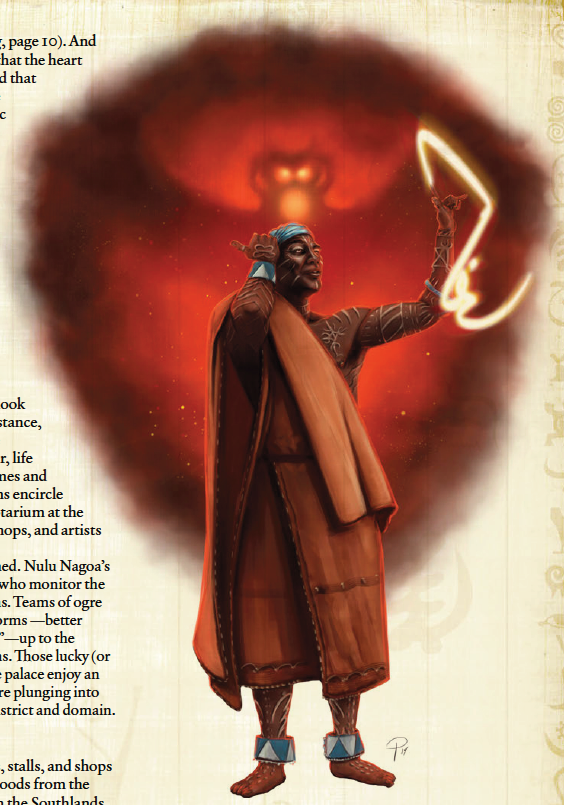
In the old days Kush’s neighbors respected the kingdom for its kindness and honor. Now such sentiments are but scribe’s memories. The devastation wrought by the Green Walker changed the face of the land forever. When it appeared that their druidic leaders had failed, the people made pacts with demons and devils of the Nine Hells (in Midgard the political divide between the two fiends is nonexistent) to save and rebuild their nation from the abomination’s still-active remnants. Ever since the fiends ruled the rainforest kingdom through Nulu Nagoa, an immortal lich archmage. The culture was reshaped to encourage selfish power-climbing where those with the proper strength and connections are free to do as they please to whose weaker than themselves. Kush’s marketplaces and academies teem with forbidden items and magic from other planes.
Kush’s capital is Nangui, the City of Sorcerers. Its foundations are built upon the stump of a former World Tree, an extraplanar breach of one of Yggdrasil’s branches which can be used to traverse the planes. Nangui’s streets openly teem with demons, devils, and other outsiders of a similar moral persuasion. These monsters receive preferential treatment over the city’s mortal inhabitants. Encroaching vines from the Green Walker’s’ influence are kept at bay by sorcerers managing the city walls, and the Nangui’s wealthy live in the higher Branches District which also houses Nulu Nagoa’s dreaded Necrotarium. In addition to the typical things evil undead overlords do, the archmage’s riskiest and greatest research to date is to find a way to control the Green Walker itself.
Note: For those who read my Midgard Worldbook review, you may notice some similarities between Kush and the gnomish nation of Neimheim. Both were forest realm existentially threatened by a great evil, and both made a desperate deal with infernal forces to save themselves. I find this interesting conceptually: most fantasy settings have the “deal with the devil” the result of naked ambition or revenge. But in Midgard the demons and devils are making pacts with people who have literally nothing to lose, those on the verge of genocide.
Yawchaka, the Living Jungle of Kush
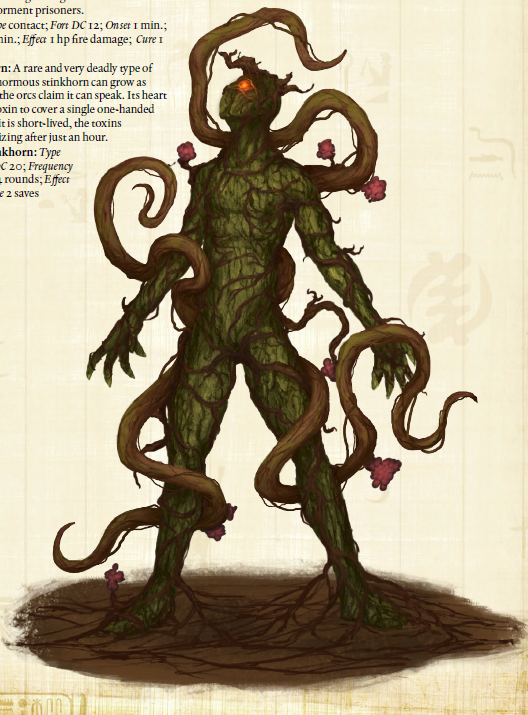
Kush’s rainforests teem with life, but much of that life is bound in service to the Green Walker. The eldritch abomination’s form towers well above the tallest treetops and can be seen from Nangui’s walls. Natives and visitors alike discover new species of plant and animal life regularly, and many plants possess actual sapience. But the most feared creatures of all are the vine lords, bipedal humanoid-shaped plants of great magical power. They receive direct orders from the Green Walker to deposit spores throughout the jungle and lands beyond. Those who pass too close risk infection by the spores, which the vine lords use to mentally dominate the carriers and in turn allow the Green Walker to puppeteer them.
The Green Walker itself is a titanic being composed of writhing vines, moss, and all manner of flora. Its six “legs” are giant tendrils of vines, and massive seed pods grow and burst on its back daily. Utterly bizarre and dangerous creatures lair under its shadow. The druidic ritual holding the Green Walker in place slows down time to the point it is practically frozen, but the monstrosity is still very much mentally active. Those brave enough to establish mental contact and avoid going insane can even communicate with it, although the Walker always responds with some iteration of “grow, I must continue to grow…”
Divine Spark: The titan Alkush granted his spark to the druids of Kush, who expended it in the ritual to bind the Green Walker. If Alkush’s spark is extracted, this would free the eldritch abomination to resume its campaign of devastation.
Beyond the Walker’s monstrous servants and the Kushites, the only other civilization of note is the Green Abyss, populated by orcs who lair deep beneath a giant sinkhole they call the Hungering Craw. The orcs are very much like typical fantasy ones, enthralled to violent warlords who spend time fighting each other as well as the sinkhole’s unknown monsters. I suppose this breaks the “primitive natives to kill and loot” trope I mentioned earlier, although if it’s of any consolation Midgard’s orcs are rare to the point of nonexistence.
Finishing this section is a detailed look at the infestation of the vine lords’ spores. It is treated much like a disease which progresses in stages. The first stages are pre-physical symptoms, where they unknowingly share their senses with the Walker and in turn can be affected by a suggestion spell to pursue the Walker’s needs and goals. The next stage manifest in vein-like bulges accompanied by murderous blackouts marked by lost time, and the host only needs sunlight and water to survive. The final stage has a massive tendril completely control the infected’s body in a zombie-like manner, subsuming them entirely to the Green Walker’s will.
Hazards of the High Jungles and Adventure Seeds
This very short section provides new diseases, hazards, and a random encounter table for Kush along with three adventure seeds. The flora is the most interesting section, which are more or less treated as traps: they include ihlamvu flowers which can siphon/absorb ranged spells but explode when overloaded with energy; or the akataan weather melon which sends out violent cyclones of wind when they burst open. The three adventures include a dwarven elder’s will asking them to deliver his corpse to the fallen city of Haldaheim (ruined dwarven city within the Green Abyss); Siwal’s sultan offering to pay the PCs for plants from the Black Lotus Mesa, only for one of the Green Walker’s puppets to ambush them at court when they return; and an obsessed scholar from Nangui seeking to find an extraplanar portal on the mesa but is actually the pawn of a devil seeking to enslave the mesa’s inhabitants.
Character Options of the High Jungles
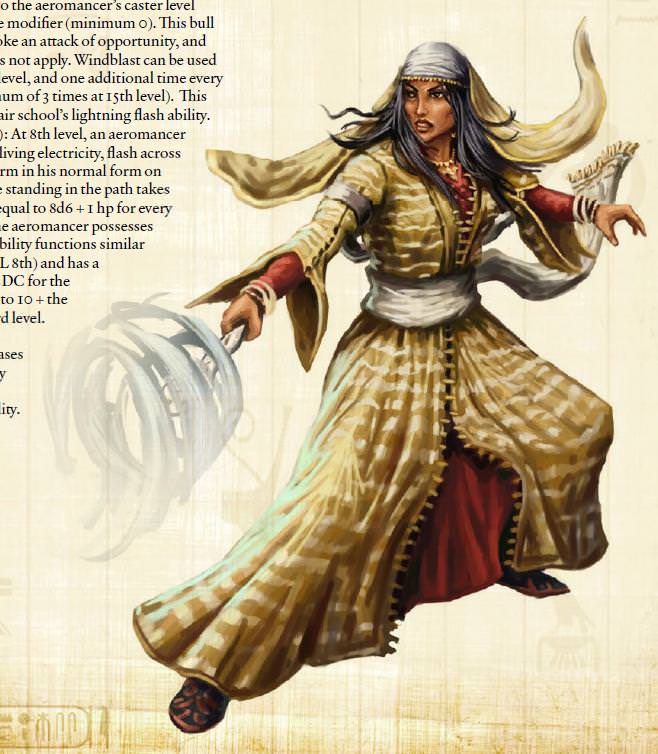
This chapter contains only one new archetype, the Aeromancer (Wizard). Solely found among Aerdvall’s citizenry and those with ties to them, aeromancers channel unique powers through devices filled with the Celestial Waterfall’s essence to power their elemental magic. They must specialize in the air elemental school and choose earth as their opposition school. In lieu of the Scribe Scroll bonus feat they can draw mystic water from ley lines which is used as a material component for their special abilities; they start play with and can create a device known as an aerosphere which acts similar to an arcane bonus; and can spontaneously convert prepared spells into spells from a special spell list of air and wind magic. And these are all gained at 1st level!
At 3rd level they trade in the air school’s lightning flash for windblast, an AoE cone of wind which can bull rush those within its path. At 8th level they trade out the air school’s cyclone ability for the ability to transform into living electricity and damage those they “jump” through in a 120 foot line (400 feet at 15th level).
This is a pretty strong archetype; the spontaneous trade-in spells are a good variety of offense (shocking grasp, just of wind, lighting bolt, etc), utility (overland flight, liquefy air, whispering wind, etc), defense (elemental body), and battlefield control (obscuring mist, wind wall, etc). The windblast and lightning rider abilities are both cool-sounding and effective. The mystic water and aerosphere are a bit weak in trade-offs, but given that their utility is determined by down time this is not too out of line for wizards in general.
Our next section covers Demonic Items from Nangui. Some of the more interesting ones include chaos stones which bestow random effects on those within its blast radius (akin to a rod of wonder); ashes of the fallen grounded from the remains of celestial creatures which impose spellblights (magical disease-themed spell debuffs) on those covered with it; and an ocular earring which can transfer the voices of the person whose name you utter to your ear if said person fails a Will save.
Lotus Magic covers the latent powers of the lotus blooms fed by the Celestial Waterfall. They are magical drugs with a high rate of addiction (DC 25 Fortitude save) but grant spellcasters magical benefits for 1d6 + the caster’s constitution modifier in minutes. Noncasters instead gain bonuses or roll twice on saving throws versus the lotus’ themed spells and similar effects. Alternatively they can be used as a material component for certain spells for 24 hours before their magical properties disappear. Prepared doses can range from 500 to 2,000 gp on the open market (half if you brew them yourself with Craft-Alchemy). We have 8 different types of lotus which are themed around each school of magic save abjuration (the Tchopho Lotus keys to psychic spells or spells involving dreams or sleep).
Overall the lotus plants are powerful albeit slightly situational. For example, the blood lotus grants +1 caster level on evocation spells and +1 damage for each damage die of said spells, and 20 temporary hit points used to absorb spell damage. It may be used as a power component for enlarge (+15 foot to movement speeds for enlarged creature), rage (additional +2 STR and CON), vampiric touch (impose 2 bleed damage on target and gain fast healing equal to sum of all bleed damage of targeted creatures) and weapon of blood* (grants weapon dancing quality).
Some of the individual power components can be pretty effective: the Ingqondi Lotus (conjuration) allows Planar Ally spells to treat the beseeched tasks of called creature as strongly aligned with its own ethos regardless of their actual nature, while the Amber Lotus (enchantment) allows the requests of suggestion and mass suggestion spells to make unreasonable but not immediately harmful suggestions.
*a spell from another Kobold Press book, Deep Magic.
I like the lotus magic, mechanically and thematically. They are a bit expensive, but when compared to potions their gold piece value is reasonable. The main problem is that as poisons the lotus plants impose minor ability score damage specific to that plant (indigo lotus imposes 2 wisdom damage for the effect’s duration) which may make certain plants less useful to certain casting classes.
Spells from the City of Sorcerers is our final entry in this chapter, focusing on the macabre magic developed by Kush’s mages. There’s six of them, which include bloodknife eruption (ray wounds a target and explodes in a burst of damaging blood to deal half damage to nearby targets); fling skull (exploding throne skull which deals bleed damage); mangle limbs (impose STR/DEX and/or movement speed and drop held objects): song of seduction (cause creatures within radius to move to you like a siren or harpy’s song); sunder barrier (deal sonic damage to a barrier or portal and those nearby); and weeping wounds (suffer 1 bleed damage for every 10 damage the target is below maximum hit points).
Thoughts So Far: The High Jungle is smaller in scope than the previous two chapters, with a majority of it focused on Kush and its environs. But I have to give it props for the cool floating city and related air mage archetype. The Well of Urd and its connection to the World Tree and sisters of fate felt rather Nordic than African in feel even if it ties in to the Midgard sister setting. Kush is a stereotypical “evil magocracy” but the sheer creepiness of the Green Walker and the fact that it sees through the eyes of the infected and much of the rainforest provides some perspective on why many of the kingdom’s inhabitants may view their government as a necessary evil.
Join us next time as we travel along the Southland’s western coast, visiting the Kingdoms of Salt and Steel!
Chapter Five: The Kingdoms of Salt and Steel
Original SA post
Chapter Five: The Kingdoms of Salt and Steel
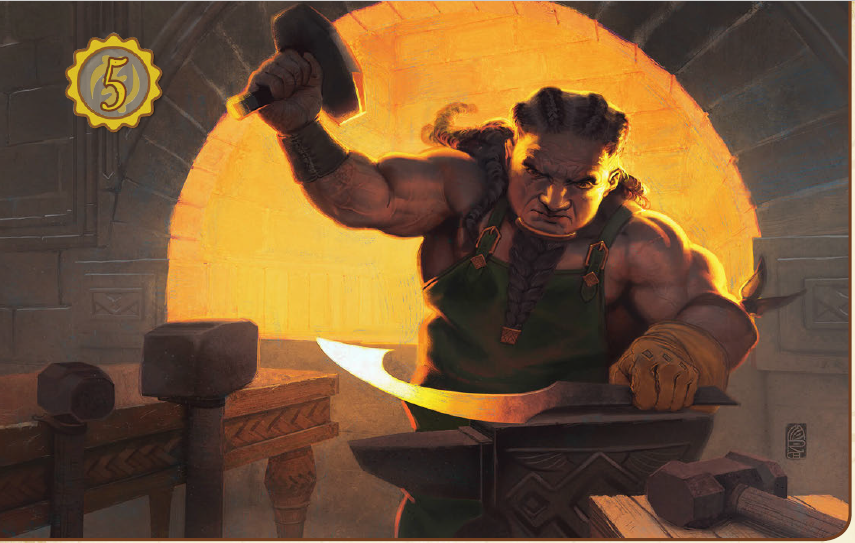
Our past few chapters covered nations with explicitly supernatural means of leadership. Nuria Natal’s god-kings, the Dominion’s elemental rulers, and Kush’s archmage lich and the demonic forces pulling the kingdom’s strings. The nations along the Southland’s western coast depart from this; although no stranger to their own wonders, their rulers are mortal. Magically proficient mortals who may have a divine spark, but the four kingdoms of this chapter are run by humanoids, for humanoids.
Sebbek Sobor
This dwarven-majority country claims descent from the refugees of Haldaheim, a marvellous city brought low by the Green Walker’s ascendance. The refugees fled into the land between Lignas and Narumbeki, and struck a deal with the latter group to provide weapons and armor in exchange for land. Sebbek Sobor’s government is balanced between a pair of elders from each city and the Conclave of Brotherhoods, the latter of which are comprised of noble, clan, and guild leaders. Both groups have checks and balances to temper the other’s power, and neither side is stranger to ambushes and feuds to get some resolution passed. The Brotherhoods representing various artisanry disciplines are the most powerful, while the martial Brotherhood of the Axe provides much of the country’s armed forces.
Sebbek Sobor’s world-famous crafting is not solely to the credit of dwarves. The Brotherhood of Embers creates pacts with bound elementals to provide their labor in exchange for tasks, items the elemental likes, and in some rare cases the freedom to roam Midgard to a limited degree. Given the natures of elementals, this results in more than a few angry farmers complaining about damaged crops, but the Conclave hems and haws given how vital the elementals are in powering forges, wind and water-driven devices, and other such technology.
Sebbek Sobor’s most popular location for foreigners are the Trade Tents, temporary marketplaces which spring up during the summer months. Coins are not accepted as a viable method of exchange, with all business done via bartering physical goods from metalwork to magical items. We also touch on the dwarven practice of golem-making: although such constructs are primarily used as wardens and sentinels in cities and trade routes, the Brotherhood of the Chisel treats their work as an art form, giving elegant and stylish yet functional forms to their creations. Golemwrights are constantly pursuing new methods of innovation and aesthetics, motivated to stand out among an already-gifted pack.
Lignas, Land of Serpent Scholars
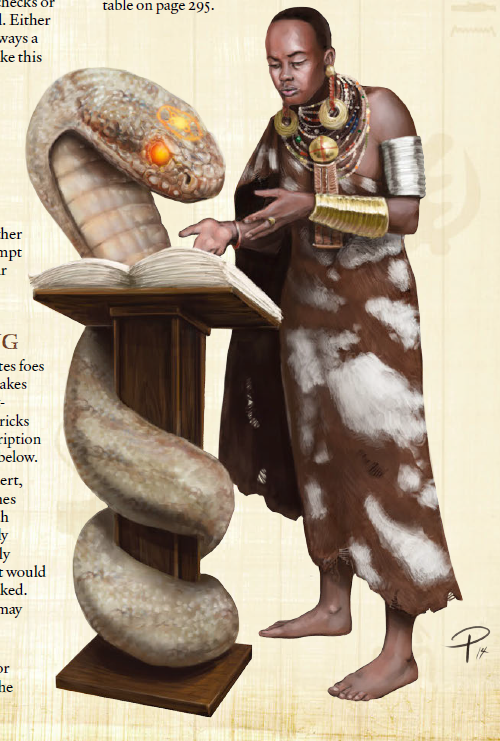
This tropical rainforest kingdom still stands as a center of lore and trade since its founding, although it is not the most hospitable to visitors. Lignas’ capital is the same name as the country and is ruled by a theocratic dictatorship: the Coil of Memory is a public religious spy agency which pursues intelligence and mysteries of the world as a means of divining existence. But this knowledge is not free, for its membership grants access of religious lore based on seniority. It is believed that the Coil’s heart is dedicated to moon worship where members are “gifted” with transformation into monstrous lamia.
Divine Spark: Its aristocratic head has a tradition where one can only ascend to the throne by assassinating the previous ruler. This is because the first queen of Lignas betrayed and killed her own titan ruler, absorbing the spark for herself. The nature of the spark is that only ritual assassination transfers its powers to a successor. Spirits of past rulers are bound to their skulls and serve the current queen, Mwato Yaav, as advisors.
The city of Lignas proper contains one of the last preserved remnants of Glorious Umboso’s architecture. Huge cyclopean walls and structures of stone bend and curve in impossible ways as though they were liquid streams frozen in motion. Numerous smaller human structures and dwellings surround these walls. Canals, aqueducts, and barges serve to manage riverbound travel and feed its fertile farms. The mighty Selwheyha River cuts through the metropolis all the way to the sea, but boatmen never travel that far due to legends and tales of a vicious sea monster living at the end.
One of Lignas’ two notable locations includes the Tower of the Scaled Fellowship, the headquarters of the Coil of Memory. Libraries, laboratories, classrooms, and vaults brim with jealously hoarded power. Layers of magical, architectural, and physical security make it one of the hardest places in the Southlands to break into, but the repository of magical spells and secrets makes it a tempting target nonetheless.
The other location is the Scroll Market within the city’s outer slums. A network of shadowy doorways and magical huts designed to disappear at the first sign of trouble serve as a black market for untested and smuggled magical contraband of the Coil of Memory’s scribes. Untested alchemical concoctions are also for sale, to varying levels of quality. Merchants and customers alike are expected to arrive masked for anonymity.
Kingdom of Morreg, Land of the Ancestors
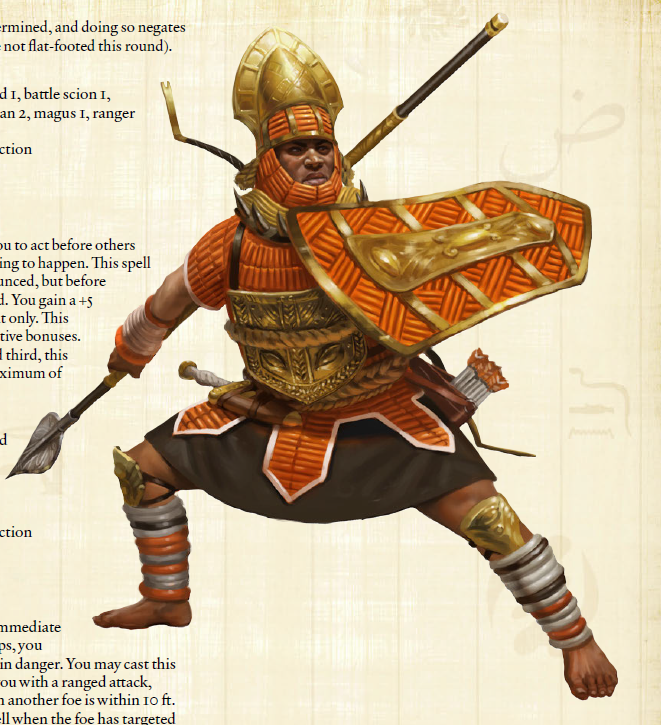
One could claim that every inch of Morreg’s countless hills and valleys are being monitored, and it would not be far from the truth. Its tiered, stonework cities and towns contain numerous multi-level excavated rock structures connected by open-air bridges spanning deep trenches. Aside from this architectural uniqueness, the day-to-day operation of settlements appears normal on the surface. But the Morregi have a radically different sense of privacy than most foreigners, for unrestricted use of divination dominates daily life. Auguries are cast before most activities to ensure the favor of the fates, while some citizens scry on their neighbors to keep tabs on them.
The reason for this is that the government encourages its citizens to be abreast of their surroundings and on the lookout for threats in the name of national security. Some of Morreg’s elite forces even preemptively interfere against individuals and communities beyond their lands in a Minority Report fashion, their state seers predicting future dangers before they arise. Or so the kingdom claims.
Morreg’s government is ruled by a hereditary king known as the High Saaxir as well as 100 officials known as the Mhondoros Council. While technically elected, the Council members are appointed after a complex divinatory process, leading Morregi to believe that their rulers are destined for their roles. But the Council has its own political factions who have mutually conflicting agendas. Currently the major policy on the minds of the heads of state is preparing for war with Lignas.
Divine Spark: The High Saaxir holds the spark of the titan Amhara in a bejeweled orb. Said spark grants the king the ability to create Living Reliquaries, although it is believed that one who absorbs it directly into their body will gain unlimited oracular abilities. Although it is a rumor rather than a mechanical ability set in stone, the book suggests the ability to cast all divination spells at will is a possibility. Besides the potential insanity that would come from unlimited knowledge, there is a difficulty in stealing something when Morreg’s greatest seers already predicted your plan in action.
The other notable feature of Morreg is the practice of creating Living Reliquaries known as “ruuxa.” Morregi culture reveres the wisdom of the dead in the belief that they can see things the living cannot; the most valued citizens are chosen for the honor of becoming ruuxa. At the moment of death, the candidate’s skull is removed, their spirit bound to it, and placed into the carved recesses of one of the many obelisks dotting the countryside. They can converse with passing citizens and also strengthen the power of divination spells: this manifests as granting +1 Caster Level on spells of said school cast within the nation’s borders, or +2 (non-stacking) to those cast within 60 feet of an obelisk.
Morreg’s capital, Akxuum, holds the Gray Tower. Here wizards and oracles are taught the arts of combat divination and the powers of arcane archery. There is also a black market which sells magical items that protect against divination spells; its location moves regularly to evade the reach of the authorities.
Narumbeki, Shield of the South
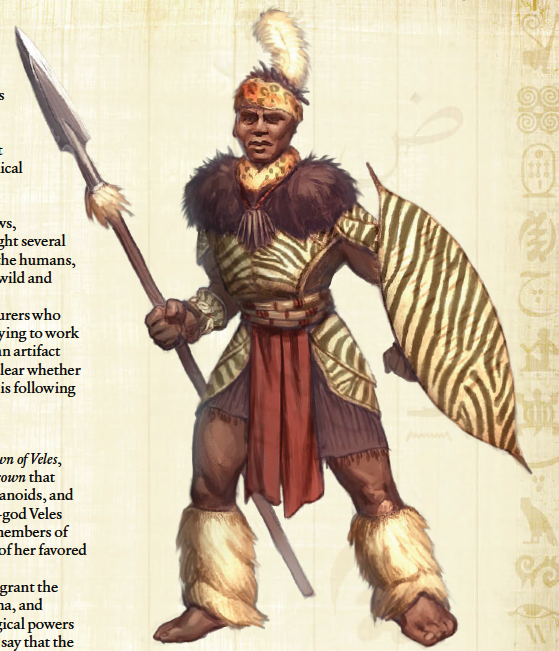
Within the vast grasslands northeast of Lignas and southwest of Kush lies one of the Southlands’ mightiest warrior societies. In the era of Glorious Umboso the titan Mwari pitted Narumbeki’s ancestors against simulated armies of other titans for recreational sport. After said empire’s fall the Narumbeki scattered among the savannahs as a warrior culture. The tribes united into a more organized fashion as a counter to Morreg’s ascendance and became experts at organized large-scale warfare.
Narumbeki society is highly militarized and analogous to Fantasy Counterpart Zulus. At age six a child is trained in the Legions as a messenger and apprenticed in combat at age twelve. Their society is semi-nomadic, with most settlements being a series of enclosures surrounded by thorn-decorated fences and muddy palisades known as kraal. Larger towns and cities are known as akanda, serving as the headquarters of individual Legion organizations.
One of the current campaigns of Narumbeki is keeping the Green Walker’s influence from spreading to the plains, and there are always at least 3 Legions maintaining the border with fire and spell. The literal scorched earth tactics christened the Narumbeki-Kush border the Burning Fields.
The Narumbeki Legions proper are organized into hierarchical regiments, with a logistical command structure where smaller forces comprise larger formations. For example, a squad is made of 6 soldiers, while 12 squads form a shield, all the way up to an impi of 864 warriors. Their base ranks have armor and shields made from zebra-hide and spears for melee combat.
Beyond foot soldiers the twelve Legions are divided into four groups of three. The Fire Legions use arrows and a unique alchemical poison known as naphtha to soften enemy ranks; the Wind Legions are the fastest warriors capable of traveling great distances; the Stone Legions focus on defensive maneuvering; while the Imbangala are a cavalry supplement of sorcerers who mastered magic to domesticate zebras. Zebras both in real life and in the Southlands are too ornery to be broken like normal horses. These “cavalry casters” know the secret to their domestication and these sorcerers are capable of using a wide variety of spells beyond their discipline, yet another set of mysteries outsiders have not yet solved.
Every Legion pays homage to the High Warlord, or Mukani, who settles affairs on a national scale and coordinates military campaigns requiring the alliance of multiple tribes. The current Mukani is Ebo Adashe, whose recent decisions have caused doubt, from expelling Lignan ambassadors on charges of spying to breaking treaties with the gnolls of Dabu. The reality of the situation is that Ebo has been infected by the Green Walker’s spores and is a puppet to a vine lord.
Divine Spark: Each Mukani passes down Mwari’s spark to the next in line. The spark grants the ability to imbue sorcerers with spells outside their normal tradition. Anyone who has the spark would have total access to the spell lists of every class, but will be hunted to the ends of the world by the Legions if they are not first burned alive in an outpouring of raw magic.
Perilous Sites
The Kingdoms of Salt and Steel may have a surplus of well-defended bastions from Narumbeki warbands to Morregi diviners, but it is no stranger to swathes of dangerous territory. The most notable are the temple ruins of Ankrhimari, home to a naga lich known as the Whisperer of Shadows. He is currently excavating the place in search of an artifact known as the Black Crown of Veles, said to grant dominion over the dragonkin races. It is said that Veles the World-Serpent himself created at least three such crowns to allow the “hairy races” some degree of protection from his favorite children.
There is also the Dunhumadzi, the largest mountain in the western portion of the continent containing a rumored titan stellar observatory; the shadowy Ezana’s Stone in Morreg’s southern border home to a mage silhouette who answers questions posed by visitors, albeit at the price of only giving answers he believes will cause the most misery possible; the Lost Diamond Caverns home to a clan of crystalline demons; and the Stone Bird Grove, whose eponymous statues come to life to guard a rumored treasure against intruders.
Character Options of the Kingdoms
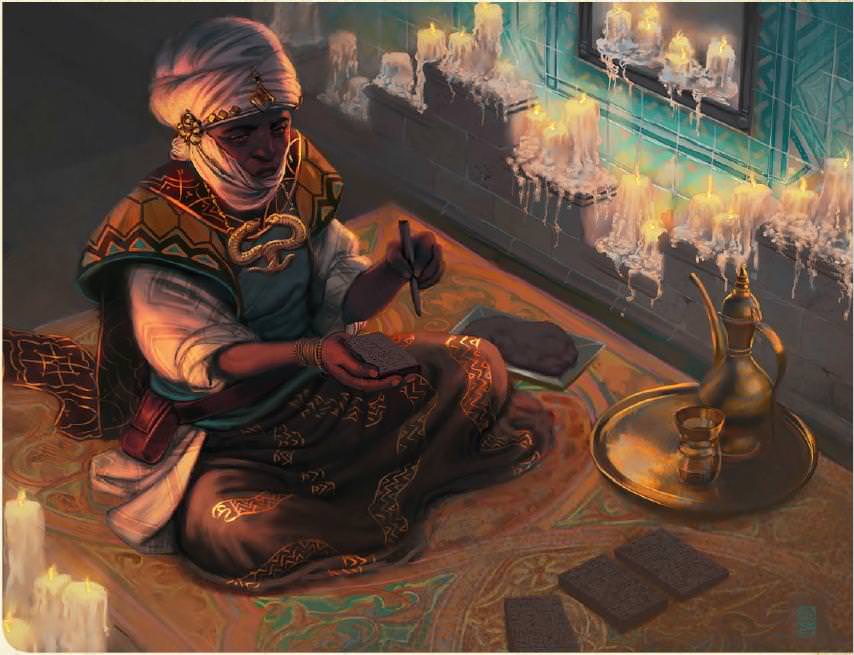
The player-facing options of this chapter are more numerous than the previous chapters. Starting off we have five new archetypes. The Arcane Sculptor (Summoner) trades in their eidolon for the ability to build and maintain animated objects or clockwork creatures.
The Cavalry Caster (Sorcerer) trades their bloodline arcana and bloodline spells for the ability to learn a small number (1 spell every odd level) from another class list, not have to roll concentration checks for riding, and gain some mounted combat related features such as being able to summon a supernatural mount or gaining bonuses on ranged touch attacks when you make a mounted charge.
The Deep Explorer (Rogue) is the prototypical underground explorer who gains favored enemy against aberrations in place of trap sense, the ability to make a single spelunking-related skill roll (Climb, Heal, Survival, Swim) on behalf of all allies within 30 feet in place of uncanny dodge, and a bonus on Perception and Dungeoneering Knowledge checks equal to half their rogue level in place of improved uncanny dodge.
The Jali (Bard) are patriotic Morregi who can read the threads of fate in battle via the use of combat divination. They can learn any sorcerer/wizard spell with a swift or immediate casting time, and they may spend a round of bardic performance to grant a one-use swift/immediate spell they know to every ally within 90 feet as long as they maintain performance.
Finally, the unimaginatively-named Tunnel Fighter (Fighter) are dwarves who join organizations of underground guards to defend their homes. They gain class features related to close quarters fighting, replacing their bravery bonus with an equal bonus on Acrobatics and Escape Artist checks, the ability to perform attacks of opportunity against those who try to grapple them no matter the circumstance, fight without penalty when squeezing or sharing a space with another tunnel fighter, flank as long as they and an ally are engaged in melee with the same creature, and a burrow speed of 5 feet at 11th level.
Next up we have a few new feats: a pair of item creation feats known as Master Sculptor (create constructs even if you’re not a spellcaster) and Master Carver (put 1/day spell-like ability hieroglyphic symbols on constructs) are neat, but the feat with great potential is Foresight Alacrity which allows you to perform up to two swift and two immediate actions per turn. This is really great, potentially overpowered even, if you are making use of the Path of War sourcebook or similar reaction-based classes and abilities. The only trade-off is that you suffer a -2 penalty on all rolls for that round, and the penalty increases by 1 for every consecutive round you use this feat’s benefits.
In a section all on their own, Tactical Feats are associated with the Narumbeki Legions. They are akin to teamwork feats in that they impart benefits for the whole party. They have a base Legion Training feat, and most have a hefty +8 Base Attack Bonus requirement, but they are overall pretty good. For example, the base Legion Training grants you a +2 bonus to your Combat Maneuver Defense; but you can also elect to have a +1 bonus and share the other half with all allies within 30 feet. If two or more characters have this feat, they can stack the “shared bonuses” on each other but the maximum amount is limited by said recipient’s character level.
This really simulates the “coordinated Zulu Warrior” feel of soldiers who are greater than the sum of their parts in that every other Tactical feat has more or less the same share-based fractional mechanics. The Tactical Step feat can grant a bonus 5 foot step, Accurate Thrust grants a base +2 on attack rolls with piercing weapons and can be split akin to Legion Training, Legion’s Fortification grants 20% chance to negate critical hits or sneak attack damage, and Legion’s Balm grants fast healing 5!
The rest of the section pre-magic has miscellaneous information, including the ability to teach new tricks to serpent-based creatures with Handle Animal, the dwarven-brewed naphtha alchemical admixture which is a poison that deals fire damage and can be detonated in large quantities, new poisons from Lignas and stats for war zebras (like horses but gain concealment when among others of their kind in close quarters), and a host of new African-themed familiars from lemurs to scarab beetles.
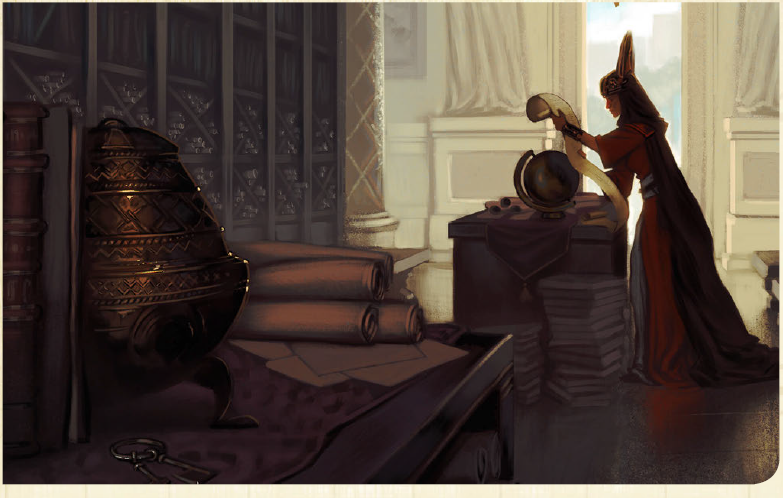
The Magic of the Kingdoms includes a host of cool new items and spells. We have magic items such as an Eggshell mask which can perform a suggestion spell as a gaze attack twice per day, a Narumbeki Mudzimu Figurine which can detect thoughts for hostile intent and transform into a stone giant to attack said threat, and rituals and incantations such as the ability to conjure Venomous Rain of Retribution to deal poisonous fire damage on a wide area, or Bind the Unwilling Adviser which is used by Lignas’ queens to bind spirits of the departed to your service along with all their non-physical skills and knowledge.
We have new generic spells, which are alternate versions of more conventional spells: Blood Pact calls an outsider to make a deal and you gain their damage reduction and vulnerabilities in addition to their service; Swarmshape Summon spells are like Summon Monster, but they summon monsters two levels lower on the latter spell chart who burst into swarms should they be “killed;” and Vipershot imbues your arrows with the ability to turn into vipers after they hit a target.
But the lion’s share of new spells are in a section of their own: the fabled Morregi art of Combat Divination! I should note that this is one of my favorite mechanics from the Southlands, both in concept and rules and how it covers a traditional weakness of the spell school in Dungeons & Dragons. You see, conventional divination spells are limited in use when the din of battle starts; the most iconic spells either require maintenance (detect magic and clairvoyance) or have long casting times (augury and clairvoyance). Combat divination spells are swift or immediate actions which allow the user to foresee enemy actions and movements in an “I saw that coming” style of foresight. They can be learned by many classes, even the less-arcane types such as bards and rangers get a few!
I won’t list all of them, but some of the cooler ones include Anticipate Attack ( take a 5 foot step to avoid an attack if you get out of its reach/AoE), Anticipate Arcana (gain Spell Resistance against an oncoming hostile spell), Distraction Cascade (cause an enemy to become flat-footed against an ally’s incoming attack on a failed Will save), Scry Ambush (can be cast during a surprise round to act normally and not be flat-footed) and Targeting Foreknowledge (cast after you make a successful attack but before damage, granting you +2d6 bonus damage and increase the critical multiplier by x1).
Thoughts So Far: The four countries were relatively brief in length, but I did not mind that as much on account that they more than made up for it with cool fluff and new mechanics. The divine sparks are starting to make more frequent appearances now, and just about every nation has its own tricks and local traditions to make PCs from that region stand out. Morreg has potentially the greatest difficulty in adventuring opportunity, as the huge amount of divination-capable citizens requires some unorthodox thinking by Game Masters to implement.
The new archetypes and feats were overall stellar choices. I really liked seeing “team player” focused mechanics pop up, from the Deep Explorer’s rolls for the whole party to the Narumbeki Legion feats and the Jali bard’s ability to grant limited spell use to allies.
Join us next time as we sail along the eastern Corsair Coast, visiting exotic isles and clashing sword and spell with pirates, slavers, and sealed demons!
Chapter Six: The Corsair Coast
Original SA postJoe Slowboat posted:
So, I'm pretty sure the city is meant to be Great Zimbabwe, especially given the river with sea serpents (a reference to the Nyami Nyami of the Zambezi, I think?) and the 'curving and cyclopean' walls of the city. Also the lush farmland. Zimbabwe's not generally forested but frankly I'm basically onboard with Lignas, snakes are good and Zimbabwe is cool.
In general the Southlands seems like a really good resource, if you specifically want to run Fantasy Africa-analogue in D&D's particular register.
edit: also if fire is the most effective weapon against the Green Walker, they must burn the weed a lot in Kush
Interesting fact; I did not know that about Zimbabwe. Although they are few in number, the Fantasy Africa centric D&D books I have read are quite stellar. Spears of the Dawn and Nyambe come to mind, the former of which I made an F&F for as well. Kingdoms of Kalamar has Svimohzia: the Ancient Isle, although I have not read that and cannot attest to its quality. Given that KoK is known for "low-magic medieval realism," I can't help but imagine it looking something like Kingdom Come Deliverance: Africa Edition.
Anyhoo, I have another chapter up for review!

Chapter Six: The Corsair Coast
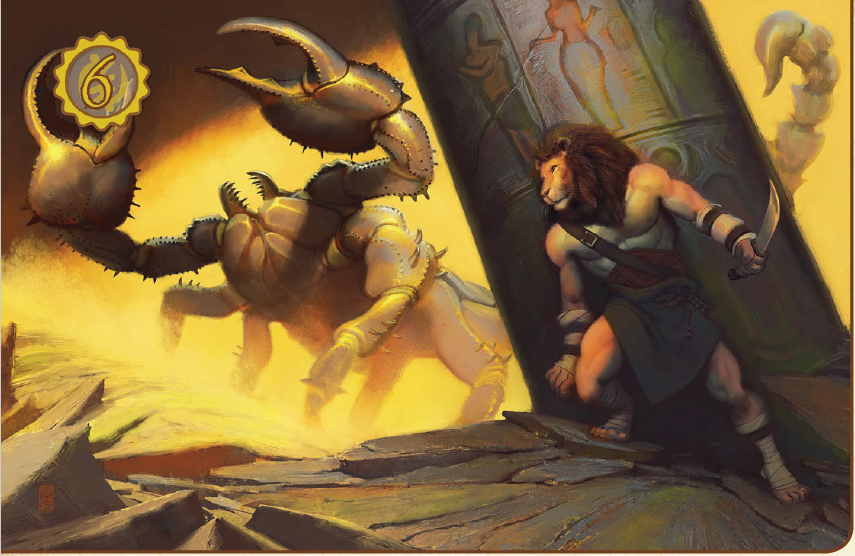
The Southlands’ densely-populated east is the heart of intercontinental maritime trade. Ships from Khandiria, Far Cathay, and the Mharoti Empire prize the Showka Passage for connecting them to western realms, and piracy on all sides is rampant. This region is more Arabian Nights in feel, calling upon Sinbad’s voyages with mythical islands of strange monsters and Near Eastern-inspired kingdoms such as Ishadia and the Sultanate of Shibai.
Ishadia
Positioned on a land-bridge connecting the Southlands and the Mharoti Empire, Ishadia is the second-most densely populated kingdom on the continent, standing at 9 million to Nuria Natal’s 13 million. A country of beautiful ruin, Ishadia’s marble halls portray angelic artwork and a minority of its populace bears celestial heritage as aasimar. Some of the buildings even contained portals to the upper planes, but now the country’s wonders stand inactive from generations-long war with the Mharoti Empire. As the only land-based gateway to the rest of the Southlands, Ishadia is of prominent importance for the dragon lords in conquering the rest of continent; as of now, the dragonkin have to make do with naval travel to get at the Southland’s riches.
Unsurprisingly most Ishadians are grimly deterministic and distrusting. They are proud of the fact that they stand resolute against the horrors of dragon fire and magic, but have few true allies beyond that of convenience against a common foe. Nurians, Lignans, and the people of the Fallen Kingdom of Asksaba (Sar-Shaba) are model minorities who the Ishadians respect from an advanced yet still foreign culture, but dismiss the rest of the Southlands as a savage and undeveloped realm. The Sultanate of Shibai was a former colony of theirs which declared independence, leading to skirmishes which may develop into full war.
Shuppurak is Ishadia’s holy capital, home to the Basilica of the White Lion. It is one of the oldest temples of Midgard, and holds daily rituals where mages cast mass versions of ability-enhancing spells such as bull’s strength to worshipers. Its reputation among the good-aligned religions is so great that people across Midgard undertake great pilgrimages here in great caravans. The city also holds the Grand Agiary, home to the Portal of the Heavens which leads to the celestial realms. Alas it is barred from travel except in direst need. The scholars of Kush possess an artifact known as the Oridian Papyrus, detailing a ritual to direct the portal to the Eleven Hells. Most Ishadi are unaware of this, but those in the know from Mharoti saboteurs to Kushite diabolists seek some way to take advantage of this forbidden knowledge.
Divine Spark: An order of lammasu patrol the flooded districts of the city of Khazephon, whose great dam was sundered during a Mharoti siege. The holy creatures are tight-lipped about their vigil’s true purpose: protecting the sacred flames still burning within the sanctums, for they house a divine spark split among them. A prophecy states that the spark waits for a true scion of Ishadia to unify it and sit upon the Phoenix Throne, leading the country to a new golden age.
Sar-Shaba, City of the Seal
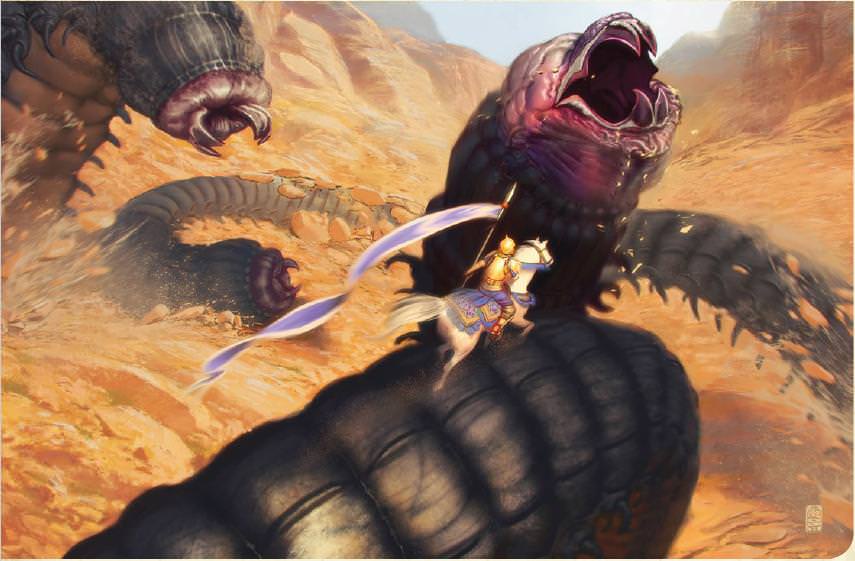
Thousands of angelic seals lay across the borders of this ruined city, for within lay a small army of demons. Sar-Shaba was once the capital of Aksaba, a grand nation whose nobility joined with the Ishadians in a mutual lineage which lead both kingdoms to an era of prosperity. But this would not last, for the Aksaban crown was violently seized in a coup by a demonologist named Harnoch-Khedan. He turned Aksaba into a feared yet powerful state, extracting tribute from the rich Spice Coast while its princes slipped into violence and decadence. The last king regretted the path of this country, and via a series of covert public works projects rebuilt sections of Sar-Shaba into angelic runes. Using the last of his magical power he summoned Aksaba’s demons into the city and trapped them within forevermore. He saved the rest of his now-crumbled empire, at the cost of dooming the people within the city for generations to come.
Now numbering a few thousand souls, Sar-Shaba’s mortals are caught between the Heirs of Harnoch, the noble scions still pledged to Sar-Shaba’s remaining demons and devils, and the more numerous common descendants of the Azadim and Makudai lines. The latter were raised with the responsibility of holding a never-ending vigil over the city and keeping the demons contained. Mortals are free to travel to and from the city, but the demons remain trapped and can act through mortal intermediaries. Thus the need for a group to keep tabs on them.
Those aligned with evil included Beltih Hamona, the Gilded Queen who holds dominion over Sar-Shaba’s treasury. She was cursed into a metallic form when battle-magic fused much of her hoard to her body in a newly-created infernal pool. There is also the Cult of Ru-Ur, insane humans who worship Ruhabulgog the self-declared general of the remaining demons. Ezudai the Hunter is a mad hermit wild card, seeking to slay demons and innocent mortals alike and as such is an unreliable ally at best. Finally there’s the Amunath, also known as the Blades of Punishment, vengeful spirits powered by unholy relics from a fallen angel.
Mortal Aksabans are divided between two ethnic groups: the Azadim who act as warriors and belong to one of two organizations: the Knights of Azhanael who maintain guard duty upon Sar-Shaba’s walls, and the School of Salvation who believe that redeeming the souls fallen to demon-worship is the best way of restoring the city. The Makudai are the other ethnic group and compose the majority of the city’s population: they are tasked with preventing mortal cultists from entering and exiting the city. Their two major organizations include the Queen’s Guard, who no longer serve such a noble title but instead devote efforts to rebuilding the city; and the Swords of Sanctity, an extremist faction who believes that cleansing the realm of all mortals bearing the Azadim heritage will end Sar-Shaba’s woes. As Harnoch-Khedan and his bloodline were Azadim, they hold them as possessing a sort of “original sin.”
The Spice Coast
Isolated from the rest of the continental Southlands by a crescent-shaped mountain range, the shores of the Viungo Jungle are known as the Spice Coast for its year-round fertile harvest. Home to the top producers of all manner of spices and similar plant-based flavorings, its civilizations are split into autonomous farming communities known as zinjs (singular zinj). The zinjs are managed by rich agricultural companies whose labor force is comprised of slaves taken from all races and whose produce is sold across the Southlands and beyond. Ishadia, Shibai, and the remnants of Aksaba claim rulership over various zinjs, but their rich capital and relative isolation means that they can operate with relative impunity. Five beys, or leaders, more or less rule the Spice Coast, all competing against each other and undertaking raids and economic skullduggery to expand their own lands. All but one of them are your typical ruthless businessmen types save the dwarven paladin Gunnar Von Grisal, who operates his zinj as prison colonies using Ishadian convict labor instead of relying upon chattel slavery.
Naturally the Spice Coast’s beys have few allies. Even if they have lots of money, slavers and slave-hunters are not respected professions in much of the Southlands. Many pirates operating out of the Free Isles of Tethys love to conduct raids against the zinjs, and there’s a covert group of rebels known as Azadi who operate a network of safe houses and smuggler’s dens to help runaway slaves.
Free Islands of Tethys
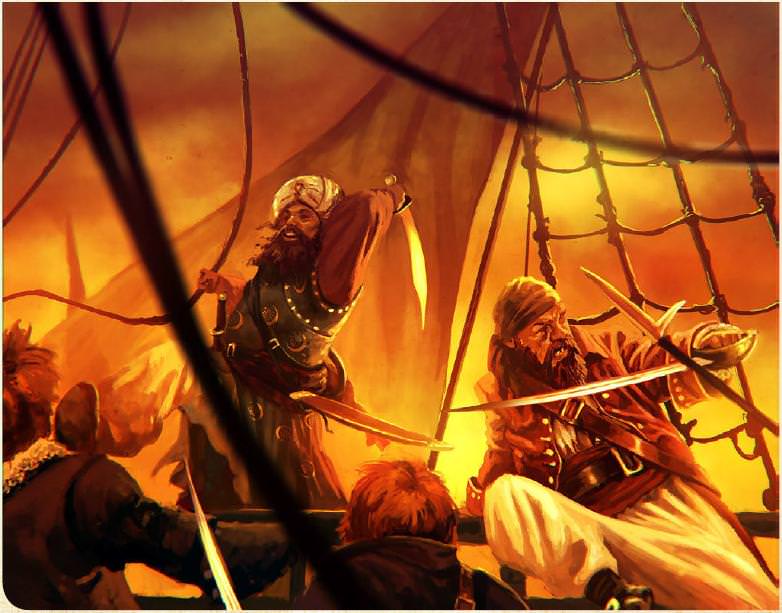
This long chain of tropical islands hangs off the eastern coast of the Southlands. No single government or power group lays claim over its majority, making it a favored stop for all manner of pirates as well as sahuagin and merfolk tribes. Most of the “communities” here are fleets of vessels of varying loyalties, and the only mainland port which regularly trades with the Free Islands is the rowdy city of Mhalmet. Also known as the City of Freedom, this pirate-run community is governed by a council of raiders, swashbucklers, and thieves who collect taxes in the form of protection money from all manner of vessels. Mhalmet is also home to a social club of explorers and big game hunters known as the Sandalwood Club who use the community as a base of operations for future expeditions into the Southlands proper.
The three most notable fleets of the Free Island are as follows: The first is the Istagal Raiders, former slaves who wage a war against all those who would put others in bonds. They make liberal use of weather magic to grant concealment and mobility to their ships, and an alchemist among them recently invented a catapult shot which releases maddened mandrills upon impact. His ship is known as the Baboon's Fury for this very reason.
Fatima Al-Graghn leads the second fleet and is the undisputed pirate queen of the Spice Coast. An exile from the Mharoti Empire, her flagship is fond of raiding Ishadian vessels and capable of diving beneath the waves only to breach and soar above them for a quarter-league.
Intisar the Manacle is a psychotic pirate who spares nobody in his incessant raids along the Southlands’ eastern shore. He only spares survivors so that they can spread tales of his terrible deeds, and his hidden harbor is carved into deep tunnels.
Possible Divine Spark: Intisar has been known to wield magic of the titans, which some surmise to be from some lost treasure within his secret island stronghold.
Note: In the Southlands Bibliography thread on Paizo, one of the writers mentioned that he drew inspiration from Madagascar pirates of the Age of Sail.
Sultanate of Shibai
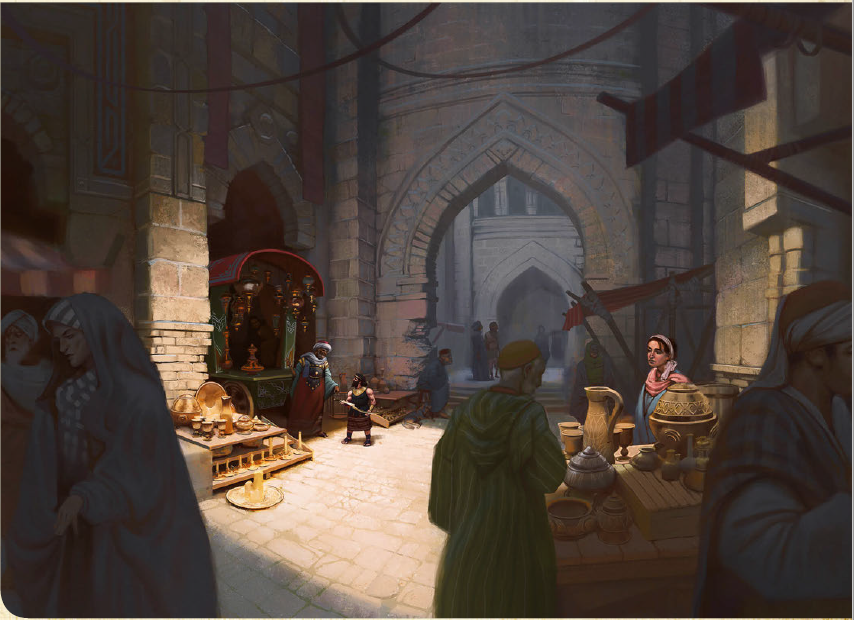
Founded by a conglomeration of Ishadian merchant houses, the island nation of Shibai sits at the crossroads of the maritime Showka Passage which brings them untold riches from all corners of the world. Ostentatious displays of wealth are not uncommon, including a literal street paved with gold in the capital protected by a magical wall of force to deter thieves. Its government has a sultan who is elected by popular vote, although he rules in name only as a hierarchy of 36 merchant houses controls various aspects of governance and trade. The capital of Mosylon is known as the City of Golden Towers where even the pauper’s homes are made of cut marble. The merchant princes and princesses are fond of building ever-taller and more elaborate towers to outdo each other; children, thieves, and heru are fond of climbing them.
Shibai is also the center of the slave trade in the eastern Southlands. Merchant ships are routed through the island nation in a network where spices, manufactured goods, and people are trafficked between the Spice Coast and eastern realms such as Far Cathay. In spite of being heavily armed it is not uncommon for Shibai’s ships to be the target of pirate attacks, whether by altruistic abolitionists or profiteering privateers.
Kesara, the Land of the Saffron Rajah
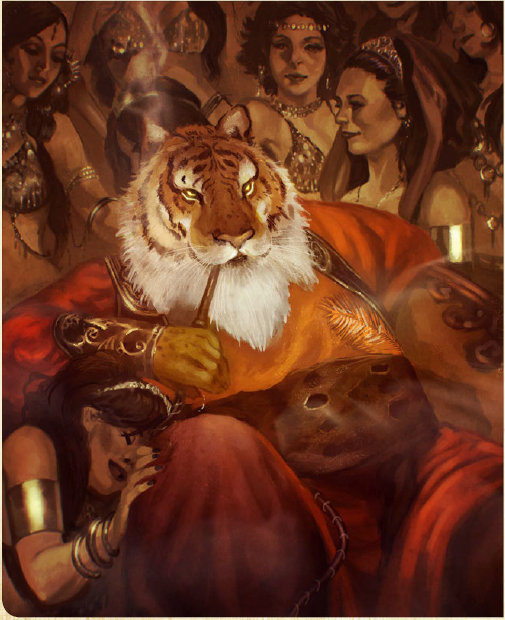
An isolated valley accessible only by a single well-patrolled road sits to the north of the Spice Coast. This kingdom is rich thanks to the cultivated saffron of its name, but its ruler is a mad rakshasa of great power. The isolation of the realm, along with his unmatched magical talent, means that he lives and is treated like a living god where the populace of slaves seek to please him and avoid his wrath. Unfortunately the Saffron Rajah is a mercurial, easily-bored being who finds entertainment in coming up with new ways to torment the populace. For this reason he relishes any and all visitors who come down his way. The lucky ones who entertain him may walk out of the valley with unique artifacts and riches; the unlucky ones never make it out at all.
Kesara’s culture can be surmised as an extended, demented piece of performance art conducted by a sociopathic manchild. The citizens are always smiling no matter the occasion, but they are the smiles of worn, tired men and women desperate to conceal their emotions. High positions such as advisor and royal cook are in fact punishments; the Rajah hates when his advisor simply agrees with him on everything even as he ignores said advice so even obsequiousness is a punishment. As for the royal cook, the Rajah has a fondness for the flesh of rebellious citizens and those who cannot please him. Even his own Saffron Watch is measured so that those who grow too skilled (and thus a threat to his power) are promoted to the Rajah’s Guard and never seen again. The Playing FIelds in the Palace of Water are where he hosts all manner of gruesome games, and is a place where visitors have a chance at betting something (usually their lives or freedom) in order to gain some rare treasure or lore from the mercurial rakshasa.
Two of the Rajah’s most notable treasures are the contents of the Royal Archives and the secret Godflesh Liquor. The Royal Archives are a series of chambers holding all manner of dark secrets the monster attained over his immortal lifespan. In fact, this is the only location of spells of the shadowflesh subschool (detailed in another Kobold Press product, Deep Magic), which include macabre rituals such as forming slaves out of darkness to hunt and eat one’s enemies.
Possible Divine Spark: The Godflesh Liquor is a potent drink of pomegranate wine distilled from a secret vat twice a year. Given only to his most favored subjects, the liquor is distilled from the body of a godling and has unpredictable effects on the imbiber. Sometimes they get prophetic visions, other times they experience strong urges of sin or loftier emotions such as charity and mercy.
Lion Kingdom of Omphaya
The savannah kingdom of Omphaya is the spiritual homeland of the nkosi, even though they are outnumbered by humans here 5 to 1. It is a warrior society where citizens are encouraged to strive for physical and mental excellence in all they do, and such feelings have only been magnified since the return of Gamka. One of the few surviving titans of Glorious Umbuso, Gamka broke out of his Veles-wrought prison beneath the Gorgonkin Mountains last year and claimed the Lion Throne of Omphaya. He fills his citizens with patriotic fervor, claiming that the country is but the first step on the resurrection of Glorious Umbuso and considers himself the sole legitimate ruler of all of the Southlands. Gamka goes out of his way to endear himself to his people, using his massive size and strength to help with fieldwork and pump the bellows for smiths.
But all is not well, for Gamka is insistent on adopting what he claims are the more controversial customs of his heritage, such as hosting gladiatorial games to the death of prisoners and consuming the flesh of those who anger him. He also violently drove the worshipers of Bastet from the country, claiming their temples as his new shrines. The populace is willing to overlook these things for now, treating them as strange obsessions of an overall lovable leader. It is Gamka’s second in command, the raskahsa vizier Bhukasta, who receives the brunt of Omphayan’s ill will. Bhukasta is in charge of the nation’s army which makes regular raids into trollkin lands and sends spies out to far-off kingdoms, and his secret police disappear those who object too loudly to Gamka’s cruel policies.
Interestingly one could surmise Gamka’s nature indirectly by looking at the pantheon entries of earlier kingdoms. Recall how the gods wear masks to appear as different entities? In the Lands of the Saffron Rajah, Gamka is listed as one of the gods worshiped, as a mask of Vardesain. Vardesain is one of the Dark Gods of gluttony and hunger from the Midgard Worldbook. Additionally, Bhukasta was the one who freed Gamka from his imprisonment at the hands of the world-serpent, manipulating him with insidious spells to believe that his blood-sports and cannibalism are “Umbuson traditions.” Bhukasta hopes to steal Gamka’s divinity for himself.
Divine Spark: Speaking of which, Gamka’s spark could not be easily re-absorbed, so he transferred it into a bone and gold Mantle of the Triumphant Fang. Made from the sharpened teeth of a thousand lions, he is slowly absorbing the spark’s power, and he can transform favored champions into nkosi. Someone mighty, bold, and lucky enough to wrest the spark from the titan can transform into nkosi or dire lion form at will.
Not all are satisfied with the new government. The Jaga Rebellion is an independent cell of resistance fighters who believe that the current Gamka is not the one of legend. As of now they are too small and disorganized to put up a sizable threat, but Bhukasta treats them as deadly as any other proclamation of sedition.
Cattle Queens of Terrotu
This sprawling country of mild climate and rolling hills and grassland is home to nomadic Zwana tribes whose livelihoods revolve around ankole herds. Their society is matriarchal: men serve as defenders and guard the animals, but the ankole are owned by women who virtually control every other societal aspect from government to trade. The “Cattle Queens,” or Malkia, are rulers of their own tent-cities and elect a Malkia Makem, or Queen of Queens, to be their leader.
Judging by the names and titles of some of the important NPCs via Google search (The Malkia Mazaber Aussa Mudiato; or Kedafu, Lord General of the Tramplers, etc), the names of the Terrotu are analogous to Ethiopian names of antiquity. Which is interesting, as I do not recall if Ethiopia was renown for a nomadic herding culture.
The Malkia Makem’s election process is held at the sacred Temple of Onyx and Ruby. This holy site is the only one of two permanent structures of the kingdom, the legendary resting place of their titan founder. The Temple also hosts a festival known as the Mustering every seven years, where priestly diviners predict whether the next bout of years in the intervening time will bear good fortune or ill by determining the state of Enkai’s battle against the demon.
Divine Spark: The Terrotu worship the woman titan Enkai, who created the ankole cattle as a blessed gift for her chosen people. She gave up her spark as an act of great sacrifice when a demon sought to possess her form, imprisoning herself in the Temple of Onyx and Ruby where it is said she still struggles to this day. This internal fight over her own soul is explained as the dual sides of nature itself: Enkai Narok, “the Black Goddess,” represents the benevolence of nature represented in rich bounty and beauty. Enkai Nanyoki, “the Red Slaughter,” represents the crueler and violent sides of nature.
The other permanent structure is the stonecut city of Mazabar, Terrotu’s primary trading hub for merchants across the Corsair Coast as well as the people of Ramag. The closest thing the country has to a military are the Tramplers, border guards who defend the nation from threats such as raiding bands and the tosculi of the Titan’s Hive. Both groups are fond of stealing ankole herds.
Perilous Sites of the Corsair Coast
This vast realm is a cornucopia of dangerous locations ripe with adventure, and quite a few of them are Sinbad-style islands home to some unique feature or group of monsters. Some of the more notable locations are as follows:
Behtu-Nari, an island was once home to a tribe of pygmy halflings known as the Behtu. When a brutal demon lord by the name of Mechuiti was spat into Midgard via a volcanic eruption, he unleashed great destruction on the island and spared the Behtu in exchange for their eternal servitude. He enacted a cross-breeding program with apes and demonic blood, turning them into his monstrous tiefling-ape minions.
So yeah. The whole “humans breeding with apes to become monsters” has all kinds of problems in a Fantasy Africa context, which makes it stand out all the more on account of how otherwise stellar this book has been in avoiding Unfortunate Implications.
Other locations in the Corsair Coast include a dangerous City of the Sahuagin who scavenge great treasures of the sea but view all landbound races as surface food; the Isle of the Rukhs, home to the massive birds of legend whose island is riddled with tunnels of unknown origin; the Kimona Proving Ground, where hopeful Omphayan warriors (and those from lands beyond) visit to take grueling challenges to join the elite Lopwe’s Fang warrior society; and the Twisting Tower, an ominous former retreat of a titan archmage home to all manner of dangerous forgotten experiments. The titan’s insane mind bonded with the tower, and is now capable of molding halls and rooms into all manner of dangerous traps and terrain.
We end this section with three adventure seeds: a dungeon-like massive baobab tree serving as a mausoleum for generations of jali bards now inhabited by a malevolent spirit; a Terrotu warrior who made a boast at a Muster of being able to climb the mountainous monuments of the Titan’s Spine and hires the PCs to accompany him on the trip; and a lost diamond mine in the Spice Coast, home to great riches but also deadly monsters and the odd rival treasure hunter band.
Character Options of the Corsair Coast
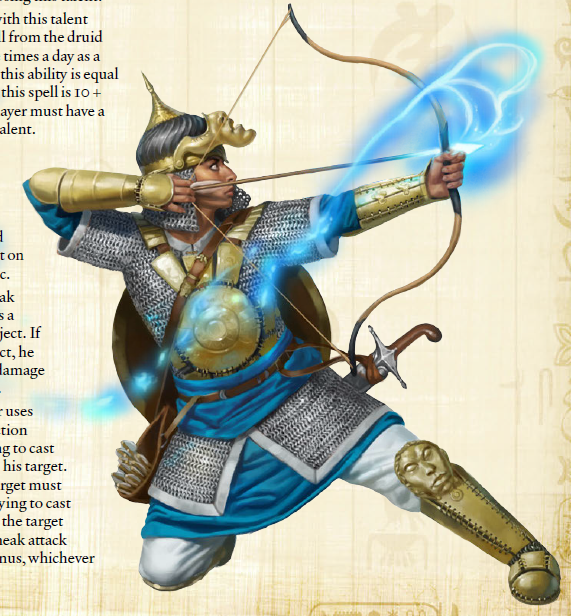
A surprisingly high amount of options for this chapter are Terrotu-centric. The text even mentions that their magical traditions dominate the region. Only the celestial-centric magic in the northern reaches is called out as the other one of note (here we’re helpfully pointed once again to Kobold Press’ Deep Magic sourcebook for more information).
Our sole archetype is the Holy Trampler (Slayer) who defend Terrotu’s herding grounds and sacred shrines. They trade in their sneak attack progression for Trampler’s Shape, a progressing form of of polymorph where for 1 minute per level each day they can change into a type of beast. At lower levels they can only take the forms of animals and ones close to Medium size, but as they increase in level they can shapeshift into magical beasts, humanoids with the giant subtype, and sizes from Diminutive to Huge. At 7th level they trade in their Stalker class feature for Above Notice, where they gain a +4 to stealth when they shapeshift into a form of at least Large size. Their 20th level capstone ability, Titanic Slayer, increases the size category an additional level when they transform into a giant subtype creature and increases their Above Notice bonus to +8.
We get some new complementary slayer talents, such as Minor/Major Nature Magic which grants the casting power a 0 or 1st level druid/ranger spell as a spell-like ability, or Spellgouge which deals bleed damage with an attack against an opponent about to cast magic and forces them to make concentration checks until the wound is healed.
Our two new feats include Lion’s Lope for natives and long-term residents of grassland areas which increases your base movement speed by 5 feet; and Trampler’s Scion, which imposes the sickened condition on targets which you demoralize via Intimidate (the target is sickened and demoralized, so both conditions stack for a whopping -4 penalty on attack rolls, saving throws, skill checks, and ability checks as well as -2 on weapon damage rolls).
For magic, our sole magic item is the Mantle of the Lion, a prized Omphayan relic which can allow the wearer to gain a bite attack (or doubled critical threat range if they already have it) and the ability to polymorph into a dire lion. The Ankole Sorcerer Bloodline is descended from those who had close ties to the titan goddess Enkai. Its bloodline arcana and powers center around the strength of the herd, such as adding twice your Strength bonus to CMB and CMD, projecting ghostly ankole horns to charge an enemy as a ranged attack, inherent bonuses to Strength and natural armor, the ability to cast righteous might as a spell-like ability, and a 20th level capstone ability which increases your size category by 1 permanently along with a host of other features: the scent quality, a 10 foot base speed increase, and even more permanent bonuses to Strength, Constitution, and natural armor.
The six new spells include Ankole Stampede, an AoE which summons a herd of ankole spirits; Healer’s Bane, which turn the most recent healed value of a restoration spell (cure x wounds, heal) into damage; Herdmind, which establishes a limited group telepathy with one ally per level; Horned Gore, which is a ranged attack that deals force and bleed damage; Leechspray, which damages and nauseates a targeted creature via a ball of summoned leeches; and Physician’s Eye, which attunes the target to the plagues and illnesses of the world, imposing a bonus on a single Heal or Survival check made anytime within the next X hours equal to the Caster Level of the spell.
Our chapter ends with stat blocks for two new animals common along the Corsair Coast. The Ankole is a massive elephant-sized cattle animal: a CR 3 Huge creature with an impressive 31 Strength and an even more impressive gore (+10, 2d6+15) and trample attack (3d6+15, Reflex save DC 21) to boot.
The Zwana Lion is a cousin to the standard lion but with the agility of a leopard. They are not as powerful as other big cats (Medium size) so they rely upon speed, group attacks, and high cunning for a creature of the Animal type. Zwana lions are Challenge Rating 2 and have weak natural attacks (bite is +4, 1d6+1 and grab) and 2 claws (+4, 1d3+1) along with the Pounce and Rake special attacks.
Interestingly the Zwana lion breaks the Pathfinder rules. Although of the Animal type, its Intelligence score is 4. Animals in Pathfinder can only be 2 or lower. There is no supernatural rationale for why these felines are so canny; they just are.
Thoughts So Far: The Corsair Coast is a cool region. You can find urban adventure in Shibai’s golden streets and Mahlmet’s rough and tumble port town. Swashbuckling adventure is a mainstay, and PCs can feel heroic when fighting the pirates and slavers of the Spice Coast or clashing wits with the mad Saffron Rajah. There aren’t many opportunities for traditional dungeon delves, and the racially problematic ape-hybrids of Behtu-Nari are the black mark on an otherwise stellar chapter and book.
Join us next time as we head to the Abandoned Lands, the treacherous geographic heart of the Southlands home to the fallen legacies of Glorious Umbuso!
Chapter Seven: the Abandoned Lands
Original SA post
Chapter Seven: the Abandoned Lands
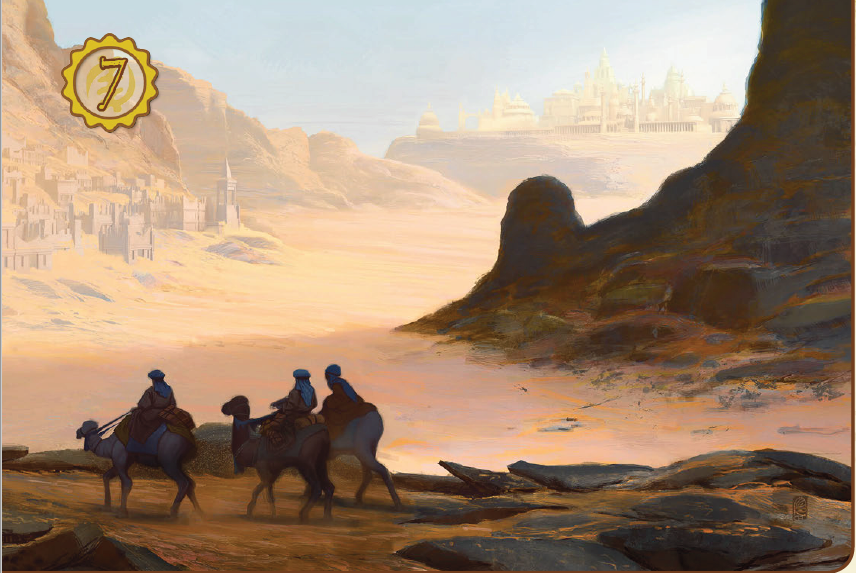
Dominating the geographical center of the continent, the Abandoned lands are a sparsely inhabited region where the capital of Glorious Umbuso once sat. The collapse of the titan empire and its ley lines left much of the region a dangerous place, but even the promise of riches and lore draw explorers to this forbidding realm every year.
Ramag
The Ramag people were a tribe of humans allied with Glorious Umbuso, gifted with the ability to manipulate magical ley lines to help their larger neighbors build works of wonder. When the insane plague gripped the titans, the Ramag sheltered themselves within the city of Ramagani (or “home” in their native tongue).
Ramagani still stands to this day, geographically spread all over the Abandoned Lands and outlying regions but considered one city thanks to the network of teleportation portals. Said portals are linked together via stable ley lines and maintained by huge monoliths. The ambient magical energies of said structures slowly changed the Ramag humans into a still-humanoid yet highly magical race; most Ramag appear as humans, but with slightly longer limbs and much thicker strands of hair usually tied back in fanciful clasps.
Day to day life in Ramagani is much like that of other Southlands cities, although their teleportation network makes their civilization a trade hub par excellence. They also are the greatest repository of titan lore in the Southlands, privy to their language, hidden sites, and magical traditions unknown elsewhere. Ramag’s neighborhoods are arranged in a ring-like pattern with monoliths around the edges, and at least one of those portals leads to the main city which is located on an island off the southern coast of the Southlands. Maintaining the monoliths is a vital public service, and every adult learns an incantation to bind their soul to the structure in death and are entombed in the monolith. At its basic function this keeps the magical energy flowing, but the presence of more powerful spellcaster’s souls can grant bonus effects such as animated statue guardians, long-ranging abjurations covering entire neighborhoods, and so on.
If you’re wondering how far-spread Ramagani’s portals reach, the answer is very far. You can download a free copy of the setting map from Drive-Thru RPG to see for yourself, but the book itself lists eight of the largest ones: two just south of Kush, two near the Skittering Ones’ Web, one in Mafri near the Eleyin Mountains, one along the southernmost coast of Terrotu, one west of Terrotu, and countless more not on the map. The book teases us with potential lost portals used as secret refuges, failed settlements, and forgotten streets of other cities.
Ramagani’s government has a council of elders whose members are elected by popular vote, and a king or queen chosen from the elders during New Year celebrations to serve a 10 to 15 year term. The end of the term entombs the regent in one of the monoliths, usually to replace one with fading magical energies or reinforce a weakened portion of ley line.
Ramagani’s defenses are also appropriately extraordinary. The Stormwatch manages ley-line powered siege ballistae crackling with magical lightning to ward off enemy armies and monsters, while a guild known as the Scaled Keepers raise and hatch pterodactyl eggs in special incubated houses to serve the military as aerial cavalry. In the event of a magical disaster breaking or severing a ley line, the heavily-armed Ley Wardens patrol the Abandoned Lands’ environs to repair and protect them with exacting rituals.
Tosculi, the Golden Swarm
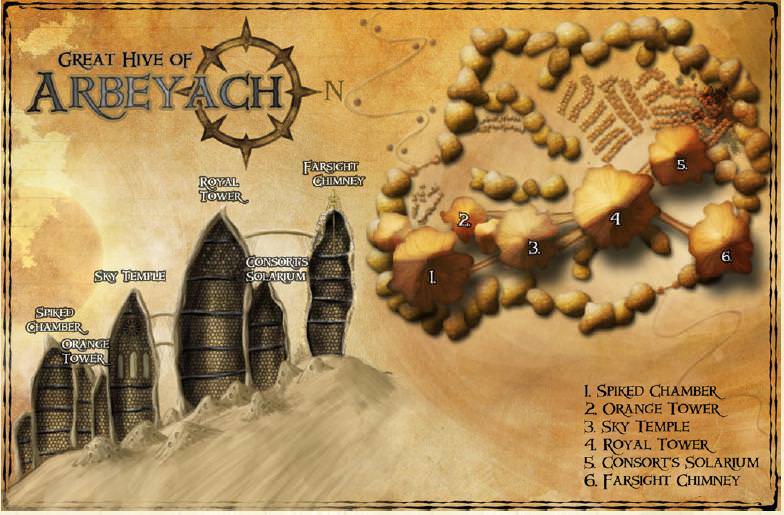
Finally we get to learn more about everyone’s favorite wasp-people! This section serves as an overview of all tosculi settlements in the Southlands, and not just the ones in the Abandoned Lands although they are most populous there. The buzzing sounds of the insect’s flying raiders is one of the most-feared things among the realm’s travelers, and there are few things which unite the Abandoned Land’s scattered people than an invasion of the Golden Swarm.
The tosculi worship the archdevil Arbeyach, working to expand their hives into new territory. Raiders kidnap people to take back to their hives, where they implant the prisoners with eggs for their larvae to feed off of and grow before emerging from the drained corpse as new tosculi drones or warriors. They have a hostile foreign policy with just about every other political power bloc, even each other. Although tosculi have the same long-term goal and worship the same god, their six major hives are ruled over by queens who all want to be supreme ruler of the Southlands themselves and brook no competition.
We get a list of four of the largest hives of the Golden Swarm. There exist smaller ones all over the Southlands, but tend to be tiny affairs ranging from two dozen to a few thousand tosculi at most. Snowcap Hive lairs in the cold mountains of the Southern Fringe (the following chapter), built from immense pillars of mud reaching into the sky. Titans’ Hive lairs in the southwest portion of the Abandoned Lands, a former settlement of Glorious Umbuso now almost completely encased in mud-like resin structures. It is unknown to what extent the tosculi are aware of the titans’ powers, although they do seem knowledgeable of the ruins’ many magical items. Corpsehive is perhaps the most macabre settlement, for a large portion of its structure is composed of tosculi corpses frozen in resignation, arms and jaws locked before death. The Corpsehive tosculi are also known to build sacred cattle of the Terrotu into their structures as well, their skulls separated as trophies on display by their queen.
The Great Hive of Arbeyach gets the most detail, and it’s not even in the Abandoned Lands proper: it’s actually east of Kush and west of Sar-Shaba, which would technically place it in the Corsair Coast. The Tosculi call it Crecretellock, or “Green Hill City” in their tongue. It was the first relam of the tosculi to convert to the archdevil’s worship, and for this loyalty they are the strongest and most fanatical of the hives. Arbeyach’s herald, the unique devil Ia-Affrat, sits within the hive and actually has contempt for the wasp-folk. He sees them as dirty, boring, and ugly and is prone to inflict abuse upon them for minor infractions.
The Great Hive is a mostly-vertical settlement, divided into sections of chimney-like hives. The Farsight Chimney grants the best view of the surrounding territory, while the Orange Chimney holds scribes, artists, merchants selling unique living items of the Tosculi, and swarm masters raising mundane insects to use in war or as sacrifices to Arbeyach. The Sky-Templer of Arbeyach is the religious center of the city and also home to its butcheries. The War and Commerce Chimney holds the living quarters for most of the soldier caste and serves as a storehouse and armory. The Royal Chimney hosts the hive’s governance and living quarters of Hive-Queen Tekli, who sits upon a throne of carved jet embedded with precious gems. A few travelers of other races are brought here to share news of caravan and settlement development, although the Queen is fond of inviting less-favorable visitors to her private quarters where she promptly insults and dismembers them.
Munayo, the Floating Village
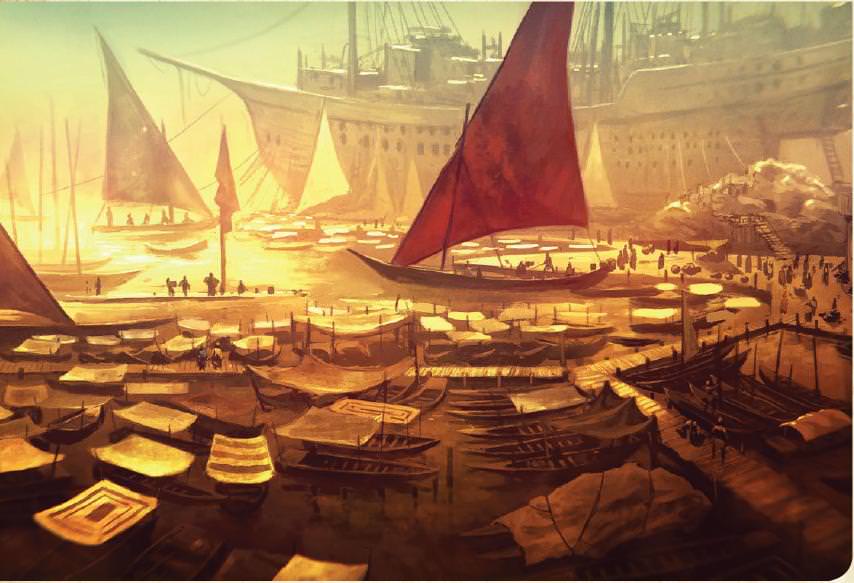
Lake Debari, the largest body of freshwater in the Southlands, holds an entire town upon its lulling waves. Hundreds of fishing-boats and barges lashed and tethered together form a city upon the clear waters. Many boats are capable of lone travel and have departed from the fleet, but most remain docked in Munayo for decades. The town’s ancestors swore an oath to never set foot on solid ground, for they are tasked with constant vigil of a threat they claim sleeps at the bottom of the lake.
They do not share this with outsiders, but the Munayo’s oldest stories explain of how their ancestors paid tribute to marid genies who lived within a magnificent city surrounding a portal to the Elemental Plane of Water. They later came to revere the titans of Glorious Umbuso who protected them from the dangers of the continent, and this did not seem to cause conflict between them and the marid. When the titan empire collapsed, a leviathan emerged from the portal and devastated the marid city. One of the dying titans tried to kill the creature, but the insanity wrought by her plague made her cast the wrong spell and instead put the beast in a deep slumber. The people of Munayo had a front-view stage to Umbuso’s burning cities and the broken remnants of the marid buildings. After mourning their lost neighbors, they made an oath to continue where the genies and titans left off by watching over the lake.
Munayo’s demographics are mostly Zwana humans, but some undines, elves, and fey-touched trollkin live among the boats. Seafood gained from fishing and diving comprises the majority of their diet, although a few sturdy boats with soil grow floating gardens. Everyone knows how to swim and the village’s warriors train in underwater warfare for the inevitable time when the behemoth rises. They have a large community of spellcasters, more divine than arcane, but bards are popular due to strong storytelling traditions. Much of the lake’s natural resources are turned into tools, and mussel shells are the most versatile. They can be used as pottery, eating utensils, or even forged into scale mail armor.
The people of Munayo accept foreigners into their settlements for three days, but those who wish to remain longer must become full citizens and “leave behind the land.” They undertake a test to dive to one of the ruined marid towers and retrieve a relic of that land; those who survive the ordeal are welcomed with a weeklong feast along with the full history of the Munayo and their status.
For those who wish to play as Munayo PCs, the village holds a blind lottery every three years for six among their number. Those chosen are tasked with venturing into the Abandoned Lands to harvest and trade for resources unobtainable on Lake Debari. Unfortunately this breaks their taboo, and they are treated as outsiders who must leave the village after three days once they return with the needed supplies.
Munayo’s entry ends with 14 locations within town and 3 adventure hooks. The hooks include an oracle making contact with a ghostly marid deep beneath the waves who is not all-benevolent, another involves helping an exile return a treasured keepsake to the village they were sworn to never return to, and the third involves braving the underwater ruins at the risk of waking the sleeping behemoth. The locations are nothing special, mostly detailing mundane stores and important personages responsible for community affairs.
Perils of the Abandoned Lands
Most of the Abandoned Lands is located on the Aggesal Plains, home to very large wildlife such as dinosaurs and towering megafauna. Beyond these obvious dangers, a more subtle one deadly to spellcasters manifests from the warped and broken ley lines. Beyond the stable ones of Ramagani the majority twist, link, break, and form in random patterns. Any time a spell, spell-like ability, or magical item is activated, there is a 20% chance a caster is within a region of broken ley lines, triggering a primal magic effect on a failed concentration check (DC 15 + twice the spell’s level or caster level if a magic item or ability).
We have an entire table for failed results here:
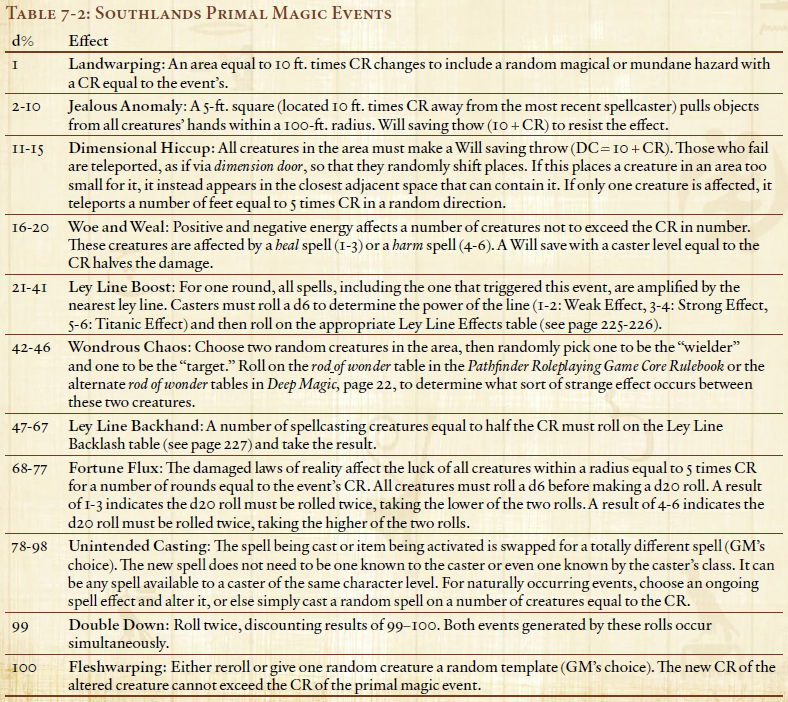
As you can see, there’s a fair amount of negative backlash and unexpected positive results. It reminds me of the Wasted West region from the Midgard Worldbook, which more or less operates under similar mechanics.
Afterwards we get eight locations of miscellaneous locations within the Abandoned Lands. They include the Trollkin Kingdom of Nmabi ruled over by a reincarnated adventurer who believes himself to be a divine king; the Palace of the Heris, home to a community of white-furred sapient apes awakened by a long-dead race of sorcerers wiped out by a magical plague; the Rift Valley of Kimvai, home to titan-sized cavernous structures dotting the canyon walls where human and heru communities inhabit, some of whom gone mad and form cults to dark gods; the Shattered Roads, huge stone highways reaching out from Glorious Umbuso’s capital capable of doubling travel speed but filled with erratic and hazardous magic; the Skittering Ones’ Web, a rainforest home to a race of spider monsters who sold their souls to a demon lord and make raids against Terrotu and coastal vessels; and the Treehomes of the Mafri, a group of two dozen Zwana villages who live in a jungle canopy east of Lignas.
The Mafri worship serpents of all kinds, based on a creation myth where great snakes protected their ancestors from a cataclysmic rain of stone and fire, and leave sacrifices of prisoners to shrines. Precious stones are given back in the same location the day after as a reward from their gods. Their “gods” in question are subterranean serpentfolk who are more than happy to use the Mafri as a buffer against enemies and even have a few spies in Lignas (who they do not treat as an ally just because of a shared love of serpents).
Gala’ikos, the former capital of Glorious Umbuso, is second in the list but has more word count so I’m treating it as its own section. Its towering spires of crystal and glass reflect sunlight onto the streets, and some of the city’s floating palaces still orbit the perimeter. Although Gala’ikos still looks beautiful, the lost legacy of the titans can be seen in etched runes of blood written by victims of the maddening plague. The structures are built for inhabitants 70 feet tall, which would ordinarily make conventional travel for human-sized people difficult if not impossible. But many structures have separate human-sized entrances and stairs for the titans’ mortal followers which mitigates this. The titans’ descendants still occupy the city as deformed, insane beings a shadow of their former power. They are prone to violent mood swings, react with hostility to intruders, and worship the city’s magical devices and phenomena as though they were gods.
Some of the notable locations within Gala’ikos include a Floating Prison which housed some of the empire’s greatest criminals, but is now mostly empty save for a nest of vrock demons and a trio of evil gods imprisoned near the prison’s center. The Hall of Creatures is a crystal dome housing a menagerie of life forms from across Midgard and other planes. The menagerie’s occupants survived in their own ecosystem, malfunctioning construct caretakers barely able to contain the population. The broken wards are how the Abandoned Lands became home to so many dinosaurs and megafauna. Finally, six cocoons of floating crystal known as the Sleeping Gods each contain the comatose form of a titan, and the academy ruins they orbit hold the secret to awakening them.
Character Options of the Abandoned Lands
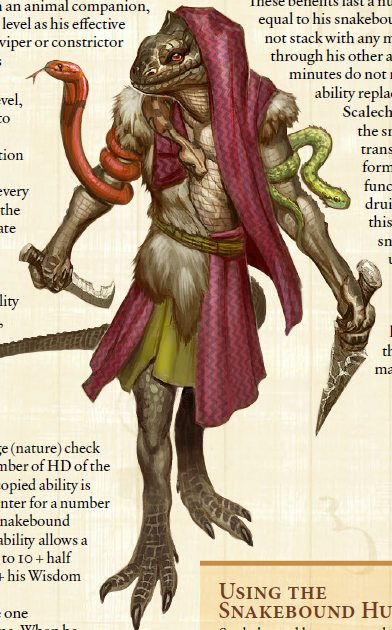
The PC-facing options are a bit short, focusing heavily on magic. Our sole new race is the ramag. They are heavily inclined towards brainy arcane caster types: -2 Strength and Constitution, +2 Dexterity and Intelligence, are Medium native outsiders, gain +1 racial bonus on all caster level checks made to use ley lines, treat Spellcraft and Use Magic Device as class skills, and have Spell Resistance equal to 11 plus their character level.
The only archetype we have is the Snakebound Hunter (Ranger), a tradition among the Mafri people who bond closer with serpents so as to be better hunters and warriors. They trade out wild empathy in exchange for a viper or constrictor animal companion whose progression advances as a druid rather than ranger. But their biggest class feature is replacing favored enemy and favored terrain for the ability to duplicate an extraordinary ability from an animal, vermin, humanoid, or monstrous humanoid within 30 feet as a full-round action a limited number of times per day (and for a limited number of rounds). At higher levels they can mimic more powers at once and choose from a wider amount of up to 6 other creature types (aberration, construct, fey, magical beast, outsider, and plant). The Snakebound Hunter eplaces hunter’s bond with the ability to gain a limited set of snake-themed powers (natural weapons, climb speed, scent, and/or natural armor bonus) for a number of minutes per day equal to his class level. Finally at 20th level they trade out master hunter in exchange for the ability to shapeshift into a giant anaconda at will and can cast spells in that form.
This is potentially a very powerful ranger archetype, as the mimicry ability can expose you to a large amount of variant monster-exclusive powers. The only major restriction is that it must be a creature physically present at the time, but with a friendly party summoner this can be circumvented.
The Magic of the Abandoned Lands has three parts. The first detail the game mechanics of ley lines, which are a reprint from the main Midgard books (2012 and 2017). For those unfamiliar with said ruleset, it is an unseen geographical feature restricted to locations, but with a proper caster level check a spellcaster can tap into the ley line and enhance a cast spell with an automatic metamagic feat with no increase of spell level. The metamagic in question is randomly rolled, and the ley lines’ overall strength (weak/strong/titanic) determines the overall strength of available feats.
A failure on a caster level check means the spell functions as normal, but a natural 1 causes the spell to be lost without effect, the ley line vanishes for 24 hours from being overtaxed, and the caster suffers a backlash which is a randomly rolled long-lasting debuff.
The ley line rules are a cool and thematic aspect and give an incentive for spellcasters and nations to fight over land and territory. All of the River Nuria is a Titanic Ley Line, for instance. But the lines being inherent on location means that their frequency in campaigns are subject to and reigned in by GM Fiat.
Tosculi Living Items are 8 new magical items made by the insectoid race to augment their drones when higher-caste members are in short supply. They are specially-crafted devices made to be attached to a living body via surgery and cannot be disarmed or removed, but can be attacked and sundered like an object.
The items include a stunted wing graft which grants a constant nonmagical feather fall and glide abilities; tosculi antennae grant the scent ability; tosculi carapace grants a +3 natural armor bonus which can stack with innate natural armor, and 2 of those points may be sacrificed as an immediate action to heal the wearer 10 HP per point of sacrificed AC; tosculi healing resin is smeared over wounds and broken objects, granting fast healing to injured creatures or removes the broken condition from an object; tosculi lenses make your eyes insect-like and grant +5 on Sense Motive and Perception checks in exchange for a -2 penalty on saving throws against light, gaze, and pattern illusion effects; tosculi pheromone glands allow silent communication with other gland-possessors at a range of 30 feet (people with scent can detect the general emotions and not the “words”); tosculi saliva allows other living items to be safely removed from helpless, willing, or dead creaturers; and tosculi spurs grant a retractable dagger-like weapon with enhanced versions that can deal acid damage or inject Strength-damaging poison.
The magic of the Abandoned Lands revolves around the legacy of the titans. Scholars of Glorious Umbuso deign titan magic as “Words of Power,” utterances which can alter reality. In fact, the 6 new spells are keyed off of the Words of Power optional subsystem of Pathfinder’s Ultimate Magic. In short, Words of Power’s magic are “wordspells” stringed together to form a spell’s combined effects. It is not a system I am familiar with, but this gentleman on Giant in the Playground wrote a comprehensive guide for it.
The six new utterances include Fire in the Heavens, which can hurl several creatures into the air and set their blood on fire; Force Spike, a shard of pure force which smashes into a target as a ranged or melee touch attack; Polar Palsy which freezes a target’s muscles and blood with sheer cold, paralyzing them and dealing cold damage; Rending Word, which causes a creature to be afflicted with overwhelming fear to the point that their internal organs burst, potentially causing 200 damage on a failed save and disabling the target’s spell-like abilities for 1d4 rounds; Severed Tendon, which impedes a creature’s movement by reducing their base land speed by 30 feet (5 feet minimum) for the duration of the utterance; and finally Shattering Dream, which commands a creature to throw an object held in its hand as far as possible before the spell’s second effect shatters or severely breaks it.
Thoughts So Far: The Abandoned Lands is a bit hit-or-miss for me. I got the feel of the whole “barren wilderness where giants once sat,” but areas with this theme are common enough in the other chapters that it doesn’t feel truly unique. The Ramag’s high-magic society is interesting and can be a useful nexus for “fast travel” across the continent. I cannot put my finger on it, but I liked Munayo. It reminds me of Fisherman’s Horizon from Final Fantasy 8, which had a very calming atmosphere and a populace dedicated to a worthy ideal.
The new rules options were the weakest part. The Ramag are a good race mechanics-wise and the Snakebound Hunter is powerful in the right hands, but the reprint of ley lines and the new magic being words of power meant that it was of limited use to me as I already own the Midgard sister setting. It may be of better use for those who purchased Southlands as their own product.
Join us next time as we cover the Southern Fringe, home to a lost minotaur colony, an island nation of xorn elementals, and a mysterious Bottled City home toassassins, thieves, and all manner of scum and villainy!
Chapter Eight: The Southern Fringe
Original SA post
Chapter Eight: The Southern Fringe
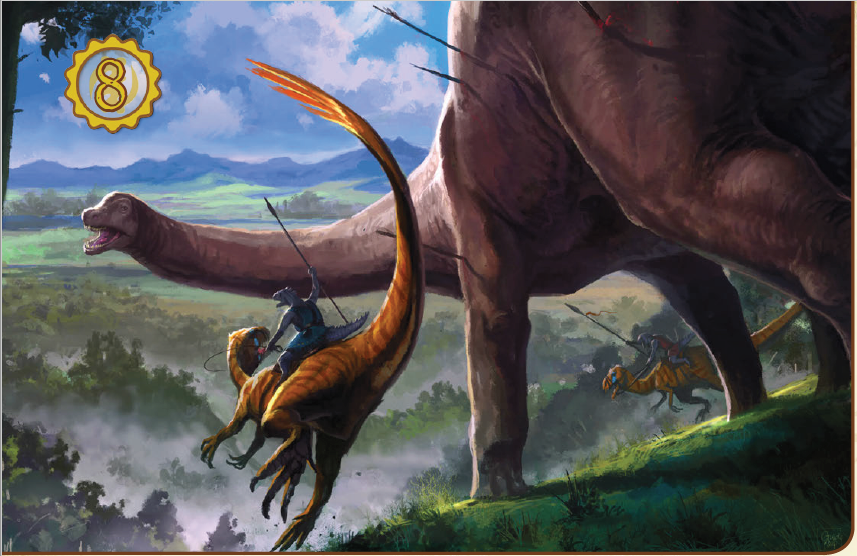
The Southlands’ southernmost tip is literally and figuratively the final frontier. With the exception of Sudvall, its environs are hostile to outsiders and its civilizations just as dangerous. From the conquering lizardfolk of Veles-Sa to the xorn slavers of Zanskar, most of its population are nonhumans or ruled by nonhumans. The Zobanu Jungle dominates much of the Fringe, with the mountainous island of Zanskar off the southeastern coast. Ramagani’s central portal nexus harbor is directly south of the Fringe as well.
Former Satrap of Sudvall
Sudvall is a melting pot culture of lost refugees from Roshgazi, knights from the northern Magdar Kingdoms who got lost on a shadow road, and the indigenous kijani. Its architectural style bears more in common with the northern kingdoms (think Central/Eastern Europe) than anywhere else in the Southlands along with cultural touchstones such as jousting tournaments. The kijani-influenced reverence for nature is the primary form of religion which keeps in check the brutality and violence inherent in a feudal system. On the surface, Sudvall appears as a harmonious multicultural realm where valiant knights and courtly etiquette really do live up to the ideals told in storybooks. But visitors who wrong a Sudvallan soon learn their crimes bring a disproportionately violent response upon them.
Sudvall’s government is ruled by a high marshal drawn from a list of candidates by popular vote every 10 years. The top 16 most-voted for people then compete in the Grand Tourney, a jousting competition of single-elimination matches where the winner becomes the ruler of the nation. An additional clause in the line of selection mandates a minotaur ruler, then a human, then a kijani to ensure that no race gains a disproportionate amount of power. Races not represented in the current marshaldom elect speakers who act as the marshal’s advisors. The current High Marshal is the minotaur Sir Rusa Miklos, whose term is going to end in 1 year.
We also cover the Kijani of Sudvall, who more or less repeat the information from Chapter One. Afterwards we cover the iconic locations: the capital Susa, the Jewel of the Southern Moon where buildings are made of green marble and cultivated trees and shrubs line its streets; Pentecor, a manufacturing hub; Nyse the Opened Eye, home to the nation’s most renowned mage college and Tinkers Guild; Mistorak, a jungle city which serves as border protection from Veles-Sa’s aggressions; Anion, its fertile farmland the breadbasket of the nation and where kijani-bound symbiotes are more common. This is due to the belief the race act as good luck charms for harvesting. Finally we have Cusash, an epicurean city of artisans and alchemists whose lives are lived to the fullest with grand feats and sweet wine.
Savage Land of the Trollkin Septs
Much like the tosculi section of the Abandoned Lands, the overview of trollkin lands applies to just about any of their territory throughout the Southlands. The people known as the trollkin are a diverse lot who can trace their lineage back to various trolls, fey, and other monsters. In the times of Glorious Umbuso the titans sent some demi-humans to live among the fey as ambassadors and their descendants had high status. But after the empire’s fall they descended into chaos and joined and bred with what other races who could shelter them.
The trollkin lands of the Southlands lair on the fringes of settled territory, bound together by related clans. Their leaders are known as kurta; according to ancient traditions a new kurta ascends to power by defeating the old. Most tribes have a warrior culture. In some cases this is expressed in a positive manner, standing watch over ruined cities of their ancestors, but others are little better than raiders. They overall are not fond of history beyond knowledge of kurta bloodlines, glorious victories, and crushing defeats yet to be avenged.
They extend a similar attitude towards religion; gods are not worshiped unless said deity can aid their talents in warfare, which gravitates those who are religious to gods such as the Hunter, Selket, the White Goddess, or Xevioso. Demon cults also took advantage of this brutal practicality, most notably the Whispers who subtly encourage trollkin to explore dangerous fey ruins brimming with cataclysmic magic, or the Bloodbirds which revere death as a means to an end. The Bloodbirds have a poor reputation for they encourage any excuse to kill, even if it means putting their own tribe at unnecessary risk.
Around 40 to 50 trollkin tribes control the largest of the septs, but the book gives us three of the most influential ones as inspirational material. The Burning Arms are ruled by Kurta Vanu who claims he can trace his ancestry to the jinnborn, and their tribe produces many elaborate myths of dubious reliability about his battle prowess and wish-granting capabilities. Vasha’s Face* worships a goddess of the same name and paint their bodies with white dye to better show the spilled blood of their foes. Finally, the Rockeaters are mostly eloko-kin who guard a fey ruin in the southeastern reaches of the Southern Fringe. They treat the ruins as though it were a god, calling it the Sleeping Hunger and provide it with prayer and animal sacrifices (and sometimes more intelligent races) whose offerings are always gone by morning with nothing left save for a splash of blood.
*whose entry refers to not one but two other Kobold Press books, Midgard Campaign Setting and Deep Magic, for what mask Vasha is for the former (V’ashra the Tormentor, an archdevil Nurian cult), and the unique discipline of blood magic for the latter.
Veles-Sa, Land of Terrible Lizards
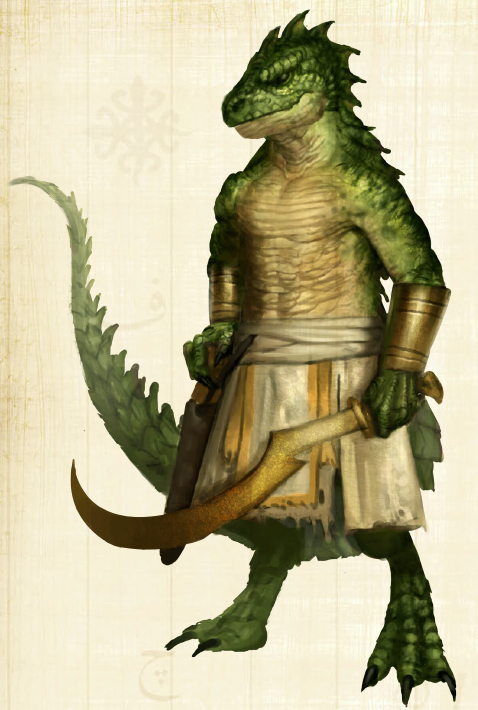
Deep within the heart of the Zobanu Jungle is an isolated civilization of lizardfolk. Known to outsiders as the Valley of Lizards for the nation as well as the ferocious dinosaurs thriving in the dark jungles, its major feature is an enormous egg covered in flecks of shimmering gold and green. The lizardfolk built their capital around this egg, which they claim was laid by Veles the World-Serpent and is responsible for the rise of their civilization. With an uncanny ability to tame the largest dinosaurs for labor and war, they quickly erected many cities and temples across the rainforest with advanced engineering. This further strengthens their own elitism, where they believe that they alone, and not even the dragons of the Mharoti Empire when they hear of them, are the true descendants of the World-Serpent.
Veles-Sa’s government is a theocracy ruled by Sortaal, the Vessel of Veles, who issues her patron deity’s edicts to a circle of ruler-priests who in turn rule the various castes. Said castes determine a lizardfolk’s lot in life as well as that of their children and children’s children. The engineers design plans for the temples and cities, builders erect them, stonemasons quarry, and the hunters and gatherers exploit the jungle’s food supplies. Lizardfolk’s occupations can be quite specific, with titles such as “Counter of Food for Builders” or “Watcher of the Skies for Terror Birds.” Tantanul, Keeper of Fang and Claw, is the ruler-priest who commands the warriors and scouts. Kesh Kem, the Builder of Veles’ Glory, oversees the many construction projects.
Beyond the castes are foreigners and slaves. The latter is derived from the former, who are small in number yet becoming a growing source of labor grown from intruders and prisoners of war. The Vessel of Veles issued a recent edict allowing for small bands of traders from Morreg and Sudvall to come to Veles-Sa’s border for commerce, although such trade is tiny at the moment.
Most of Veles-Sa is untouched jungle, and the closest thing to roads are the many rivers manned by dire spinosauruses the lizardfolk use as living boats and warships. There are older jungle ruins of forgotten civilizations, believed to be of Glorious Umbuso or Ankeshel origin, but as the lizardfolk tear them down to get quarry for their own buildings reliable information is hard to come by.
The capital city Azmull-Kre is Veles-Sa’s holiest and largest settlement, split by a deep crevice that holds the Egg of Veles which in turn is protected by a dome of marble. The city is still in a process of construction, and most of the buildings are more utilitarian such as granaries, gigantic dinosaur stables, hatcheries for new young, and step-pyramids of administrative buildings, armies, and warehouses. The Egg itself is impossibly large, its 150 foot tall tip barely breaching the surface and whose untouched interiors remain impervious to scrying. Veles-Sa’s clerics receive dreams and omens from it, and sometimes it visits destruction and insanity on those who displease it. There is a bitter debate among the clergy over the Egg’s contents: some claim it holds a titanic dragon infant, others claim it has pure destructive energy which will destroy the world and start it anew, or a host of master-race lizardfolk representing the pinnacle of evolution.
Divine Spark: Many religious lizardfolk hint that the Egg of Veles contains a spark of the World-Serpent himself, or one of the masks he wore long ago. That mask supposedly shed its skin when the titans of Glorious Umbuso went mad, and the spark embedded itself into the egg before revealing itself to its lizardfolk progeny. They believe that when the Egg hatches it will be a time of glorious conquest for their people. Naturally, any who wish to claim the divine spark in the Egg itself are faced with the unenviable task of penetrating its shell while fighting off the lizardfolk hordes protecting it.
Our section ends with two other settlements of Veles-Sa: KzTall (Ten Spires), a settlement built around a circle of metal poles which remain untouched by rust. They go impossibly deep into the earth, which may hint at them being titan artifacts. Strange supernatural activity occurs around the spires during a full moon, and animals go wild if they come too close to them. The other settlement is Splitwater, sitting at a junction of the Meztat and Qualket Rivers meeting at a massive granite shelf to make a titanic waterfall. A strong ley line pulses through the area, which the lizardfolk exploit to channel into the creation of more towers and pyramids. Sail-backed dinosaurs with howdahs are used to make deeper expeditions into the jungle.
Golden Sultanate of Zanskar
Located on a large island of its own off the Southlands’ southeastern coast, the Golden Sultanate of Zanskar’s massive mineral deposits grant it an edge in the vast trading hub of the Tethys Ocean. And yet it is an insular place, surrounded by forests with mountains dominating the center. Its ruling elite are xorn, beings of elemental earth with a sweet tooth for precious stones. Serving them are azer, dwarves of elemental fire who act as middlemen and emissaries to outsiders and as warlords and slave overseers for internal affairs. The majority of Zanskar’s population are humanoid slaves, tasked with mining the vast mineral veins beneath the island whose lives are hard and short. The government is lead by a Golden Sultan whose position is drawn from one of the 200 most powerful xorn known as the Granite Conclave. Said members are further divided into familial houses split between the four major settlements, and the azer have their own clans pledged to the nation of Zanskar as a whole and to the Golden Sultan.
Zanskaran culture places an almost-religious level of importance on politeness, and public displays of insolence are crimes on par with kidnapping or theft. As a result, most citizens rarely refuse requests, instead pledging good intentions and attempts if they do not wish to follow through on it. The xorn love tales of bravery and heroism, and merchants can often offer new and interesting stories as a trade good.
Zanskar’s major cities include the capital of Usunhi Ubakna, its high dome lit with burning gas vents illuminating veins of brilliant quartz crystals known as the Sash of Stars; Chibuuneh, a holiday retreat looking out over a placid bay home to many seasonal villas of the xorn; Khilwah, the main commercial port home to neighborhoods of foreigners whose merchants wage cloak and dagger subterfuge against each other; Sufallah, the primary surface mining town which builds the pumice dhows the azer use to sail the Spice Coast. Said dhows are alchemically treated for Zanskara to deliver its gold and gems to the settlements of the Corsair Coast in exchange for manufactured goods, foods, and slaves to feed the labor force of their mines.
We even have a “ship template” for pumice vessels. They require the crafter to have the stoneshape spell and cost 1.75 times as much as the base vessel, but they gain great benefits. One, the ship doubles its total hit points, resists the first 20 fire damage from any source, and gains 10 hardness and +3 natural armor.
Our final entry in Zanskar reveals the secret to its wealth: the Hidden Vault. A strange stone repository of the same name sits underneath the mines, which to this day has not been penetrated. Enslaved miners are capable of building a honeycomb of tunnels around it to peel off its gold foundations, which still result in a king’s ransom worth of profit. There are rumors that Mammon holds the Vault as a sacred space, and more than a few of his devils have been seen in the mines’ dark corners offering tempting deals to those who stumble upon them. Beyond the mines are many enormous galleries of unknown origin, containing empty ruins of cities and secret passages to the surface.
The Bottled City
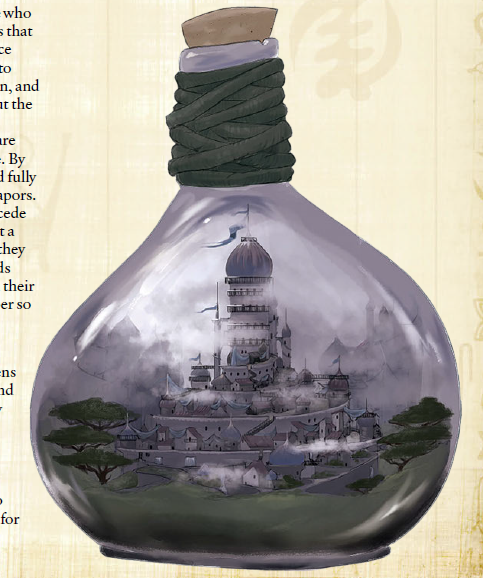
Our final major location in this chapter is perhaps the most unique, in that due to its nature can appear just about anywhere. It is a literal city in a bottle, where entry is gained by touching the stopper and saying their name and heart’s desire and thus shrunken down, and whose exit involves whispering one’s greatest sorrow and then enlarged to normal size. The Bottled City appears much like a mundane object on the outside, and it is due to this illusion that it became a perfect hiding spot for a community of assassins, thieves, and other assorted scum and villainy.
The Bottled City’s origin began 200 years ago, with an eccentric wizard of Sudvall inspired by genie containment magic. He came up with the idea of a truly private retreat he and his dear friend the high marshal could visit whenever one wished. The high marshal gave his enthusiastic consent, eager at the concept of an entire city devoted to his pleasure. Once the artificial settlement was completed, the wizard and marshal visited it regularly and its secret was miraculously kept. But when the high marshal’s successor was appointed, he made a show of destroying all the contents of his predecessor to prove to the public that he’d be a more serious ruler. The bottle was dumped into the ocean, seemingly lost until it washed up on a remote shoreline. Its inhabitants decided to become criminals, both as a means of vengeance against the government which abandoned them and as the perfect hiding spot for those of their ilk to retreat. Ever since the Bottled City appears in all manner of obscure places, waiting to be found by some clueless forager to bring back to a settlement or inadvertently enter it.
The Bottled City is crime-ridden but hardly a slum. Its government is ruled by a Marquin, one of the descendants of Halina, the high marshal’s favorite concubine and city’s head of staff during its heyday. Any heir can claim the title if they are resourceful enough to hold onto power, but the only restriction is that the city tolerates no murderous kin-slaying of said family even among each other. The bottle’s interior is surrounded by translucent porcelain walls capable of drawing in sunlight, and a long coiling staircase leads to the upper streets of the city and eventually the stopper. The streets themselves are concentric terraces which descend to a gently curved floor, and many buildings are remnants of its former status as a pleasure palace: foundations of banquet halls, gardens, fantasy suites, and the mundane laundries, kitchens, and other support buildings for sustaining them. Many buildings are connected by interior hallways, walkways, narrow service passages, and other entryways which result in a complicated maze. Residents go not by street so much as houses and landmarks, and visitors are at the mercy of guides who are hopefully trustworthy.
The Palace of the Marquis holds the city’s ruler, surrounded by a glittering moat with lily pads which can be harvested into poisons, salves, and potions. The Marquis meets with the heads of houses and crime syndicates for day-to-day matters of import but otherwise lets the populace govern themselves in exchange for a tax/rent/protection money. Feuds are dealt with by calling the personal guard, or Night Watch, or putting an assassination contract on the troublemaker.
The Zehir Tekke, or House of Poisoned Men, is the training lodge for the most feared assassin’s guild in the city. The members are literally poisonous, fed small doses of all types of venoms from infancy to the point that their very bodies become deadly to others. They only leave their lodge fully wreathed in heavy waxed cloths to contain their noxious vapors, lead by a gong or drum-banging beater to warn citizens that a Poisoned Man is coming.
The Street of Beasts is a network of alleys containing shops for all manner of creatures, many specially trained in unusual tasks. Monkeys who can pick locks, poisonous vipers, insects with non-lethal and painful stings, and pigeons carrying secret messages are some of the more popular merchandise. The Next-Day Market is where one goes to find stolen goods and is home to the most visitors of the city. Many fences even make a living recovering stolen items, but always with profit in mind. The Tool District contains workshops dedicated to all the necessary items for illegal activities, ranging from simple thieves’ tools and smoke powders to more specialized gear such as magically-warded locks and sleeping dust.
The Blood Factor’s Hall are the mob doctors of the Bottled City. Healers staffed and hired by the Marquis himself as a public service, they ease the pains of citizens whose jobs turned south. Even the dead can be raised here for a price and if the corpse can be carried to their facilities.
Perilous Sites of the Southern Fringe
This section contains five locations, two environmental hazards, and three adventure seeds. Our five locations include the Skyshard, a huge blue crystal spire housing an unknown powerful outsider telepathically promising riches to those who free it; the Citadel of the Dragon Hermit, home to the bronze dragon Sirannonoth who harbors a secret about the Mharoti Empire’s founder which is so valuable that he went into hiding to escape their wrath. He lives as a lonely shapeshifted traveler, visiting villages in Sudvall and Terrotu. Next we have Stoneship Landing, a titan-sized and forged ruined vessel hone to a tribe of medusae; the Trollkin Sept of the Filthborn who are reviled by other trollkin but whose Kurta is desperate to find outside aid; and finally the Zobanu Jungle, home to towering kapok trees and all manner of dangerous creatures of the rainforest.
Our two new hazards are a tree and a disease. Chirurgeon’s trees release a pollen when injured creatures approach within 30 feet. On a failed DC 20 Fortitude save they are mentally compelled to climb into the branches and sleep so that predators can scavenge them for easy meals. The new disease we have is the Ravening, which instills a maddening anger and hunger in those who are infected. Minotaurs of ancient eras purposefully gave it to soldiers to strengthen them, but this lead to disaster. Mechanics-wise the DC saving throw is equal to 10 + the exposed creature’s Hit Dice* and can be resisted with either fortitude or will. It causes 2d6 intelligence damage and is transmitted via inflected fluids and clothing. Those who suffer from it fly into a monstrous rage where they see every other being as a foe, and yearns for hearts to devour to gain power. For every number of hearts they eat equal to their own Hit Dice, they gain one Hit Die (does not specify if it’s of the class or creature type in the case of those with class levels).
*Yes, we have a disease which is more likely to infect someone the higher level they are.
Our three adventure seeds include a mysterious entity stealing kijani pods to bond to dangerous monsters in the Zobanu Jungle; a centaur who claims to know a way to breach the Egg of Veles to gain the treasure within; and the the opportunity to penetrate Zanskar’s Hidden Vault to uncover its mystery.
Character Options of the Southern Fringe
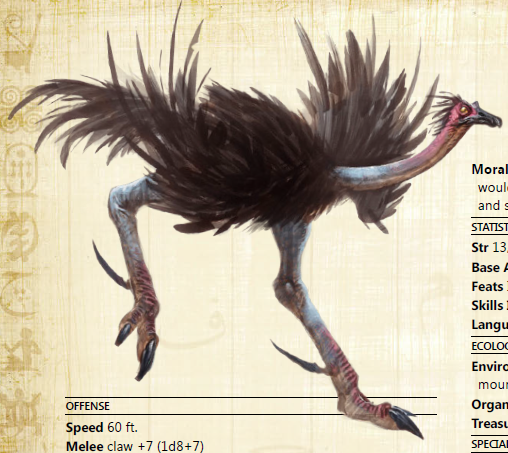
This section is brief. So brief in fact that we have no class archetypes or magical options and only a single race and feat! But what we do have is some new equipment and two monsters.
Race-wise we cover the lizardfolk, the people of Veles-Sa. Mechanics-wise they vary slightly from the standard Pathfinder lizardfolk race so instead I’ll describe what’s different. For one, they have +2 Strength and Constitution but -2 Intelligence, which is odd on account of having marvellous magical architects. Their swim speed is 15 feet rather than 30, can hold their breath for a number of rounds equal to four times their Constitution score before they risk drowning, and gain a +2 racial bonus to Acrobatics skill checks to account for their lithe natures. They also start play speaking only Draconic, with bonus languages being Aquan, Southern Trade Tongue, Giant, and Orc.
Overall they’re much like PF lizardfolk in that they’re geared towards melee rolls. The -2 Intelligence and not having the setting’s “Common tongue” as a starting language hurts unless everyone in the party can speak Draconic.
The only feat of note is Kijani Symbiote, where you bond with an immature kijani seedling. The seedling is a living creature all of its own and shares the host’s HP, AC, saving throws, and is considered to the host’s creature type for spell-specific effects. It is a one-inch-thick green vine topped by a leaf, and if destroyed (and you temporarily lose the feat’s benefits) a new one will grow from the tendrils inside the host within 30 days.
So what benefits do we gain from this symbiosis? Well we have an entire table for this outlined below dependant upon one’s race. They range from minor utilities (casting cantrips or minor spell like-abilities) to defensive properties such as a 10% chance to negate critical hits or rerolled a failed saving throw of a certain type:
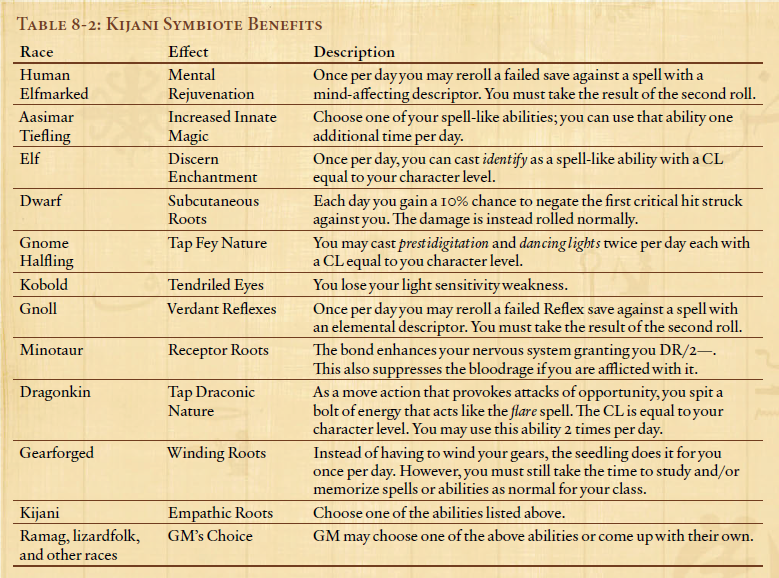
Honestly most of these selections are quite underwhelming for a feat slot: the gearforged one is nigh-useless, and the human/elfmarked is perhaps the most useful.
Our new equipment centers around the cavalry of Sudvall, which employs ostriches and axe beaks in addition to horses as steeds. We get prices for said creatures (400 gp for war ostriches, 1,500 for axe beaks) as well as equipment specifically for these animals. A beak blade grants +1 AC to an axe beak, +1 to damage, and +1 bleed damage on a critical hit for the low price of 6 gp. Blinders for 7 GP help guide all manners of mounts, imposing -2 to their Perception but +2 to the rider’s Ride checks, while talon razors grant +1 damage on an ostrich’s feet and +2 bleed damage on a critical hit for 15 gp.
In addition to mount-specific weapons we get three lance-heads, alchemical charges attached to lances which can be triggered on a hit. Dragonfire lance-heads deal 1d6 fire damage on all attacks and light enemies on fire for 2 rounds on a critical hit. Entangler lance-heads spray sticky goo, entangling a target on a successful hit and can force a mounted target to fall from a saddle on a failed Ride check (DC = 15 + damage dealt). Finally the greased lance-head sprays slippery goo, doing the same thing as an entangler but disarming rather than entangling.
We have two new monsters, which technically are in their own final section but is so brief I’m including them here. The first is the war ostrich, a CR 2 animal. In comparison to a warhorse it is slightly weaker (17 instead of 19 hit points, 13 instead of 15 AC, slightly worse saves) but has a more damaging claw attack (+7 to-hit, 1d8+7 damage), is faster (60 feet vs 50 feet), and has a +11 to Acrobatics (+16 total) when leaping.
Our other monster is the zimwi, a distant cousin of northern trolls who are a plague upon the Southlands. Cursed with eternal hunger, they are known to attack entire caravans and patrols without regard to their odds of victory. Their extradimensional stomachs are larger than their entire bodies, capable of holding multiple creatures within akin to a bag of holding. Statwise they are CR 4 Medium-size humanoids (giant subtype) and are perhaps closest mechanically to weak trolls. They have one bite and 2 claw attacks along with the rend special ability to deal more damage if both claws hit. Finally they can make a grapple check on targets they hit, and may swallow grappled opponents up to Medium size akin to swallow whole.
Thoughts So Far: The Southern Fringe feels appropriately remote and alien from the rest of the Southlands. Even Sudvall stands apart whose society is based around the ideals of pseudo-European knights. The Bottled City is perhaps my favorite realm of this chapter, in part because it can plausibly show up anywhere and makes for a nice “evil city of intrigue” for parties to visit for all manner of reasons. The bronze dragon exile can make for a fun destination for a campaign’s epic journey spanning the Southlands, of adventurers seeking an ace in the hole against the Mharoti Empire’s depredations.
Join us next time for our final chapter, where we cover the Gods of the Southlands in great detail!
Chapter Nine: Gods of the Southlands
Original SA post
Chapter Nine: Gods of the Southlands
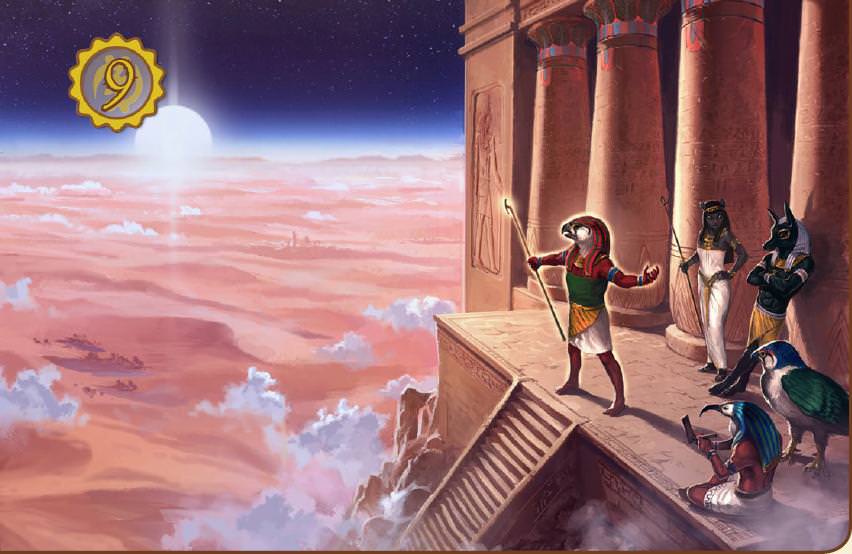
Our final chapter covers not a region, but the deities who hold sway over the people of the Southlands. We start out with a brief description on how the gods of this continent are more involved among mortal affairs, walking the physical world and taking delight in the mundane. The reason for this is that in the times of Glorious Umbuso the titans’ Great Web of ley lines made it difficult for any deities to manifest in the Southlands; the titans for their part worshipped long-forgotten Far Ones who do not interfere in mortal affairs. Only after the empire collapsed did the gods return to fill the power vacuum, earning the respect of many people who were otherwise left defenseless in the chaotic days that followed.
Most of the Southlands deities are relatively unknown on other continents in Midgard save as masked disguises. The three exceptions are Veles, Thoth-Hermes, and Isis whose names are just as well known in the northern kingdoms as well as the south. Veles is one of the patron gods of the Mharoti Empire, and Thoth-Hermes is beloved by scholars, thieves, and wizards the world over. Isis has a large following due to her association with healing and love, and wears the mask of Lada in the northern region of the Crossroads.
We also get a sidebar reiterating the rules of the gods in Midgard, whose true number is unknown due to their ability to disguise their very identities and appear as different forms. Known as masks, this is primarily a practical form of defense as it is possible for one god to gain another’s power via murder, enslavement, or any other number of horrible fates. It also allows a god to further cement their power: if their name and faith falls out of favor in one culture or region, they can carry on with another mask. The concept of masks are public knowledge among religious scholars, although there is much debate over what gods are masks of the other.
Finally, most gods and goddesses of the Southlands do not have specific alignments. Much like the wider Midgard setting, they only have one aspect of an alignment axis. For instance, Horus is Lawful and can be worshiped by clerics of any lawful alignment.
Gods of Nuria Natal
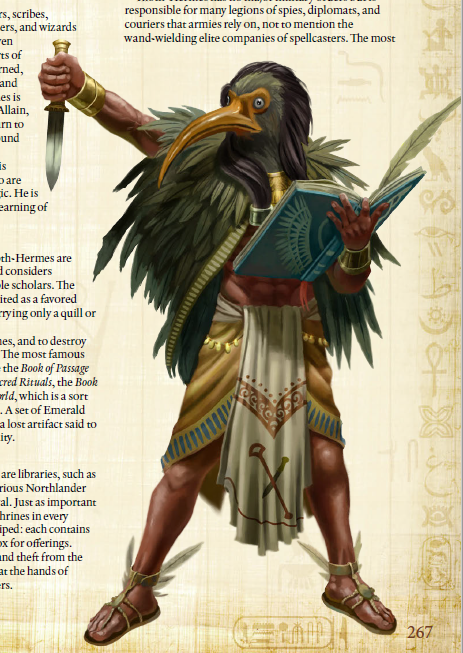
The only pantheon to remain untouched by the Great Web, the deities of the River Kingdom are perhaps the oldest and most well-known to those beyond the continent. There are hundreds of Nurian deities although most are of limited power and reach. Every city has its own patron, and gaining a large settlement of followers to call your own is a sign of great prestige in Nurian culture. Although many appear as epicurean animal-headed folk content to sleep in their worshiper’s temples, they have millennia worth of experience and wisdom and are not to be underestimated.
Anu-Akma holds a prominent position in Nurian society for his dominion over souls and the afterlife. His priests are a diverse lot, ranging from gnolls and undead to royalty and the elderly. They are tasked with the preservation of bodies, proper burial rites, and the construction of pyramids and tombs. He takes a humble role in spite of his duties, and his comfortable temples are made easily accessible for the sick and disabled.
Aten Is a jealous sun god who forbids his worshipers to give respect or credence to any other being. Although he takes a role as a defender of the weak and vanquisher of all manner of evil and monsters, his worshipers are violent to the shrines and practices of most other gods. The god has many military orders as a result to protect against his many enemies. His greatest center of worship is in Per-Xor, although he has faithful in Siwal and the independent city-states east of Nuria Natal proper.
Worshipers of Heretical Aten belong to a renegade cult who worship the sun god as a destructive fire aspect and make pacts with demons. Naturally they are hated by the mainstream faith, and there is belief that this false Aten is a mask of Kwansi, Baal-Hotep, or some other god seeking to discredit the sun deity.
Bastet is a free-spirited goddess of desire, hunters, felines and a friend to alchemists. Cats are a beloved Nurian pet, so she has many followers among farmers who prize the creatures’ rat-killing prowess as well as those who look to lions, cheetahs, and great cats for their hunting prowess. The goddess only grants spells to women, but men are allowed to worship her, and due to her wide portfolio said clerics range in professions from alchemists and temple prostitutes to hunters and warriors.
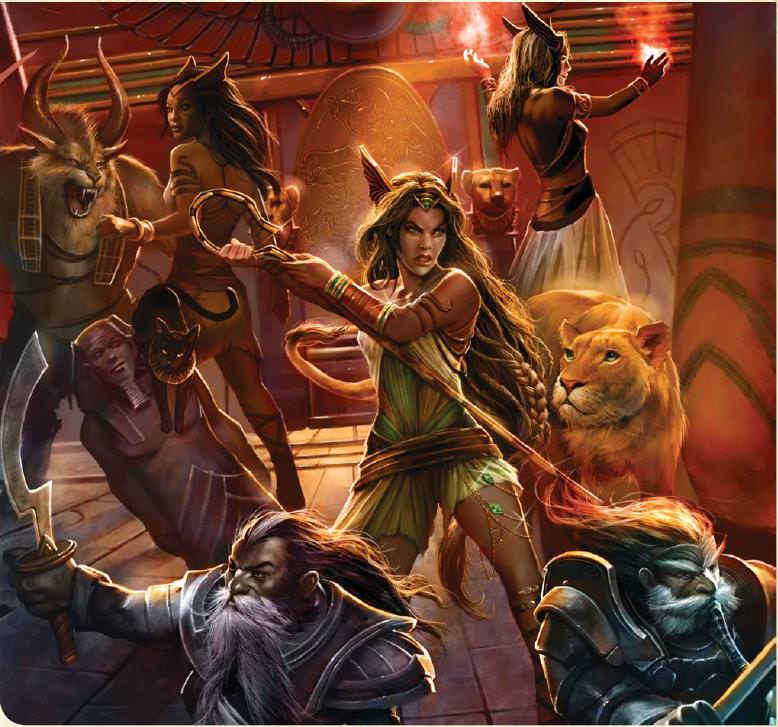
Interestingly Bastet gets a host of new material in this chapter, unlike any other deity: four and a half pages worth of new spells, domains, and magic items!
The three new domains include the following: the Cat domain which grant Acrobatics and Stealth as class skills, a per-day use to grant a bonus to a touched target’s agility-related abilities (AC, ranged attack rolls, Dex based skills, checks, and Reflex saves) equal to half your cleric level, as well as the ability to shapechange into a feline monster at 6th level. The domain spells include presence and animal-themed magic. The Perfume Subdomain is keyed to the Charm domain and trades in the 8th level power to instead cast Allure Senses (new spell) as a swift action against a single target, along with replacing the charm person and heroism domain spells with allure senses and rainbow pattern respectively. Overall, it is a worthy replacement; although charm person has more utility, the allure senses spell imposes the fascinate debuff on a target and can be more useful in combat situations.
Finally the Predation subdomain is keyed to the Animal domain, replacing the speak with animals power with Silent Hunter which is a per-day ability that grants you a bonus equal to half your cleric level on any single melee attack you make when you begin a turn using the Stealth skill. It replaces hold animal, dominate animal, and beast shape III spells with bull’s strength, blood scent, and summon huntress (new spell) respectively. By a literal reading, the domain merely states that you need to use the Stealth skill rather than it being successful or not, so this can be a very good option for more martial clerics.
Our six new spells are associated with Bastet, but are capable of being learned by worshipers of other deities. The text notes that this would be a case of parallel magical research akin to how various cultures around the real world independently invented the bow and arrow.
The spells include Allure Senses, a 1st-level AoE cone which fascinates affected enemies with rainbow auras and hypnotic words; the 0-level Clowder of Cats which signals up to nine non-magical common cats within a wide range to come to your presence; the 2nd-level Feline Gaze which allows you to see through the eyes and hear through the ears of a cat; 1st-level Gnolls’ Ally with is a 50 foot AoE burst which makes you appear more gnoll-like and grants a +5 Diplomacy check on all gnolls within the area; the 4th-level Kitten to Lioness which temporarily transforms at least 9 mundane cats within range into a celestial or fiendish dire lion; and finally the 5th-level Summon Huntress, which summons a female dire tiger immune to mind-affecting spells to your side to pursue and retrieve a specific creature of Small or smaller size of 6 HD or less.
Allure Senses is perhaps the most versatile of the spells; most are rather situational or can be replicated by other existing spells in the Paizo rulebooks.
Our five magic items include the Cat’s Claw Pendant which grants the wearer natural claw attacks and the rend monster ability; the Mask of Hisses and Purrs which grant you a +3 to Diplomacy or Intimidate checks depending on your catlike expression, but makes you inadvertently mew and meow while speaking and thus imposes a 10% chance of failing to cast spells with verbal components; the Ring of Cat Folk which can let the wearer transform into a tiny black house cat for up to 8 minutes per day; the Ring of Lion Form which allows the wearer to transform into a large black-furred lion up to 11 minutes per day and can emit a damaging deafening roar in an AoE cone in any form; and finally the Statue of Nine Lives, a unique artifact with nine charges capable of reviving a wear from fatal harm, but at the cost of becoming more feline in demeanor and shape. This comes complete with game effects both positive and negative for the progression.
Horus is the regal warrior-god of the Nurian pantheon. He encourages his followers to dispense justice and defend the nation from demons, Mharoti incursions, and other maladies. His holy book, the Code of Horus, was the legal foundation upon which the River Kingdom was built. His worshipers also include Tamasheq nomads, heru ravenfolk, and harpy priestesses managing his most famous temple, Khepri Khnum.
Ninkash is the dwarven goddess of beer, and has followers beyond Nuria Natal including the dwarves and Romani-like Kariv humans of the North. She can impart guidance through drunken visions. Her matronly attitude means that many of her holidays are joyous festivals and social occasions.
Thoth-Hermes is the god of knowledge and has a following among scribes, thieves, wizards, and travelers. His priests view libraries as temples to their god in spirit, and to that end all books are holy books of Thoth no matter the subject. To burn or desecrate the written word is a great sin among his followers. He also was the deity to teach mortals the secrets of hieroglyphic magic and is patron of Nurian theurges who utilize both arcane and divine spells.
Gods of the Desert Lands
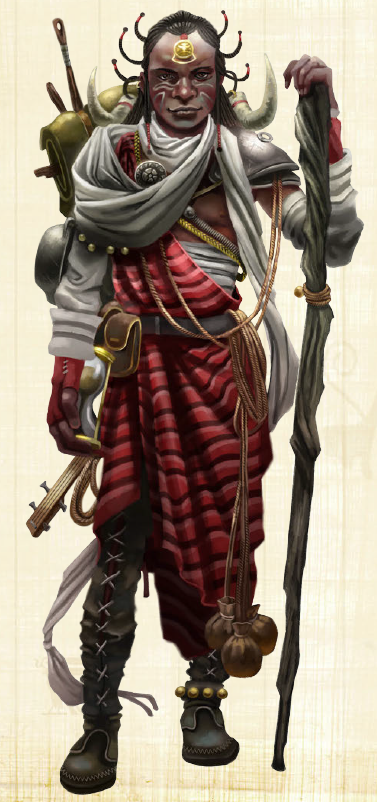
The gods of the burning sands and badlands are beings of extremes. Some such as Kwansi are tricksters, while others grant the faithful the ability to find safe havens and see through mirages and other deceptions.
Kwansi is a spider god whose chaotic nature means that he wears many masks and roles. He is a constant thorn in the side of tyrants and oppressors of all kinds, encouraging the downtrodden to revolt and inspires hope with laughter and optimism. One of Kwansi’s masks is the iconic African folkloric spider Anansi.
Kwansi also comes with a new Vermin subdomain, which is keyed to the Animal domain. It replaces the speak with animals power with Vermin Sanctuary, which can force a hostile vermin to stop attacking you on a failed Will save. Its domain spells include various swarm and bug-related abilities. We also get a new 4th level spell, Greater Summon Swarm, which can summon more powerful vermin such as centipedes, crabs, scorpions, wasps, or death butterflies (a new creature from the Midgard Bestiary).
Mbanu is a dwarven god of labor, the forge, and law and justice. He counts blacksmiths and artisans along with judges and officers among his ranks. The god is known as a dependable and honorable man whose inventions and leadership bring security and prosperity to communities. He is worshiped among the Narumbeki as well as the dwarves.
Sabateus is a mysterious figured, clad in deep blue djebella* designed with sparkling stars. He is worshiped at night when the stars and the moon can be seen in full, representing the guiding light of knowledge of ancient mysteries and forgotten eras. Lamia worship Sabateus as the Moon’s husband, and he is often associated with arcane magic.
*apparently a misspelling of Djellaba, a Morroccan garment.
Takhar Takhar is a god of war, worshiped by many cultures beyond the desert. He is popular among the Narumbeki Legions, the gravebinders of Siwal, and the Tamasheq nomads; even some gnolls and dwarves honor him. He represents the Lawful unity of battle, and his followers are opposed to all of the Dark Gods and focus just as much on raising morale and defending the wounded as straightforward offensive assaults.
Yemaja of the Waters is perhaps the most popular goddess of the inhabitants of arid lands. She was also originally known as the Keeper of Time, only for the title to be stolen by her husband who is said to be either the dragon-god Seggotan or the sea-god Nethus depending on the culture. She was worshiped in the northern kingdoms as the siren Mnemosyne.
In the Southlands, Yemaja is worshiped as a protector of women and children as well as a patron of water, rivers, and the oases of the desert which symbolize hope to the lost and parched. She has major temples in Shibai, Cindass, Narumbeki, and even Lignas. Oddly enough, the worshipers of Sabateus despise her even though the two gods are on great terms with each other.
Gods of the Green Lands
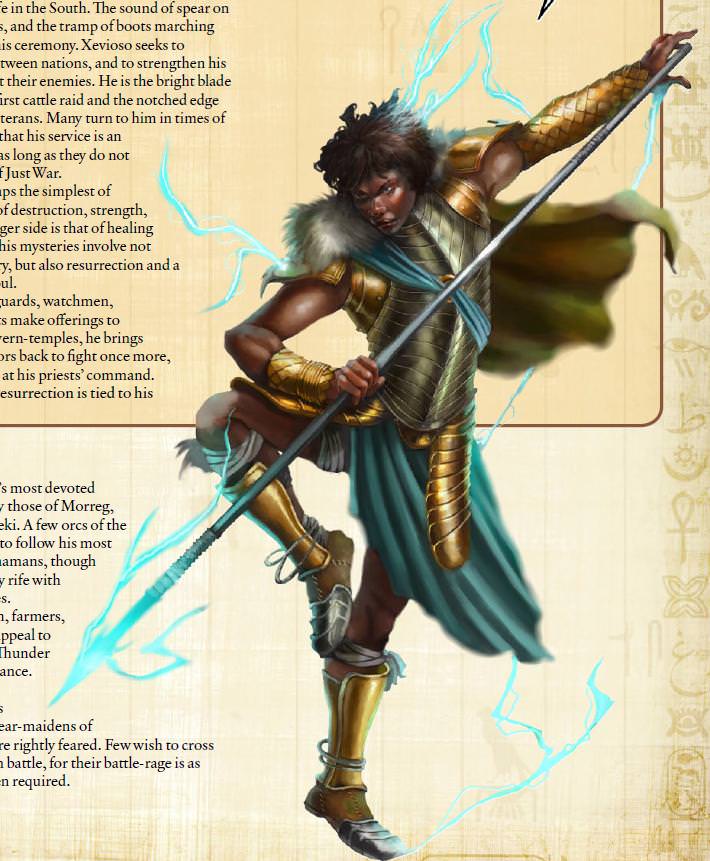
The gods of the fertile savannah and jungles of the Southlands are so named for their connection to the living things of the world. They technically number three: Ogun, Xevioso, and Yemaja, although the deities Ptah and the World Serpent Veles are counted among their number. Ptah because he and his followers are living in exile from Nuria Natal after the rise of Aten, and the World-Serpent for his connection to the lizardfolk kingdom of Veles-Sa and his repository of earthly wisdom.
Ogun is an ideal warrior who also covers metalworking and smithing, leading more than a few to associate him as a mask of Mbanu or vice versa. He is associated with keys, for his dominion over jailers and justices as well as his skill in unlocking any doors. His priesthood and worshipers hew heavily male in membership, and the Fire Legion of the Narumbeki and the prison wardens of Lignas’ Coil of Memory revere him.
Ptah is a dwarven god of architecture who was burned to death by Aten and reborn in the mountains of Sebbek Sobor. His is a humorless god without much cause for frivolities, and it is said that only his first wife Ninkash can coax a smile out of him. He is associated with helping build some of the greatest pyramids and tombs of the god-kings and is a maker of everything from weapons to mills and barges. In part due to persecution at the hands of Aten, his priests are meager, wishing for their faith to speak through their creations and charitable endeavors rather than elaborate festivals and grand temples. Many outsiders presume that Ptah and Mbanu are masks of each other due to overlapping portfolios, although dwarves view this as a ridiculous fantasy.
The World Serpent goes by many names. He is known as Veles in the Mharoti Empire, Djyy (pronounced “DID-zhah”) in Lignas, Ouroboros in the Western Sea, and Jörmungandr in the Northlands. But in all tales he is the grand god whose form encircles the world of Midgard, biting his own tail to keep the oceans’ waters contained. Some sailors claim to have seen his mossy green mountain-sized scales at the farthest reaches of the world. The World-Serpent cares little for the afterlife, instead encouraging his followers to attend to worldly affairs and safeguard the ley lines from corruption. His faith is rather nihilistic, focused on the inevitable end of all things and the paltry lives of mortals.
Xevioso is an agile god of war and thunder, encouraging battle and strife for its own sake. Many offer prayers to him when the time to spill blood has come, whether out of a personal vendetta or for loftier ideals. His temples are secluded in caverns where his priests stand ready to resurrect his greatest warriors, and in northern lands shield-maidens are associated with his masks. Xevioso is thought to be a mask of Perun, Thor, or Mavros in said lands, and his priesthood is 80% male much like that of Mavros (detailed in Midgard Worldbook).
Xevioso has a new Speed domain, which has a per-day ability to grant an enhancement bonus of ranged attacks, combat maneuvers, and Dexterity-based skills, saves, and ability checks equal to half your cleric level as well as a 10 foot increase to the target’s base speed. The domain’s 8th level ability, Quickness of the Gods, adds the cleric’s class level to their Dexterity score for a number of rounds per day equal to their class level, but only applies to Dexterity ability and skill checks (no radical AC bonus for you!). Its domain spells include agility and time-based magic such as haste, call lightning storm, ethereal jaunt, and time stop. A new 8th level spell is also included, Speed of Thought: the spell grants greatly heightened speed to one target per level, allowing them to make 3 extra attacks as part of a full attack, a +4 bonus on attack rolls, AC, and Reflex saves, can cast full-round and standard action spells as standard and swift actions respectively, and finally increases all modes of movement by 60 feet.
Speed of Thought is basically a mega-haste and thus super-powerful in regards to action economy. The extra attacks and shortened casting times make it a must-have for just about any character.
Yemaja of the Waters is also worshiped here. Although half of her domains are different reflecting altered cultures. In her desert entry she had Life, Knowledge, Protection, Song, and Water. In the Green Lands she switches out Life and Protection for the Birth and Time domains. Said Song and Time domains are in another Midgard book, Journeys to the West.
Gods of the Corsair Coast
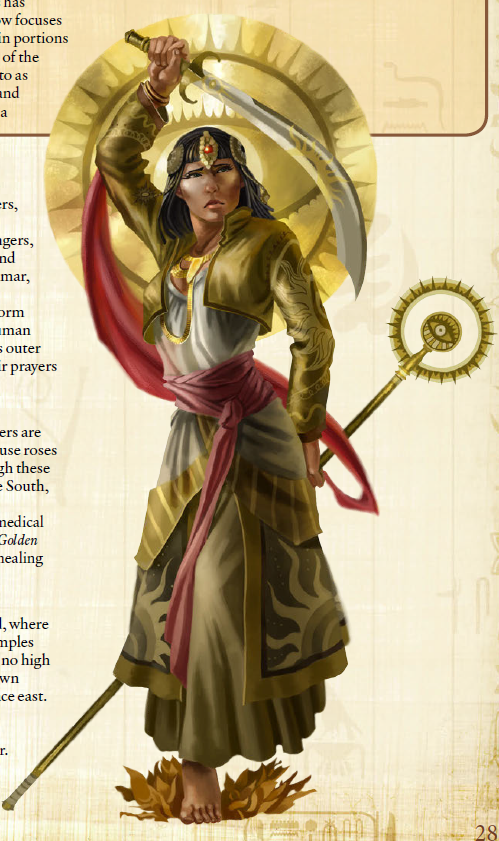
The faiths of the Corsair Coast are younger and less stable than the ones of its neighbors, for the seaside settlements are home to people and faiths from gods of many places. It is also one of the few regions where goddesses hold greater sway than gods, and some assume this is related to the high amount of slaves and thralls in the region’s mines and farms.** Others presume the seafaring cultures are a friendlier atmosphere to the goddesses of water, sun, and community.
Eshu is the only deity known to originate from the Corsair Coast. He is a chaotic trickster god of travelers and wizards, carrying news and tales between villages and tribes, and his worshipers include all those who make a living off of traveling the roads. He has no holy books, his teachings are carried via oral lore, and his shrines are either mobile tents or small permanent structures built around red sacred stones. He is assumed to be the mask of many other gods, especially Kwansi and Thoth-Hermes. Some claim he is either the mask or resurrected form of a long-dead Nurian god by the name of Osiris.
Ninkash has the same domains in the Corsair Coast as she does Nuria Natal: Beer, Charm, Community, Liberation, and Strength
Isis is a goddess of Nurian origin who is associated with healing, love, and mercy. In fact, quite a bit of her text and even her portrait are the same as the goddess Lada from the Midgard Worldbook because said deity is one of her masks. She takes the form of a woman of various races depending on local followers, and her temples face east on high ground such as hills and mountaintops to greet the rising sun. Her personality and portfolio means that she has few enemies save the Dark Gods and those of war such as Takhar and Xevioso. Even the priesthood of Aten treat Isis as the offspring of their sole deity, but still regard her followers as deluded rather than actively wicked.
Sabateus has the Travel domain rather than Void here (his original domains being Darkness, Magic, Moon, and Transformation).
Yemaja has Birth, Knowledge, Protection, Song and Water domains among the Coast’s worshipers.
Dark Gods of the South
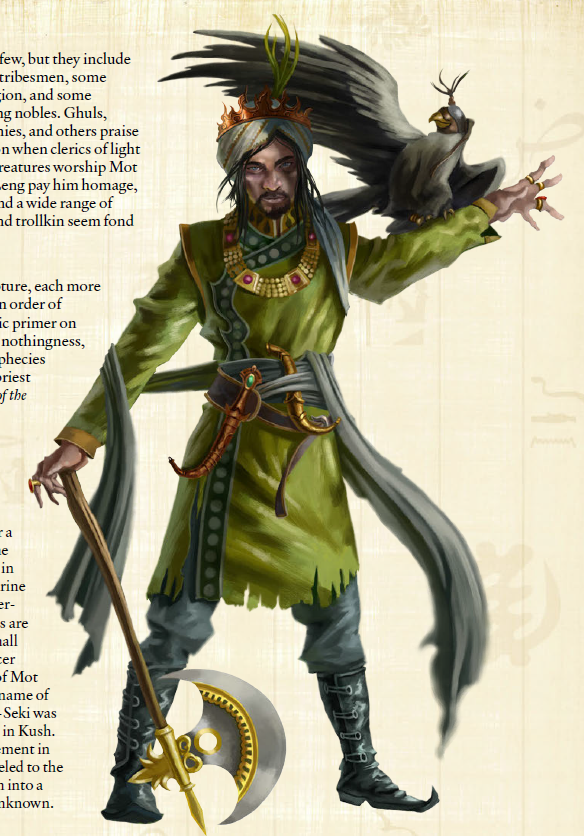
The Dark Gods are associated with evil and other blighted things by mainstream society. But a few specifically champion the downtrodden and voiceless who the other gods shun, although this is not always done out of charity or liberation. The Dark Gods are not associated with any one region; rather, they are a catch-all term for the Southlands’ “evil pantheon” although only 6 out of 9 are of this alignment. Baal-Hotep is Lawful, while Selket and Set are Chaotic. These three are grouped among the Dark Gods due to their hostile nature with most Southlands civilizations.
Note: the Midgard Worldbook went into more detail regarding the specific status of the Dark Gods. One, they were not true divinities so much as those whose power grew smaller to the point that they were “demoted” to archfiends. Thus they crave mortal souls and sacrifice as a means of rebuilding their power base. They were also jealous gods and much like Aten they demanded that their followers worship them exclusively (Baal-Hotep being an exception).
Aposis is an eternally-hungry enormous serpent seeking the world’s destruction. He is associated with many apocalyptic prophecies, and most of his priests assume he is a dark mask of Veles the World Serpent. His worshipers seek to bring about the end times and in so doing commit acts of violence to make the world an ever more worse place.
Baal-Hotep is known as Baal in the Mharoti Empire, but in Nuria Natal and the Corsair Coast he is associated with war, rage, and fire. Among the dragonkin and kobolds he is associated with laws and public service, his priests reciting his teachings orally and commit his 444 sacred stories to memory.
The Hunter goes by countless names and wears an equally uncountable number of forms, although his worshipers claim that their god wears no masks. He is the cruelty of nature made manifest, of Darwinian tooth and claw where all that lives must kill to survive. Bandits, raiders, monsters, enraptured fey, and decadent nobles seeking to hunt their fellow men and women are counted among the Hunter’s priesthood.
Mot is a being of nothingness and death, a god of endings in all forms. From drought-plagued fields to the genocide of nations and bloodlines, Mot waits for all on a black throne near the River Styx. His treasury is rumored to contain all the wealth of the dead who fall into his hands. Many intelligent undead and some among Narumeki’s Fire Legion worship him, as do stranger beings such as the orcs of the Green Abyss and the Denizens of Leng. In Nuria Natal his priests share a strange common camaraderie with other inhabitants of the River Kingdom, for his faithful despise Baal and go out of their way to attack his legions.
Nakresh originated among worshipers of the eastern realms. He is a monkey-demon whose bottomless avarice encourages him to steal and deceive others. His six to eight hands clutch many items, but one is always empty symbolizing his never-ending grasp for more. Thieves, slavers, tomb-robbers, and those desperate for wealth make offerings to him. The headquarters of his priesthood is a well-defended hidden fortress somewhere below Nuria Natal’s capital city. His priesthood acts much like a thieves’ guild and is led by a conclave of his greatest worshipers known as the Five.
Nkishi was known as being more benevolent during the era of the Carnidine Kingdom, but after that civilization fell something changed. Laughing Nkishi’s smiles grew bitter and his patience ran thin, quarreling with other deities over all manner of things. Now he is a cruel god who encourages violence and is a favored deity among many gnoll tribes. He does not view other gods and goddesses as actual deities, but rather as evil spirits whose influence must be purged. His priests engage in bloody battle against other races as well as their own who are perceived to be weak or who integrated into other civilizations (such as Nuria Natal or the Mharoti Empire). In the latter case they offer captured gnolls the choice of offering up their religious leaders for execution and turn to Nkishi’s faith, or be hunted and slaughtered like beasts of the wilds.
Selket is a goddess of contrasts. Worshiped among Tamasheq nomads and Lignans, she is simultaneously a patron of healing and protection as well as poison and vengeance. Her devotees guard the faithful and act via assassinations and charmed animals to bring death to those who oppose her and harm her followers. Her cult has become more aggressive in recent years, striking out at merchants in Per-Kush cheating Tamasheq nomads, driving domesticated animals mad among Nurian River settlements, and even poisoning cats in Per-Bastet.
Set is the rival of Horus, a former contender for the title of Protector of Nuria Natal before the falcon-headed god claimed it from him. Set is a self-styled defender of peasants, farmers, and the oppressed, protecting villagers from crocodiles and lions, his priests bringing medicines to the ill and dying, and casting illusions to help commoners shelter crops and bread from Nurian armies seeking the plunder as tax. He is also a patron deity of revolutionaries and usurpers, which puts him at odds with established government. He does not trust many gods, viewing many as arrogant bullies. He makes an exception for Bastet who is his sometimes hunting companion, Isis who he admires for her charity, and Selket’s role as a vengeful protector. He is also Yemaja’s husband.
The White Goddess was birthed from the skin of the world, and just as soon became the enemy of the sun god: Aten, Horus, or Mbantu depending on the mask and culture. She stared him down, chasing him to the ends of the horizon and reaping a path of destruction among the surface races in her wake. Her primary worshipers are orcs, a small and failing race in Midgard confined to the dark and remote corners of the world. They build altars, armor, and weapons from the bones of her enemies, and solar eclipses are her holiest days where her orc followers rise from their lairs to raid and slaughter.
Cults and Sects of the Southlands
Beyond the major deities are thousands of lesser outsiders and semi-divine creatures who gather their own following of worshipers. Even in these cases real actual power can be granted to faithful who bond themselves to said beings, and this is expressed in a new series of Cult Feats. The more bonded worshipers such an outsider has, the more powerful they get. 20 sworn and bound worshipers with the Outsider Bond feat grant the false god the advanced template. Every 500 additional worshipers beyond this amount grants the outsider one bonus hit die, to a maximum of 5,020 worshipers for 10 bonus hit die.
Feats with the [Cult] descriptor cannot be retrained or replaced until the magical being associated with the feat either dies or releases the character from service. Those who attempt to leave without permission gain a penalty on skill checks equal to the number of [Cult] feats they possess until a restoration spell is cast on them by a fellow cultist.
The three [Cult] feats include the following: the base Outsider Bond feat, which grants the worshiper use of one of the outsider’s spell-like abilities of 2nd level or lower or a +2 sacred/profane bonus to AC a number of rounds per day if the outsider has no spell-like abilities. Dedicated Follower increases the amount of times this SLA can be used or the AC bonus to +3. Unflagging Conviction allows the cultist to roll a saving throw twice and take the better result by sacrificing two uses of the SLA/AC ability.
Additionally, any character with [Cult] feats gains a negative level if the Outsider they pledged loyalty to dies; if this negative level would kill them, they rise as an undead monster known as a shadow.
Infinite Variety is a related [Monster] feat, only able to be taken by monsters with the Outsider type. It grants the creature a new spell-like ability of a level equal to or less than their highest existing SLA, or a level equal to half its Hit Dice minus 1 whichever is lower. They can use this ability a number of times per day equal to 1 + their Charisma modifier (minimum once), and can be accessed by worshipers via the Outsider Bond feat.
After this chapter we get two appendices consolidating all of the equipment and feats of the Southlands and their page numbers.
Thoughts So Far: The pantheons of gods and goddesses are quite cool, and it’s nice to see more variety than the iconic Egyptian pantheon, I do not know how many of the non-Egyptian deities are from real folklore versus creations of Kobold Press, but I managed to find a few such as the Sumerian Baal, the West African Anansi/Kwansi, and the Yoruban Yemaja.
The Cult feats are cool and thematic, as well as being good options for both religious PCs and the prototypical evil cults. The new spells, domains, and magic items did not really wow me.
**One thing I wanted to touch on was the implied gender roles of the Southlands and how it tied in to divinities. In my review of the Midgard Worldbook I mentioned how the setting overall has an implied patriarchal world due to several world-building elements. They included things which were individual entries of social institutions and organizations, but when read together created a larger picture. The Southlands overall is more subdued in comparison, and the only times we see gender relations referenced is when a few societies or orders are explicitly called out as being matriarchal: gnoll and nkosi tribes, Terrotu and Lignas’ succession rules, and Bastet’s priesthood come to mind. Which makes the association of goddesses with slaves and the oppressed in the Corsair Coast rather strange, in that the region chapter earlier did not paint it as a place where women are a subjugated underclass.
Concluding Thoughts: Southlands puts a fresh and unique spin on the mythology and folklore of a criminally underutilized continent. Its vibrant Fantasy Africa setting is something you don’t see often in the D&D/Pathfinder fandom beyond the typical “vine-choked ruins.” While the setting has more than a few such places, there is enough variety in national and cultural groups to avoid becoming one-note and stereotypical. It has lots of strong, worthwhile game mechanics and adventuring hooks in every chapter, and I can see myself running multiple campaigns in this world without coming close to exhausting its material.
In conclusion the Southlands is a worthwhile addition to the already fantastic setting of Midgard and, good enough to be played as its own self-contained setting or transplanted onto another world of your choice with some adjustments. Kobold Press knocked this one out of the park, and I look forward to seeing what other lands and worlds they develop in the future!